What To Do With All Your Stuff When You Travel: The Ultimate Guide To Pre-Trip Decluttering

“The things you own end up owning you. It’s only after you lose everything that you’re free to do anything”.
– Chuck Palahniuk
You’ve saved up loads of money. You’ve procured the necessary visa(s), booked your flight, obtained your international driver permit, bought a travel insurance policy and put all the other necessary ducks in a row.
You’ve been meticulously planning your big upcoming trip over the past few months and everything is now arranged.
This is not just another typical vacation or fleeting getaway to a foreign land. This time you plan to really hit the road for a serious length of time and you’re not sure when, or even if, you’re coming back.
You reckon you’ll be travelling for at least a few months, maybe even a couple years.
But despite virtually everything finally being in order for you to make your great escape, you’re not quite yet ready to leave. Some invisible chains are still holding you back. What’s stopping you from breaking free?
Well, it’s all that stuff you still own of course, and right now you don’t have a clue what you’re going to do with it.
Of course, all this accumulated clutter never caused a problem for you whenever you went on holidays in the past, since you could just leave it locked up in your home while you were away.
But this upcoming trip of a lifetime is not a typical vacation where you can just do what you've always done before.
This time you’ll probably be selling your property or coming to the end of a rental contract, and all that stuff you’ve accrued over the years has to go somewhere and be dealt with.
And obviously, you can’t take all of it with you.
Hell, even if you could somehow schlep it all around with you, you wouldn’t want to anyway.
Part of the joy of setting off on a big voyage is the opportunity it affords to finally liberate yourself from all that stuff you own, the chance to, at long last, bid adieu to all of the trappings of settled life.
So the question that must surely be on your mind is: what on earth am I supposed to do with all my stuff before I hit the road?
Well don’t worry because we’ve got you completely covered in this comprehensive guide to dealing with all of that stuff that you've amassed over the years. Let's get started.

Bring, keep, sell, donate, rent or recycle/dump?
You generally have six options for what to do with each item or piece of property that you own; bring it, keep it, rent it, sell it, donate it, rent it or recycle/dump it.
There are a number of different factors that will dictate the best option to choose for each item that you own.
We’ll explore the six options below and point out the circumstances in which each option makes the most sense, so that you’ll no longer be confused as to what should be done with what.
Option #1 - Bring It
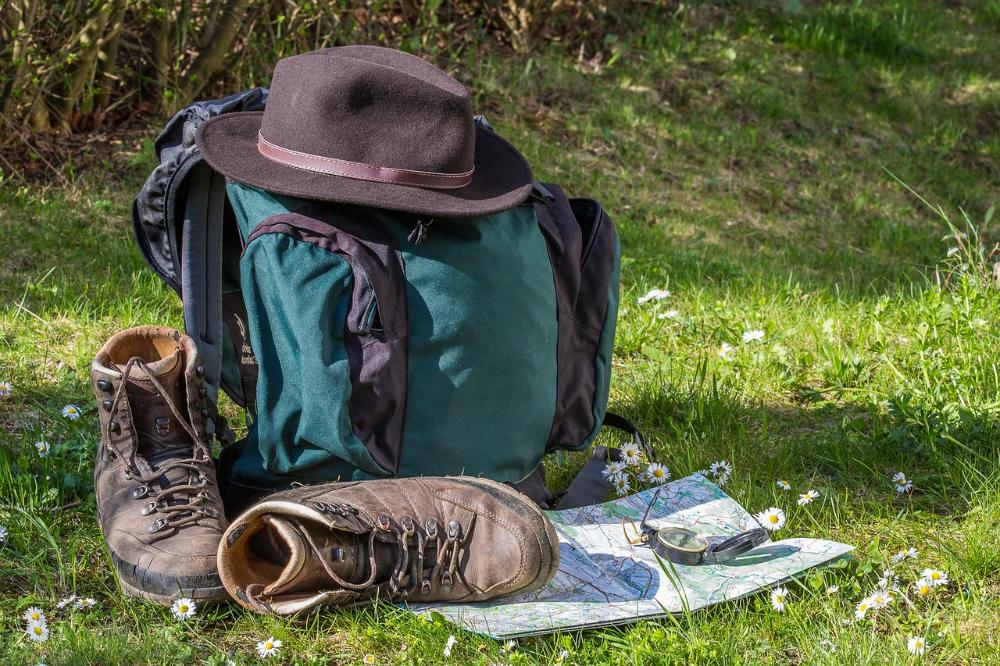
The first step of this entire process is to decide what items you're going to bring with you on your trip. Once you've isolated these items from all the others, you can then more easily deal with everything else.
The truth is that only a very small subset of all the things that you own will have any rightful place in your new life as a traveller.
Unfortunately, most people don't understand this the first time and they inevitably overpack, but for the sake of your financial solvency, mobility and pleasure on the road, it’s crucial that you don’t make this mistake too.
Be sure to only include items that you genuinely will need and that would improve your quality of life on the road to a sufficient degree that they’re worth the weight burden and the space they occupy in your pack.
It goes without saying then that only the most portable and multi-functional possessions that you own should be taken with you on the road.
I have found that travelling as a minimalist backpacker, where I carry all of my belongings inside a small, 30 - 40 Litre, carry-on compliant backpack, has afforded me the utmost joy and sense of freedom on my travels, as well as having saved me hundreds of dollars in checked baggage fees over the years.
Your packing list will be different to mine, since your travel needs and priorities will not be identical to mine, but it might be helpful for you if I list the items I usually travel with, as a reference point.
In my backpack I only carry the bare essentials, which comprise:
- a few articles of clothing and pairs of underwear
- a compact DSLR camera & extra zoom lens
- a lightweight tripod
- an ultrabook laptop
- a pair of binoculars (mostly used for birdwatching)
- two external hard drives (for backing up all my documents, photos and videos)
- one or two plug adapters (plug types vary around the world)
- chargers and cables for my laptop, camera, cell phone etc.
- a USB flash drive
- a USB card reader
- a power bank
- a portable water purifier
- a stainless steel camping cook pot
- a headlamp (and spare batteries)
- an electric water heater (immersion rod)
- mosquito repellent cream
- a beard trimmer
- a nail clippers
- a toothbrush
- a smartphone
- a money clip
- a compass
- a few other miscellaneous items.
Jewellery items like necklaces, earrings, bracelets, anklets, bangles and rings are also very portable and easy to bring with you when you hit the road, since you can just wear them on your body, ideally concealed underneath your clothes.
However if you decide to travel with valuable jewellery on your person, please watch out for thieves that specialize in snatching necklaces , wedding rings and other pieces of jewellery off people’s bodies.
For further guidance on what items to pack for your trip and why they're necessary you should definitely check out my more detailed carry-on packing list for men.
I also recommend you have a read of my article on how to pack like a minimalist, which covers the necessary mindsets, principles and packing techniques that make it possible to travel indefinitely with just a carry-on sized bag.
Option #2 - Keep It
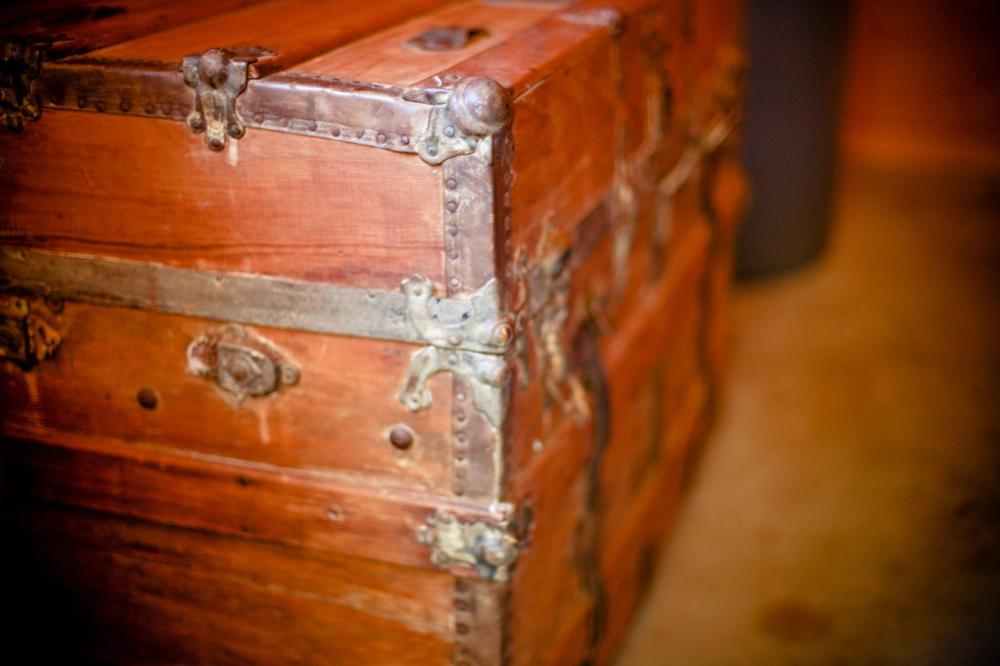
After you’ve decided what to bring with you on your trip, the next step is to decide if there’s anything you own that would be worth keeping in storage while you’re gone.
The first thing you need to understand about keeping things is that there’s normally some kind of a cost for doing so. However, there’s also a cost for not keeping things.
The cost for not keeping things is not exacted immediately, but in the distant future when your trip finally ends (unless it turns out to be one of those exceedingly rare, never-ending trips), you return to settled life, and you find yourself having to replace many of items that you decided to get rid of before hitting the road.
There’s both a financial and a time cost involved here, although if you sell the items before leaving and buy them back second-hand upon your return you might not lose very much money.
The cost to keeping things is the price you might have to pay for renting a self-storage unit, or if you have your own property to keep stuff in there's the cost of upkeep of that property while you're away.
In the case where you have access to free storage you may have to deal with a passive-aggressive friend or family member, who resents the fact that a sizeable portion of their personal space is being usurped by your personal belongings.
For many people the financial or emotional cost of keeping things in storage outweighs the inconvenience of having to replace things in a few years time, and hence they’ll try to get rid of as much stuff as they can before leaving.
That said, it might still be worth holding onto some of your belongings, even if you have to rent long-term storage to keep the items safe and sound.
Bear in mind that any items that appreciate in value could help to offset the costs of storage and of course, if you can procure free storage, you can be far less ruthless about purging yourself of your physical possessions.
So what kinds of items might be worth keeping?
Well, any objects of high sentimental value like family heirlooms, gifts from deceased family members or family photographs definitely deserve your consideration for storage, as these are things that you might just find it too difficult to part with.
Such items tend to be small and few in number so you may be able to leave them with a trusted friend or relative without burdening them.
Certain other items might be worth holding onto because of the possible fortune they might be worth in the future if they appreciate in value.
The number of items you own that could appreciate in value over time might surprise you. Items that often appreciate over time include:
- certain varieties of wine, whiskey and other spirits.
- paintings and other works of art from well-known artists.
- vintage baseball, basketball and hockey cards.
- vintage comic books.
- rare stamps.
- old coins.
- movie collectibles and memorabilia (especially Star Wars merchandise).
Did you know that many rare collectible items have sold for tens of thousands or even millions of dollars?
Certain books can also become extremely valuable over time, especially if you own the first edition of a classic book, preferably signed by the author.
A copy of John James Audubon’s “Birds of America” sold for approximately $2.5 million in 2010, although this was supposedly the most expensive book ever sold. Rare journals and diaries can also sell for thousands.
Even if you think none of your books will be worth much in the future, you might want to hold onto them anyway, especially if you’re the type of person that considers knowledge to be priceless. The problem with books however, is that you will need a lot of space to store them.
To solve the space issue, you could always try to obtain e-book copies of all your physical books if you decide the hard copies aren’t worth the trouble or expense of keeping.
If you own any gold, silver, copper or other commodities you might want to keep them in storage too, as your holdings would be expected to increase in value over time due to the limited supply of these metals and the ever-expanding global population.
Even certain cars can appreciate in value over time, although most will depreciate. But if you’re fortunate enough to own one of the car models that experts predict will appreciate in value, you might want to hold onto your car while you’re away. Otherwise, you can sell your car via Craigslist or if you’re strapped for time you can use a business such asJunk That Car to sell it.
If you can avoid the expense of storage, the other items you might want to hold onto are the ones that you would need to replace immediately upon your return (if you plan to return).
Where to keep your stuff while you're away?
Once you've decided what items you're going to hold onto (if any), the next task is to figure out where you’re going to store these items while you’re gone. Here are your options.
Keep your stuff at your own property

If you own a property in your native country and you aren’t planning on selling it, then you could potentially keep your stuff there and keep the place locked up for a very long time.
Since many of the items you’re keeping are likely to be worth quite a bit to you, and since a property that’s vacant for months or years is a prime target for burglars, you should keep the most valuable items, such as jewellery and important documents, locked up inside a home safe like the Amazon Basics Security Safe while you’re gone.
You should also take various measures to deter burglars from trying to break into your home in the first place. Here are some measures you can take to (hopefully) discourage thieves:
- Make sure not to leave any cardboard boxes or other packaging from expensive goods like flatscreen T.Vs, desktop computers, stereo systems, cameras, gaming consoles etc. in your garbage bin or outside your home. Burglars often use this evidence to identify a home as a lucrative target.
- Ask your neighbor to keep an eye on the house while you’re away and to regularly retrieve flyers and mail from your porch or mailbox, so that it doesn’t look like nobody’s home. You can also re-route your mail to a virtual mailbox provider, which is something we've written about in this article.
- Make sure that no T.Vs, gaming consoles, computers or other valuable goods are visible through any of your windows.
- Make it obvious that you have a home security system by putting up a sign that clearly states it, i.e “this property is monitored by 24-hour video surveillance”. Even if you don’t actually have security cameras or a ferocious guard dog, a warning sign will still act as a deterrent.
- Employ someone you trust to cut your grass every once in a while while you’re away so that it’s not glaringly obvious that you’re on a very long vacation.
- Before you leave, trim back or remove any tall bushes or vegetation bordering your house to eliminate cover that burglars could use to conceal themselves from view when trying to break in.
- Install motion-triggered outdoor security lights at the main entry points of your home to expose and startle burglars trying to break in at night.
- Install smart light bulbs inside your home that you can program to come on automatically between certain hours in the evenings, making it look like somebody is home.
- Keep your forthcoming trip on the down low on social media and elsewhere, and be careful about letting strangers into your house to take surveys, even if they claim to be collecting confidential data on behalf of the Government.
Another option that lets you keep a lot of your stuff at your home is to keep the place fully furnished and rent it out to a tenant while you’re away.
You could also hire a housesitter to look after the property for you, as its not all that uncommon for sitters to accept long-term positions for 1 year or more.
The only drawback with these approaches is that you’ll still probably need somewhere to store your private or personal stuff, and you can never fully trust that a tenant or housesitter will be responsible and won’t damage or steal things.
Keep your stuff at a trusted friend or relative's property
If you don’t have a property of your own and you only have a small amount of stuff to put into storage, leaving your things with a trusted friend or relative is probably your best option (since it’s free), as long as it’s viable.
Maybe you have a close friend who’d be willing to help you out, or if parents are still alive, maybe they’d let you stash some things at their pad.
It may even be safer to leave your belongings with your folks than it would be to leave them in your own vacant property, although elderly people are also more likely to be targeted by burglars.
The main issue with this strategy is that other people often have less free space in their homes than you’d imagine (everybody seems to be stuffocated to the max in today’s world) and people can start to get irritated with you if your belongings linger in their home occupying space for too long.
Rent out a self-storage unit
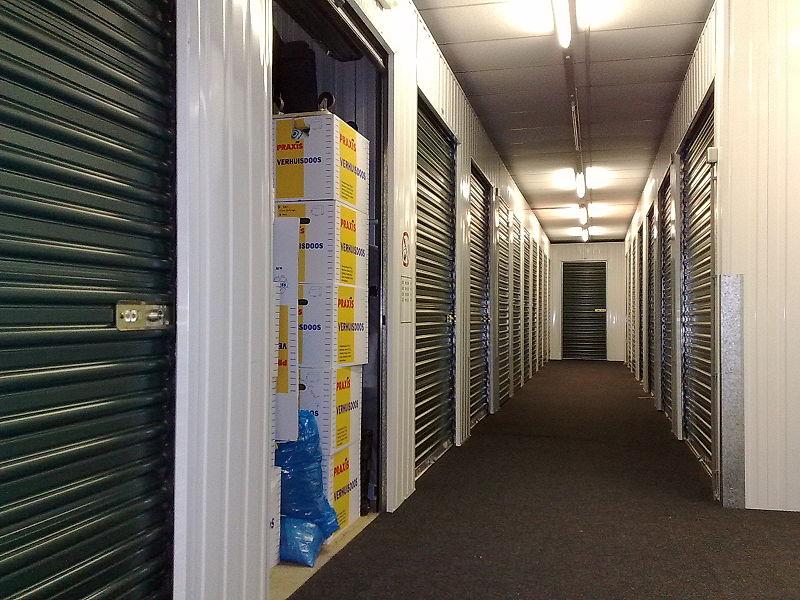
The self-storage industry exists in many countries worldwide but is particularly prominent in the United States, where 1 in 10 people rent a self-storage unit.
The country is estimated to have somewhere between 44,000 and 52,000 self-storage facilities in total, which provide 2.3 billion square feet of storage space in total.
To put this number into a global context, all of Europe and Australia combined have fewer than 4,000 self-storage facilities.
The prominence of the industry in the U.S is largely due to its culture of material excess where people’s homes are literally overflowing with unnecessary stuff, forcing them to seek additional storage space.
If free storage just isn’t an option for you, renting out a self-storage unit long-term might your only choice, although you will definitely want to avoid resorting to this option if you can help it.
A rented self-storage unit will be a liability for you when you travel, draining money out of your travel fund on a regular basis, which is obviously undesirable.
Even a small 10” x 5” self-storage unit in the U.S. could cost you north of $75 a month and the more stuff you have, the bigger the unit you’ll need and the more it’s going to cost you, so think twice about how much stuff you decide to keep.
If you have no choice but to rent a self-storage unit while you’re travelling there are a few things you need to know about them.
Self-storage units are usually windowless rooms with corrugated roll-up doors (or ordinary hinged doors) that come in a wide variety of sizes, with some of the most popular sizes being 10” x 5”, 10” x 10”, 10” x 20”, 15” x 20” and 20” x 20”.
The price increases with size with the exact price depending on where you live (New York is the most expensive area for self-storage) and the company you go with.
But as a rough guide, units that are 10 x 20 or larger will usually cost more than $150 a month, so try to rent the smallest unit possible. See also this excellent guide to self-storage unit costs in the U.S.
Generally, you’ll secure your storage unit with your own lock and key and employees of the facility won’t have access to your items.
Speaking of items, there will almost certainly be some restrictions on the kinds of things that you can keep in your storage unit.
You probably won’t be permitted to store things like firearms, food items and other perishables, plants, explosives, fireworks, flammable items, acids, batteries and illegal or stolen goods. The exact list of prohibited items will vary somewhat from company to company.
Self-storage facilities differentiate themselves from their competitors in various ways with features like enhanced security, climate-controlled storage, 24-hour access, outdoor storage for R.Vs and boats and so on.
Most companies will give you the chance to purchase insurance cover for your belongings, which could be a good idea if your possessions wouldn’t be covered under your existing insurance policy.
Insurance is recommended because keeping your belongings in good condition while in long-term storage isn’t as easy to achieve as it might sound.
In reality there’s always a slight threat to your property from enemies like flooding, theft, fire, rodents and bugs at these facilities.
Dampness and moisture can even wick up from the floor and ruin your stuff with mould over time.
You can reduce the risk of water damage from leaky pipes, flooding or wicking by keeping your things raised off the floor on pallets or on top of wooden boards.
Another good solution is to keep a lot of your smaller items inside plastic storage boxes and then you can place larger items on top of the boxes to keep them off the floor.
Your main defense against damage from bugs, rats, mice and other rodents will be ensure that the space is well sealed and to avoid storing any food, which you probably won’t be allowed to do anyway.
Although it will be hard to find one that’s affordable, a climate-controlled storage unit might be worth looking into, especially if you live in a climate with extremes of heat and humidity in summer or extremes of cold in winter.
Remember that it's not just electronic items that are adversely affected by extreme climate conditions, but also objects like furniture, paintings and other works of art.
Remember that if you fail to keep up with the rental payments for your storage unit the company may decide to hold an auction where they sell off all your stuff to the public, although you would be notified and given a chance to pay off your debt before this happens.
Rent a safe deposit box at the bank
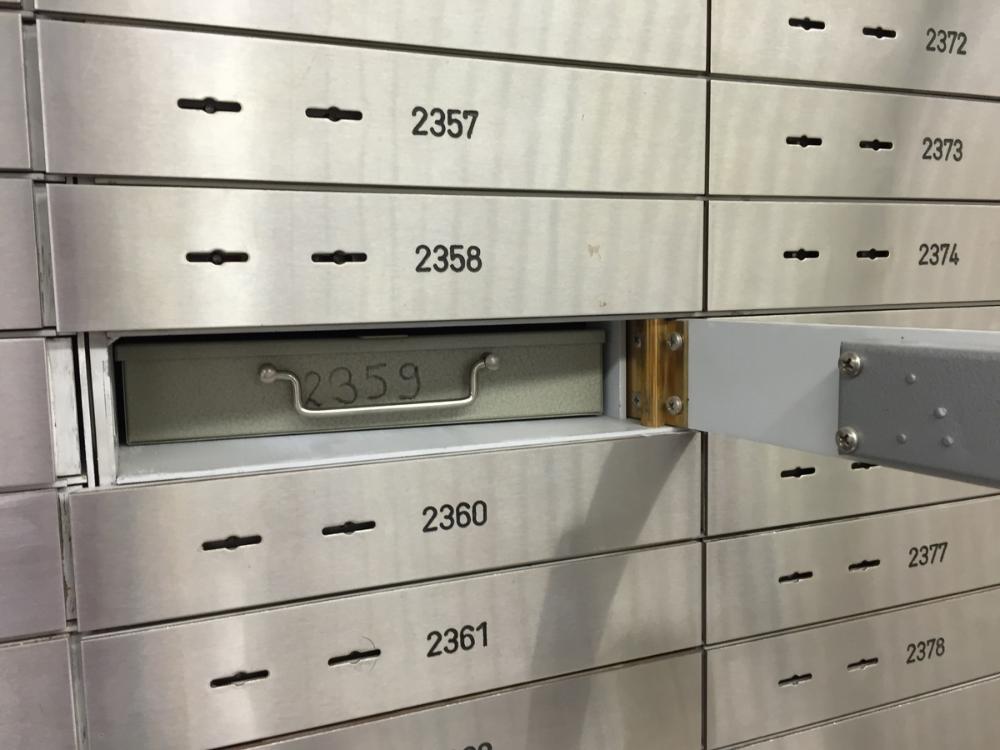
Safe deposit boxes or bank lockers are secure, lockable storage bins that banks rent out to customers for a fee, which normally ranges from $20 to $200 per year depending on the size of the unit, the bank in question and the location. The boxes are typically located in vaults or other secure areas of the bank premises.
Customers usually receive a key, which is used in conjunction with a corresponding “guard” key in the possession of a bank employee, in order to unlock the box. Some boxes are unlocked via biometric authentication rather than a key.
Safe deposit boxes are a reliable way to secure valuable documents like birth certificates, property deeds, vehicle titles and paper savings bonds.
It’s also okay to store cash (although it’s better to deposit cash in a high-yield savings account to counteract inflation), jewellery, gold, silver, rare collectibles and many other valuable commodities in these boxes, but only if you have adequate insurance cover for your items.
Why is having insurance cover for these items important? Because most banks will not agree to be held liable for the contents of your locker and there’s always the possibility of theft from unscrupulous bank employees or even outsiders.
Several decades ago, during one weekend in September, a gang of thieves dug a tunnel to break into Lloyds Bank on Baker Street in London, absconding with almost £500,000 of stolen cash from the safety deposit boxes inside the bank vault.
A similar incident, involving a 25-foot long tunnel being dug from a nearby shop, took place in Mumbai, India in November 2017.
In this case, thieves used the tunnel they had dug to break into a Bank of Baroda branch and decamp with approximately 4 million rupees worth of gold, silver, jewellery and cash from thirty safe deposit boxes inside the bank.
There is also the case of the employee of Frost Bank in San Antonio, Texas, who misappropriated approximately $31,712 from the safe deposit box of a visually impaired, wheelchair-bound customer.
The bank employee had swapped the customer’s key with another key and then used the customer’s key and the corresponding bank key to open the locker.
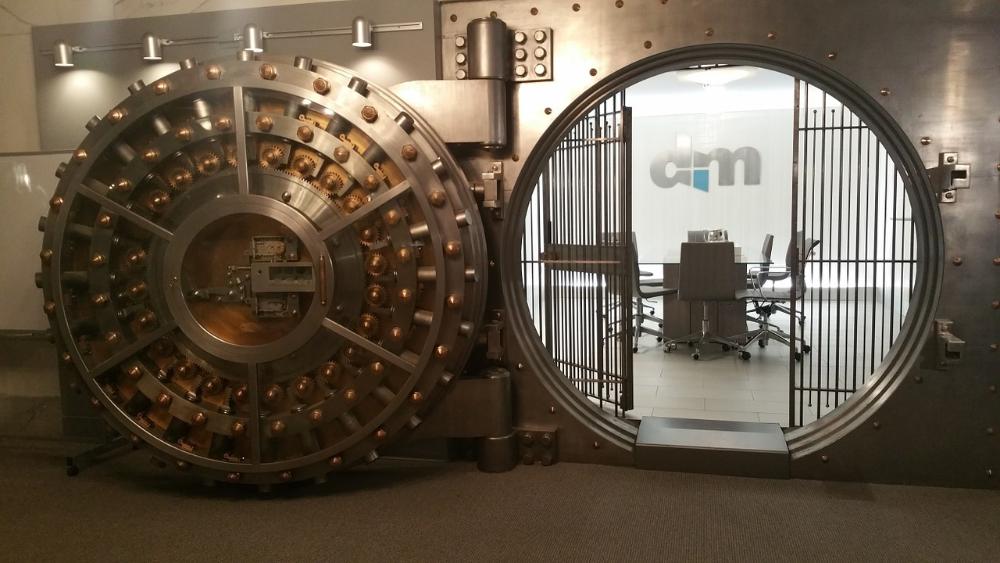
Fortunately, it’s normally cheaper to insure items that are kept in a bank locker than those that are kept in your house or in a home safe.
A homeowner’s insurance policy will normally cover items held off-premises up to a certain value, but if the items limits are insufficient, you can get a personal articles floater, which is a supplemental insurance policy for specified items that aren’t covered under your regular policy.
Despite the importance of having insurance cover, if you don’t have it and something bad happens to your personal property, all is not necessarily lost.
You may in some cases have recourse, as banks have been held liable in court for theft or damage to locker contents in the past, especially in cases where the bank was negligent or otherwise at fault.
The risk of theft aside, bank lockers are also not immune to the usual risks associated with storage, like damage, deterioration or destruction due to flooding, fire, earthquakes, lightning, rodents, insects, extreme temperatures and so on.
Luckily, you can seal valuable documents in plastic sleeves or some other kind of watertight container to at least protect them against water damage.
There are some items that you should never store in a safe deposit box, regardless of whether they’re insured or how safe you think they’ll be.
It’s not advisable to keep original copies of wills in one of these lockers. If you’re unlucky enough to die during your trip, the box will be sealed until an executor can prove to the bank that he or she has the legal right to access the will.
A situation like this could cause long and costly delays for your heirs to receive their inheritance. Instead, keep the original copy of your will with your lawyer or with a person you trust.
Letters of instruction with details on whether you wish to be buried or cremated, what kind of ceremony you’d like to be held for you following your death, which son or daughter should be bequeathed with what piece of your property, and so on, also shouldn’t be kept in a bank locker while you’re away.
If you were to meet your demise during your trip, nobody would be able to access the document and your wishes might not be fulfilled.
There are also a few other types of documents that you might want to avoid keeping in a bank locker. Check out this article for more on that, although some of the listings here here might be less relevant for somebody who is using a box while travelling abroad.
We should also mention that you should try your best not to lose your key, as when this happens the bank will have to replace the lock on the box (it won’t hold a copy of your key), and there’s a substantial fee for getting it rekeyed.
If you should default on your rental payments the bank has the right to sell the contents of the box to pay the delinquent fees. They’ll drill the lock open and confiscate whatever is inside. Any excess from the sale of your items will typically be surrendered to the state as unclaimed property.
In some parts of the world the usage of safe deposit boxes has been on the decline in recent years, especially among the younger generation, since more and more people now prefer to store documents digitally.
Because of the decline in demand some banks no longer offer the service, but many still do, so it’s worth checking with your bank.
Option #3 - Sell it
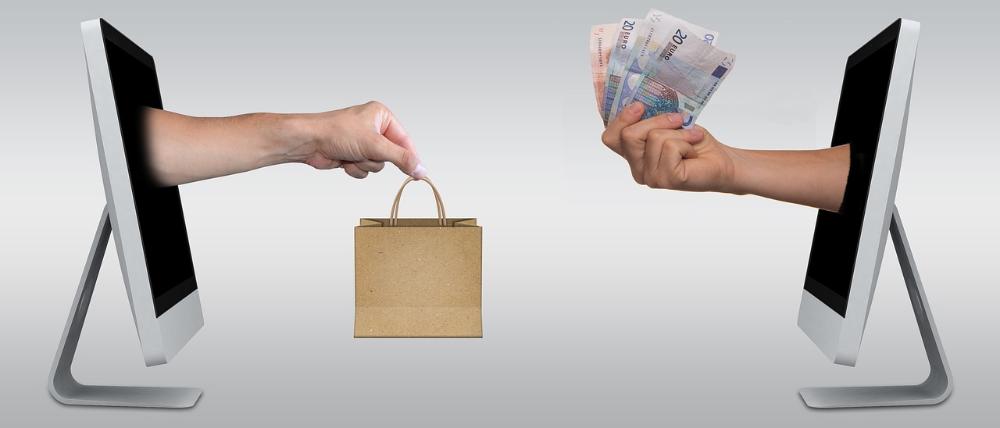
This is the best course of action for any items that will not appreciate in value over time and that could fetch enough money to be worth the time and trouble of listing, advertising, selling, and possibly having to ship to a buyer (if you’re selling online).
It makes sense to raise as much money as you can from the shedding process, since during an extended trip you'll be relying on your savings to sustain you until you’ve figured out a system for earning money while you travel.
Even though you might not make a great deal of money from selling any individual item, you’ll probably be surprised at the cumulative earnings from selling everything you’ve got, especially you’ve been a bit of a hoarder over the past few years.
It’s not uncommon for people to raise several thousand dollars just from selling off all their odds and ends before hitting the road, and believe me when I say that that kind of money goes a very long way in many of the countries I’ve travelled in.
If you apply some of the money-saving tips on this site, a fairly meager sum like $200 can furnish you with an entire month of blissful travel in countries like India, Cambodia, Vietnam, Indonesia, and dozens of others.
There are many possible approaches to selling your stuff but the key piece of advice for all of them is to allow plenty of time.
The more time you have to sell everything, the higher you can set your prices and the more cash you can extract from the items you’re parting with.
If, on the other hand, you’re in a hurry to sell your things, you might have to lower your prices drastically in order to get bites from lukewarm buyers.
But with more time on your side, you can wait for that really hungry fish to come along and buy at the price you wanted.
So bearing all that in mind, it would be best to commence the process of advertising and selling your stuff at least 3-4 months before your planned date of departure.
All kinds of items could potentially be worth trying to sell before you hit the road, including vehicles, sports equipment, tools, books, CDs, DVDs, video games, toys, electronics, furniture, appliances, paintings, home decorations, clothes, shoes, jewellery, and so on.
Here are some of the approaches you could take to selling your things, along with the pros and cons of each strategy.
Sell by word of mouth
The simplest approach is to attempt to sell things by word of mouth to friends, family, work colleagues, neighbours and other people in your social circle or neighbourhood.
While this kind of marketing can be effective, the downside is that you’ll only be able to advertise to a relatively small pool of potential buyers.
You definitely might want to implement some guerrilla marketing tactics if trying to sell this way in order to generate more intrigue and curiosity from people.
I actually used these kinds of tactics before in Hanoi, Vietnam when my tourist visa was about to expire and I needed to quickly sell my motorcycle to a backpacker.
I taped a “motorbike for sale” sign to my body and drove through the crowded alleys in the city's old quarter looking for backpackers who might be interested in buying my scooter.
I also went inside several popular backpacker hostels and announced to groups of backpackers that I was selling a bike.
It wasn’t long before I found one Australian guy who was ready to buy, although I actually sold the bike to a Russian couple in the end because they were offering a much better price than the guy.
This method of selling works, but it’s not the most efficient and you might feel a bit embarrassed trying to sell stuff to random people that you run into. Let's look at a few more options.
Organize a yard or garage sale
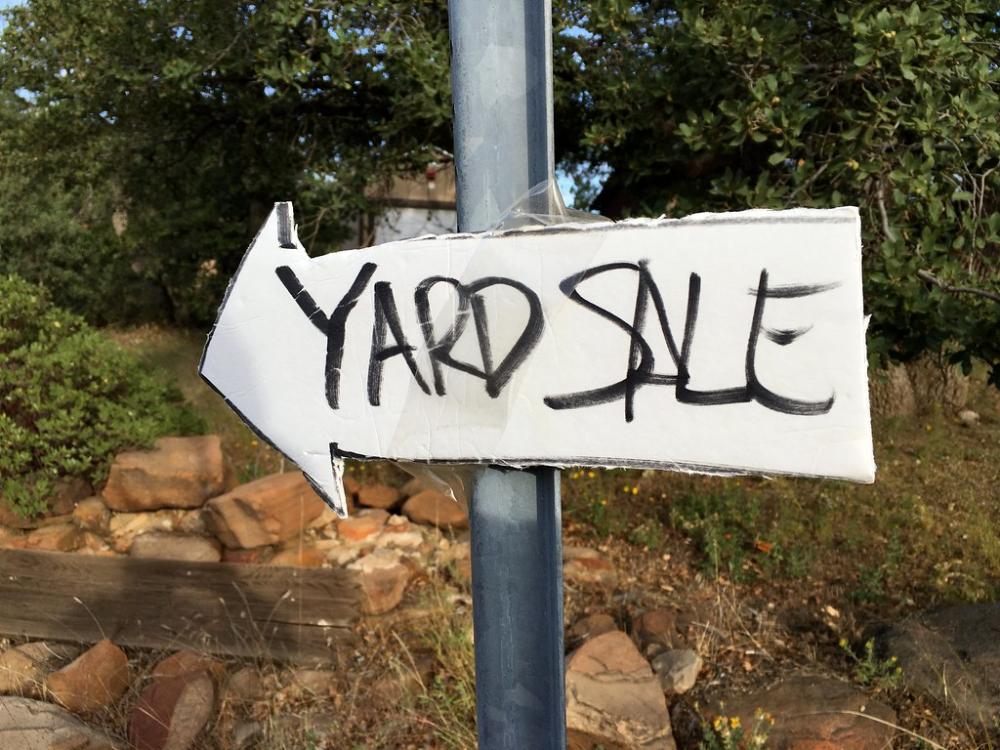
Another option is to organize a yard sale (also known as a garage sale, tag sale or rummage sale), which is an informal event where you try to sell off all your pre-loved items in your front yard.
Yard sales can be often be multi-day events, running over a weekend or over a 3-4 day period. Try to hold yours on dates when the weather will be favourable and hold it in the mornings, when more people will be free to attend.
It’s of paramount importance that you advertise your yard sale or else nobody will turn up.
You can create a newspaper advertisement in a major daily newspaper, as well as in your local newspaper (if one exists). This will cost money but should drive a lot of traffic to your yard sale.
You might pay $12 per column inch (a space one column wide and 1 inch high) in a local newspaper, so keep the ad as concise as possible. A major national newspaper could charge twenty times more for the exact same ad.
You can also post ads for your yard sale online on sites like Craigslist, Garage Sales Tracker, Yard Sale Search, Garage Sale Finder and Garage Sale Hunter.
You can also use apps for iOS and Android like Yard Sale Treasure Map, which will place a marker of your yard sale location on Google maps for yard sale hunters to see. Many local buy & sell apps (which we cover in detail further below) also let you advertise your yard sale.
You should also create signs and put them up near your house to try to direct some of the passing vehicles to your yard sale. You can use brightly coloured, eye-catching poster boards and markers to create the signs.
Just write “Yard Sale” in large letters, include your address and draw an arrow pointing in the direction of your house.
There may be some regulations regarding where you can put up a sign, so it might be a good idea to check with the police that they’re not banned where you’re living.
You may also require a permit for the yard sale itself so check with your city or town hall to avoid the risk of getting shut down (and possibly fined) midway through the event. Some town halls have websites where you can apply for such permits online.
If it all sounds like a lot of work, that’s because it is, but remember that even a few hundred dollars of earnings could translate into months of travel if you keep your budget tight.
For more tips on organizing a successful yard sale check out this article.
Bring your stuff to a car boot sale
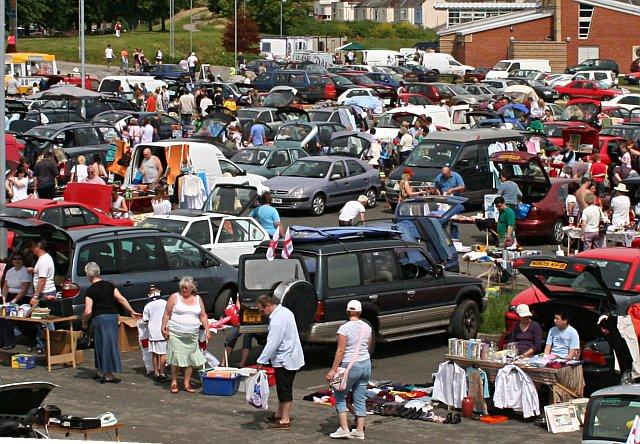
Car boot sales are a popular way to sell off unwanted, second-hand household goods and other clutter in many European countries, but particularly in the UK and Ireland.
These are normally single-day events held in outdoor venues like car parks, grass fields, school grounds etc. during the summer months, although some are also held indoors year-round. The impermanent ones are usually held at the weekend, often on a Sunday.
At a car boot sale the vendors will typically arrive early in the morning with vehicles loaded full with goods to sell.
The sellers will then unpack their wares and lay them out on tarpaulins, blankets and folding trestle tables, or will sometimes just display them in the open boot of their car.
All kinds of paraphernalia will sell at car boot sales – used books, C.Ds, DVDs, games, antiques, collectibles, toys, soft animals, furniture, cushions, gadgets, game consoles, clocks, mirrors, jewellery, electrical appliances, tools, crockery, clothes, shoes, bags….. the list goes on.
You will often have to pay a seller fee of around £5 - £15 for your pitch at these events (sometimes it’s free to sell), but vendors can often take in £80 or more over the course of the day, so you should at least be able to recoup the cost of the pitch, while ridding yourself of a lot of clutter.
Many car boot sales can be booked online in advance through the website of the operator and you may be turned away from some events if you haven’t reserved a spot before you turn up.
One thing to know about car boot sales is that buyers are coming to them expecting amazing bargains, so you’ll have to price most of your items very low indeed (probably £10 or less) to make any sales.
Items like books, clothes, CDs, DVDs and video games will typically sell for just 50p - £1, with some appliances or antiques perhaps fetching you up to £10.
This is why car boot sales are best for selling off low-value items, so if you have some belongings that you think are worth a lot more money than that, you should probably try to sell them elsewhere.
There are lots of little tricks to maximize your earnings at car boot sales, like getting there as early as possible, choosing a prime location, pricing your items correctly (not too high, not too low), having a partner to help out when things get hectic, creating an attractive, organized display, having special offers (buy one, get one free etc.) and being friendly and approachable.
Remember to bring plenty of spare change for the people who try to pay for things with big notes. If you're selling clothes it's best to bring a rack to hang them on so that people can easily riffle through them.
If you live in the UK or Ireland, you can find car boot sales near you at Car Boot Junction.
The listings here have all the information you need about the car boot sale event like the venue, date, time, seller fee, facilities, operator name, contact details and so on.
You can also use Carbootsales.org to find car boot sales in the UK, Ireland and a few select European countries.
Check out this article too for some more tips and advice on making your first car boot sale a success.
Sell at a flea market
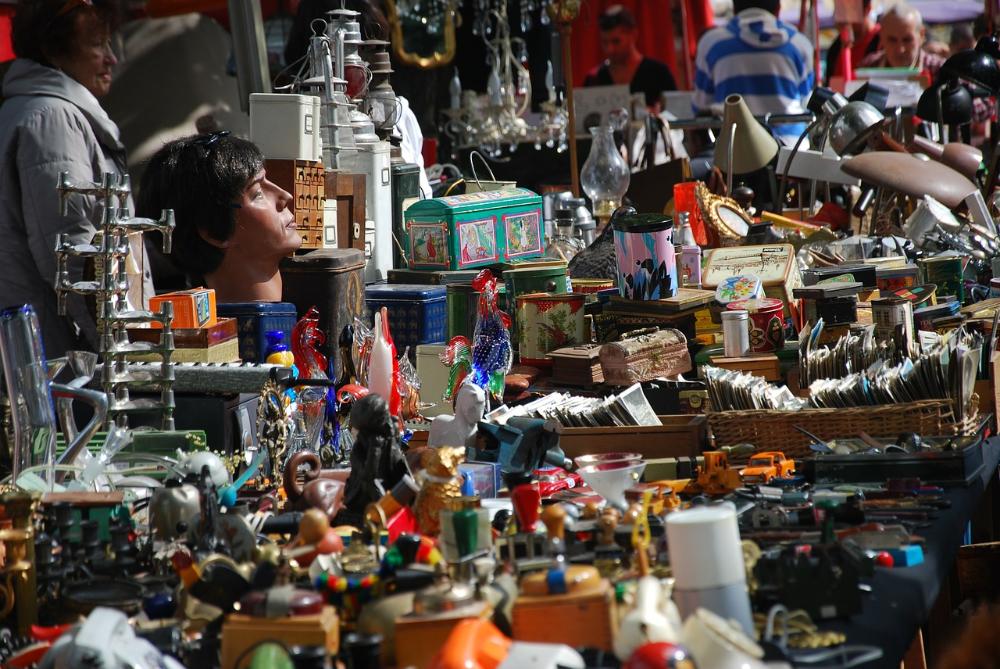
The concept of the flea market or swap meet has existed for millennia and these marketplaces still exist in countries over the world to this day.
Flea markets mostly exist for the sale of second-hand goods like antiques, furniture, books, CDs, games, clothes, toys, bric-a-brac, knick-knacks, bits-n-bobs, - pretty much all the same things that you’d find at any garage sale or car boot sale.
The more informal type of flea markets tend to be seasonal and are often held once per month on Sundays, but you do also come across more formal fixed-style markets, which are often held indoors.
Flea markets can take many different forms and go by a host of different names depending on where you are in the world, but they all basically serve the same purpose.
You have terms like Flohmarkt (Germany), Marché aux puces (France & Quebec), tiangge (Philippines), trash and treasure market (Australia), jumble sale (usually refers to an indoor flea market), mercados persa (Chile), shrukawadi bazaar (India) and many others. You could also regard a car boot sale as a type of flea market.
There is some dispute surrounding the etymology of the term “flea market” but it does appear to have something to do with those wingless bloodsucking parasites of the order Siphonaptera.
The term is most likely a literal translation of the French “marché aux puces”, which means “market of the fleas”- presumably a reference to the flea-ridden second-hand clothes and furniture upholstery that were sold at such markets.
If you live in a town or city, there's a very good chance that there’s a flea market held near you. You can begin by doing a web search for “flea market + your area”.
There are also flea market directories like fleamarketzone.com and myfleamarketguide.com (both sites are U.S only).
Many flea markets have their own website where you can apply to hire a stall for a full day or longer. For markets where the demand for stalls is lower you may be able to just show up on the day and pay in cash for your pitch.
At a typical flea market a certain number of the stalls will be held by permanent regulars while the remainder will be rotating. It is the latter type of stall that you’ll most likely be renting if you just want to sell off a few items.
In my local flea market (Dublin flea market), which is held on the last Sunday of the month in Newmarket Square, Dublin 8, the stall rental fee is a fairly steep €50 for the day, although that doesn’t seem to deter too many people from trying to sell there (there are twice as many applications as there are available stalls each week.)
The stall owners here do at least provide vendors with tables and a chair, although everything else you have to supply yourself.
Not all flea markets charge a stall rental fee however and sometimes the smaller ones that don’t charge anything at all can be the most lucrative markets to sell at.
In some types of flea markets there will be a cashier to whom people can pay for items from your stall, so in these types of markets you can be very much hands-off.
The owners make the rules at these markets too, so there may be restrictions on the types of items that you are allowed to sell. For example, some flea markets only let you sell used or vintage items.
Check out this guide too for more information and tips for selling at flea markets in the U.S.
Sell through a consignment store
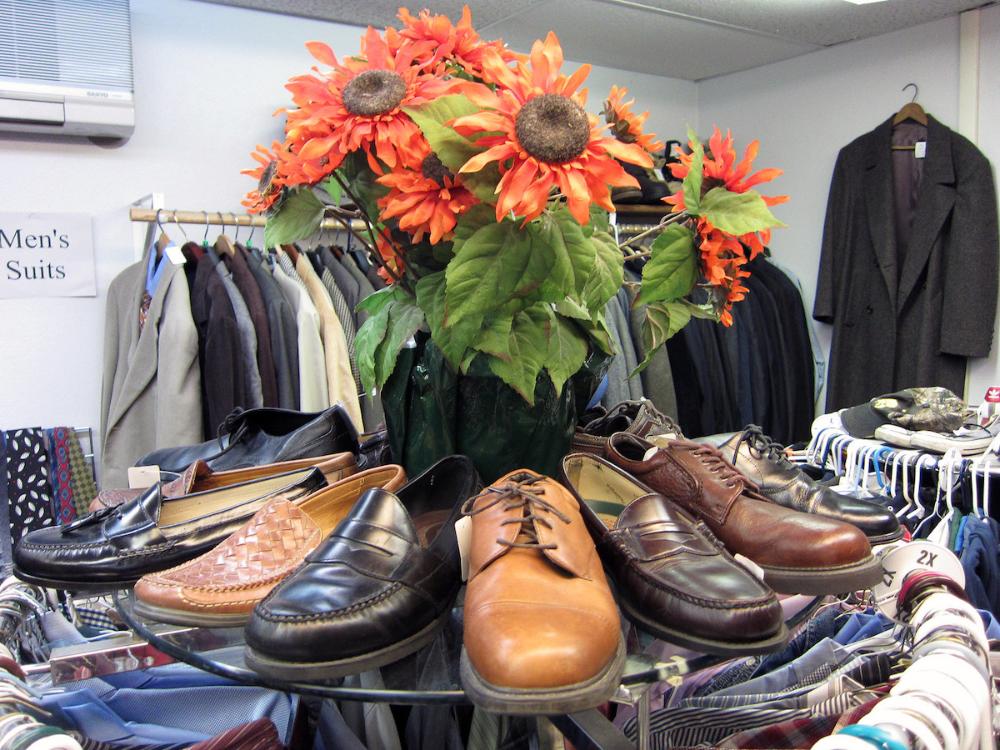
Consignment stores are a relatively convenient, if not the most lucrative or quickest way to sell some of your miscellaneous, unwanted stuff.
Clothing, toys, books, furniture, sports equipment, purses, handbags, shoes, ornaments, glassware are all fair game in general consignment stores, which will sell all kinds of paraphernalia.
There are also specialty consignment stores, which sell a much narrower range of items, and these can often more profitable to sell in if you have the right items.
How selling at consignment stores works is that you drop off or mail in the items you want to sell and the store will take from you the items it expects to shift, returning you back the rejects.
The store will then try to sell the items on your behalf, taking a commission (which can vary hugely from 5 – 95%) from any items that sell. An identification code the store adds to each item for sale ensures that the money is credited to your account.
When selling by consignment, proceeds from sales will slowly trickle into your account, although it could take weeks for your items to sell, if they sell at all.
If your item doesn’t move at full price after a few weeks, the store will usually start reducing the price in increments.
If it still hasn’t sold after a certain period, the store may invite you to take back your items, which still belong to you at this point. Taking unsold items back is normally free, although some stores do charge a small activation or consigment fee.
Some stores might also, or might only offer you an upfront payment for any items they expect will sell.
Technically this type of store would be classified as a pawn shop and you would relinquish ownership of your property as soon as the shop pays you.
You might earn less by accepting this method of payment (because the store has to account for the possibility that the items won’t sell at all) but it’s guaranteed, instant cash in hand, and is probably a better option if your trip is looming.
Note also that some consignment stores will often give you the choice to be paid either in cash or in-store credit. Usually you can earn a higher amount by opting for the credit, but obviously if you’re trying to raise funds for an upcoming trip, you’ll want to take the cash.
One of the obvious downsides of selling through a consignment store is that the commission, which can often be frustratingly high, will eat into your takings.
Another thing to be aware of is that it can take quite a while for your items to even get listed (in online consignment stores) or displayed on the shelves, and, as we mentioned already, they may not even sell, or may take a long time to sell.
You have the best chance of success if you’re selling high quality, branded items in almost-new condition. Scrub your items up well before handing them over, and make sure that no crucial pieces, parts, buttons, laces etc. are missing. When trying to sell clothing it’s also really important that the pieces are in-season.
If you don’t know of any local consignment store in your area, there are also online consignment and thrift stores to consider.
With these you either mail in your items for the store to sell on your behalf, or you mail your items directly to buyers, with the store acting as the middleman between the two parties and taking a cut of the sale.
Here are five of the biggest platform in the business to get you started.
Decluttr
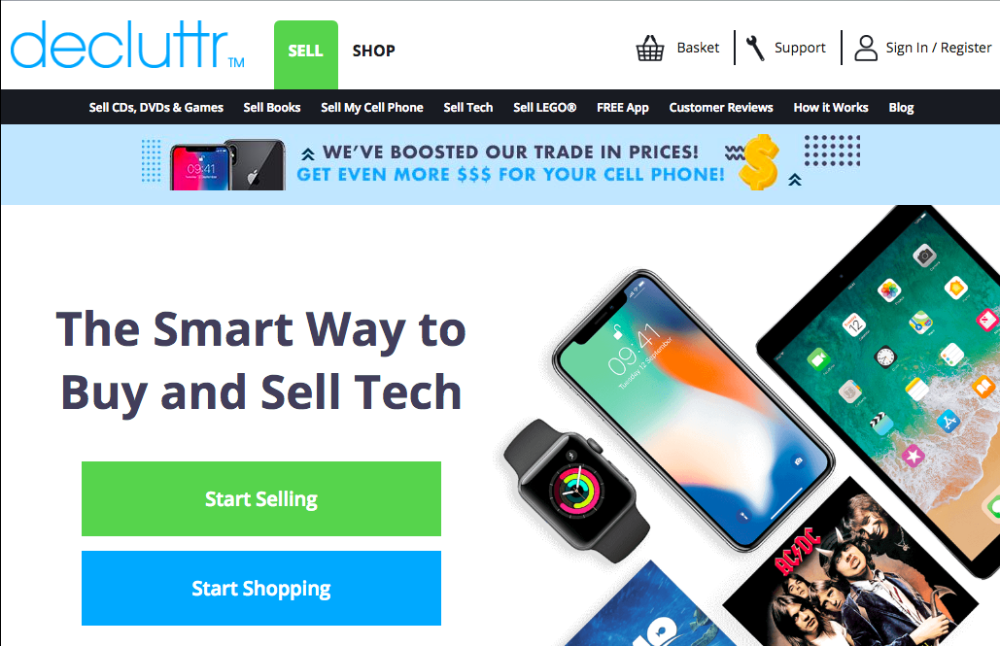
Decluttr is a secondhand goods retailer, with apps for both Android and iOS, that will buy up your used cell phones, laptops, tablets, e-readers, games consoles, wearables, CDs, DVDs, Blu-rays, video games, books and even Lego.
The company makes money by then reselling these same items for a substantial 50% profit margin on their own platform, often after some refurbishing.
The service is currently only available to people living in the U.S and has apps for both Android and iOS.
If you’re selling books, CDs, DVDs, Blu-rays or games you just have to enter the barcode number on the website and Decluttr will give you an instant quote. The smartphone app makes this process easier by turning your camera into a barcode scanner.
If you’re selling cell phones and other tech items you just input the make and model of the device on the site and again you’ll receive a quote. Sometimes you’ll be asked to send in the chargers but not in every case.
If selling Lego, the price is based on the weight in pounds, so you’ll have to put it in a bag and weigh it to get your quote.
If you’re happy with the price you’re offered, the next step is to load your items into any reasonably suitable box and get your welcome pack containing your prepaid UPS shipping label. This can be sent to you either via regular mail or e-mail (up to you).
Once you’ve taped the shipping label to the box (if you have multiple boxes you need to print additional labels), you then just need to drop it off at your nearest UPS Store, Customer Center or Authorized Retail Outlet and they’ll handle the rest.
You can even give the box to a UPS driver. You’ll find your nearest UPS shipping location here.
Once the team receives your box and approves your items you’ll be paid the following day, either via Paypal, direct deposit or check.
If however, the items are in poorer condition than described, you may be offered a revised price, which you have 14 days to accept.
One other thing we should mention is that for your box to be accepted it needs to contain at least 10 media items or 1 tech item, and the total value of all the items must be more than $5.
While selling stuff to Decluttr is quick, convenient and saves you the trouble of creating listings and dealing with buyers, the downside is that you don’t get very much for your items.
The company obviously makes its profit from buying your things for next to nothing, giving them a makeover and then selling them at much higher prices.
Alternative to Decluttr - Another company that will buy your used CDs, DVDs and Blu-rays is Secondspin, and they've been in business since 1987.
With Secondspin you pay for shipping but you they do give you a shipping rebate up to a maximum of $5.26, depending on how many items you ship in. You can also sell at their stores, although the prices offered in stores may be different to those quoted online.
Thredup
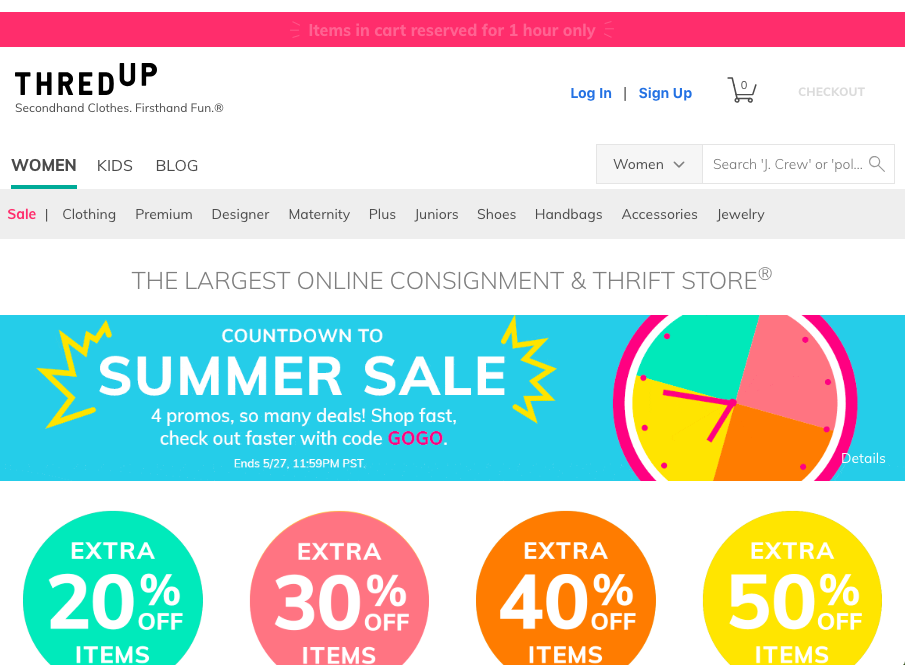
Thredup is one of the largest online consignment stores out there. You can use the platform to sell all kinds of second-hand clothes, shoes, handbags, accessories and jewelry designed for women and children.
Once you’ve created an account you can request a free cleanout bag, which is a really large mailing bag that comes with a return mailing label to send it back to Thredup via FedEX or USPS, along with some guidelines for what items they do and don’t accept.
The costs associated with mailing the bag back and forth are deducted from any earnings you make through the platform.
Payouts with Thredup range from 5% of the sale price (for items valued at $14.99 or less) to 90% of the sale price (for items valued at $300 or more). Thredup may also pay you upfront for certain items rather than selling them on consignment.
The payout steadily increases with increasing item value, and designer brand items (Luxe items) fetch a slightly higher payout in the upper price ranges.
Poshmark
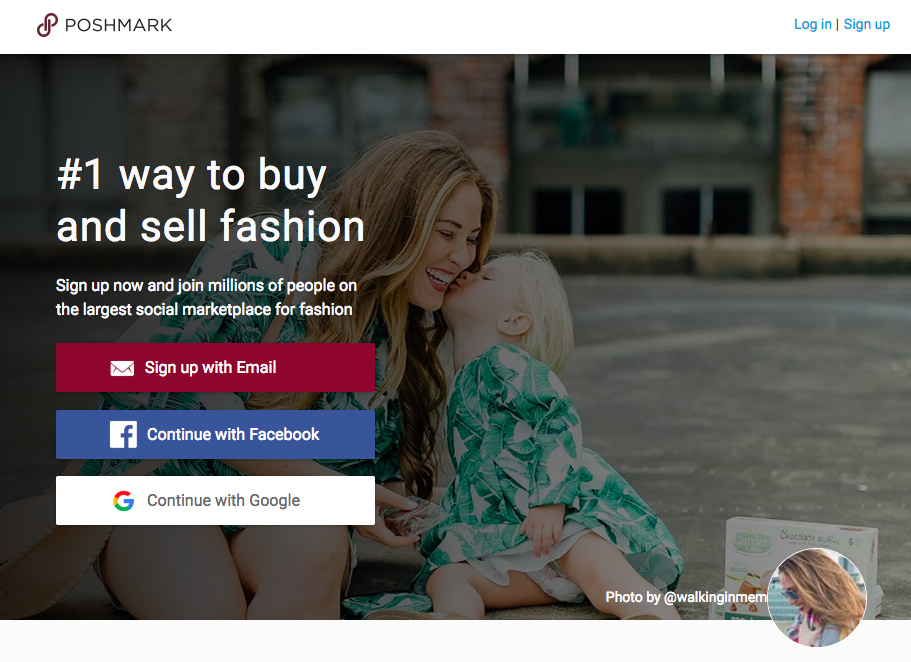
Poshmark is a social app for mobiles that was inspired by Pinterest. You can display your closet (clothing, shoes, accessories) for other users to subscribe to, as well as follow other user’s closets if you dig their style.
Poshmark lets you set your own prices and when you make a sale the company provides you with a prepaid, pre-addressed shipping label (supporting packages up to 5 pounds) ready to be put on the box.
You can then drop the box off at your local USPS mailbox or have it picked up free of charge from your home.
The platform also supports a feature called Posh Parties, which are real-time, themed, virtual shopping events that anyone who joins can share one of their listings to, as long as it's appropriate to the party theme. The feature is supposed to help your closet get exposure to new users on the platform.
Regarding commission, Poshmark charges a flat fee of $2.95 for any items that sell for under $15 and takes a 20% commission for any items that sell for $15 or more.
Tradesy
.png)
The main objective of Tradesy is to make women’s designer clothing and accessories accessible to the masses.
It provides a platform for women to buy and sell pre-owned designer clothing, bags, shoes and accessories at affordable prices. It even has a wedding category where users can sell wedding dresses, wedding gifts, bridal veils and other wedding items.
The smartphone app lets you easily price, photograph and list your items and once you make a sale you have three different options for shipping your item directly to the buyer:
- You can request a pre-paid, pre-addressed, all-inclusive shipping kit with prepaid USPS Priority Mail shipping label, so that you never have to even leave your home.
- You can print off your own USPS Priority Mail prepaid shipping label from your Tradesy account with tracking and insurance, and use your own packing materials
- You can do everything on your own – packaging, labels, tracking and insurance - and set your shipping cost. Wedding items are the one category that must be shipped on your own
Whatever shipping method you choose, the buyer will cover the shipping cost so you won’t have to worry about that.
As a seller you’ll pay a commission of $7.50 on any items sold for less than $50. Items sold for $50 or more are under a 19.8% commission scheme. There’s also a 2.9% safe transfer fee to withdrawn earnings from your Tradesy account via PayPal, debit card or bank transfer.
Swap.com
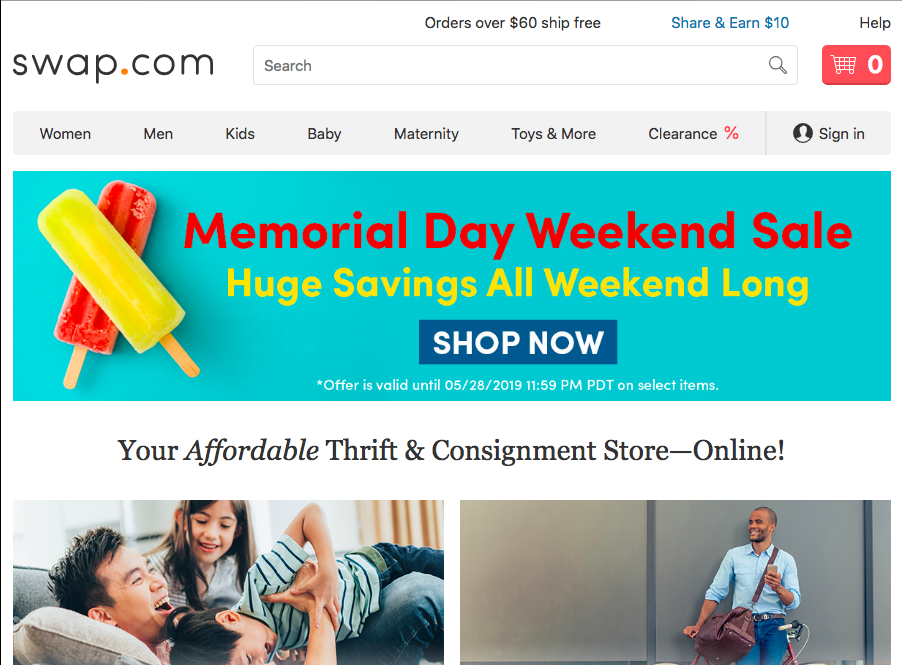
If you’re looking for a more general online consignment platform that’s not (although it used to be) exclusively focused on clothing and fashion accessories, swap.com fits the bill.
The platform lets you list a wide range of gently used, second-hand items, such as DVDs, video games, books, sports equipment, home décor, clothes (men, women, kids, baby), toys, puzzles, baby apparel and so on.
To mail in your items you can either use your own box that conforms to dimensions specified by Swap.com, or you can have them send you their own mailing box. The box can be dropped off at any FedEx ground location or handed to a FedEx driver.
In either case you’ll have to pay the Inbound Service fee (covers the costs of shipping, sorting, photographing and marketing your items) but you’ll pay $3 less if you use your own packaging. The fee consists of a flat fee of $11.90 for just a label or $14.90 for a label with a box or bag.
One important thing to be aware of before sending things to swap.com that the site is known for having a very strict item acceptance criteria, so you’ll need to inspect your articles very carefully before deciding to send them in.
Moreover, if more than 50% of your items get rejected you’ll be charged $10, and you’ll be charged $5 if 40-50% of the items are rejected. Oversized boxes (larger than 20” x 20” x 17” or heavier than 50 lbs) also incur a penalty charge of $25.
If your account balance goes negative from these penalty charges you’ll have to make sales just to bring it back to a positive value.
For any items that get rejected you can choose to have them donated or shipped back to you, which you may have to pay shipping fees for.
Unfortunately, you have no control of the pricing of your items when selling here, as Swap.com sets the prices based on their price optimization algorithm.
For items that sell for $8.00 or less you’ll only receive 15% of the sale amount, making it less worthwhile to sell low-value items on this platform.
However, if an item sells for $8.01 or more you’ll receive 70% of the sale price, minus a flat fee of $4.95. Also, payouts are 20% higher if you accept store credit instead of cash.
Vinted
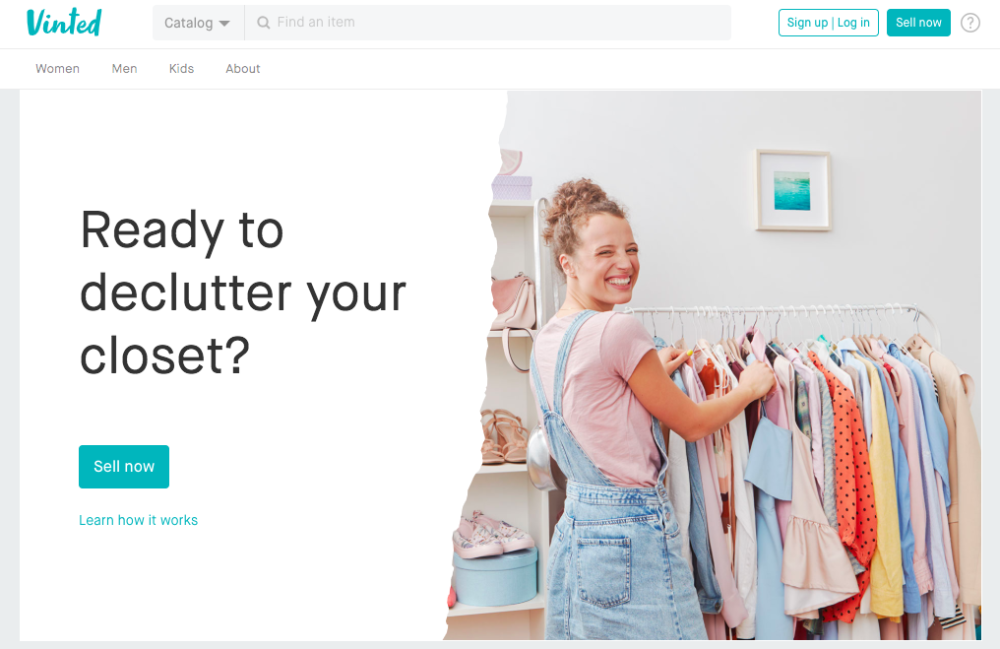
First launched in 2008, Lithuanian startup Vinted has become one of the world’s largest online marketplaces and communities for buying, selling and swapping pre-owned clothing.
The platform now has over 21 million users and is available in nine markets, namely, the UK, France, Germany, Netherlands, Poland, Czech Republic, Lithuania, Spain and the U.S. In addition to its website platform, Vinted has apps for both Android and iOS.
Although Vinted does have a men’s clothing category, it’s definitely more of a female-oriented platform and most of its users are women.
It’s a great place to sell women’s dresses, tops, coats, lingerie, swimwear, maternity clothing, shoes, bags, accessories, cosmetics, children’s clothes, strollers, toys, car seats and other similar items.
Vinted is a particularly advantageous platform for sellers because they don’t have to pay any listing fees and Vinted doesn’t take a commission from sellers on each sale either.
Instead, Vinted makes its money by charging buyers a buyer protection fee (which protects them against fraud) of 5% of the sale amount plus a fixed fee of $0.70.
It also makes money by offering sellers paid promotional tools like item bumps that are entirely optional. An item bump moves your listing to the top of relevant users’ feeds and search results once per day for 3 consecutive days.
Although you can use Vinted’s in-app messaging system to arrange to meet with buyers and transact in person, the company advises against this method and prefer users to ship items and pay via credit card, as this is how it makes money.
Vinted integrates tracked shipping with USPS into its platform, allowing sellers to download a prepaid shipping label (paid for by the buyer) that can be taped to the package before dropping it off at any USPS drop off point.
Some of the larger items that are sold on the platform, including strollers, ride-on toys, car seats and children’s furniture are non-shippable through Vinted, and have to be collected in person by buyers.
Sellers receive payment into their Vinted wallet as soon as the buyer confirms within the app that everything is ok with the delivery.
If the buyer doesn’t give any feedback the money will automatically appear in the seller’s wallet after 2 days. Funds can then be transferred from the wallet to the seller’s bank account.
The RealReal
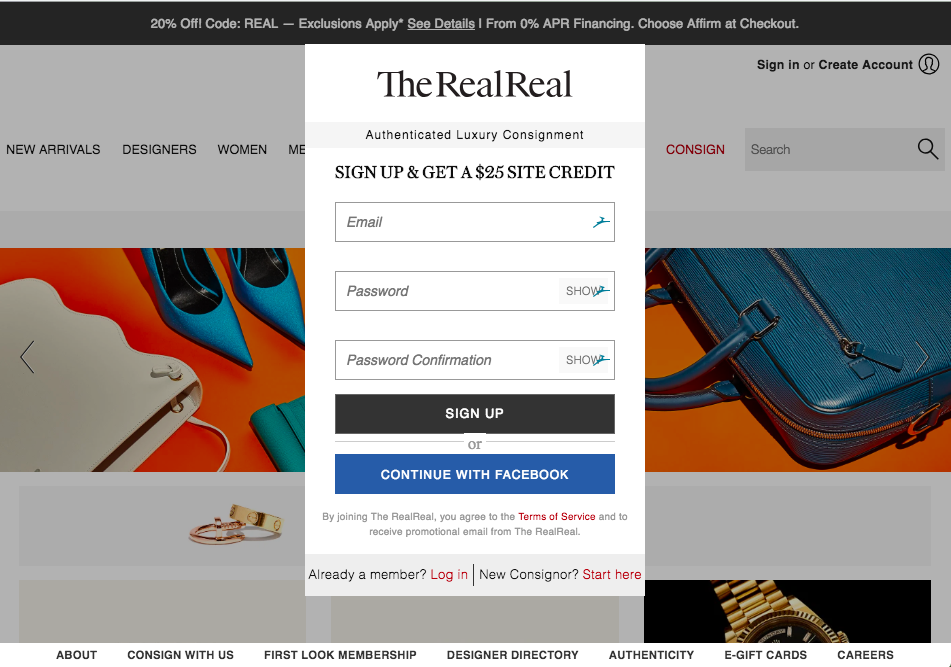
The RealReal is an online platform for the buying and selling of second-hand luxury goods and designer clothing.
Items listed on the platform include women’s fashion and accessories, men’s fashion and accessories, shoes, handbags, men and women’s jewelry, watches, home décor, furniture, kitchenware, kid’s clothing and accessories, baby gear, fine art and so on. The site has a designer directory that lists all the brands they accept.
If you have 10 or more items you may be able to consign them by scheduling a free home pickup (not available everywhere) with the company's White Glove pickup service.
If this service is unavailable in your area or you have fewer than 10 items, you can print off a free, prepaid label and mail the items in yourself.
A third option, if there’s one near you, is to visit a brick-and-mortar Luxury Consignment Office for a free valuation and drop-off.
Once your items are received a team of 100+ gemologists, horologists, luxury brand authenticators and home and art curators will evaluate and authenticate each item before handling the rest of sales process.
The commission structure for the RealReal is a little bit involved, but basically you’ll fall into one of three commission tiers based on annual net sales.
The VIP tier ($10,000+) pays 70% commission, the Icon tier ( $1,501 to $9,999) pays 60% and the Insider tier (below $1,500) pays 55%. You can earn 5% extra commission if you opt for site credits instead of money.
On achieving the VIP level you also receive $100 site credit, priority processing of your consignments and a couple of other benefits.
To further complicate the picture, there are also item commission rates, which allow you to earn more for high-value, in-demand items, but can also cause you to earn less for lower-value, low-demand items, because these item rates take precedence over the normal tier-based commission rate.
Under the item commission rates, any item sold for $145 or less would only net you 40% commission, whereas a watch sold for $2,500 or more would net you 85% or more. Art items with a resale list price of $196 or more would receive 70%.
Check out this page on the website for a full understanding of the commission structure.
Sell through a consignment sale
Consignment sales are short-lived but intense, seasonal sales events, often taking place in the spring or fall and usually running for just a few days.
Some events are sponsored by churches, non-profits and other organizations, while others are independent. They might be held in school gymnasiums, community centres, hotel conference rooms, strip malls and the like.
Hundreds of shoppers can turn up at these events looking for fantastic bargains on second-hand goods, and will often leave with vehicles filled to the brim with the stuff they’ve picked up.
The sheer volume of stuff at these events is enormous, but the pool of buyers is also very large, so your stuff does stand a reasonable chance of getting noticed among all the other stuff.
Vendors usually just drop off their items with the coordinators of these events, who will take a commission (usually 30 or 40%) for each item sold. There’s also usually a $10 or $15 registration fee.
With consignment sales, there’s usually more work to be done on your part when compared to consignment shops, since the event is short-lived and everything has to be ready to go when it kicks off.
Event organizers may need you to add barcodes, stickers or tags to your items in order to identify them as yours and you may need to set prices for each item too, in accordance with the event guidelines. If you’re selling clothing you may need to bring them on hangers.
Because of the registration fee at consignment sales, it would only make sense to use this as a sales avenue if you have a reasonably large inventory. If you only have a few items to sell a consignment store might be a better choice.
Additionally, higher value items will be easier to sell at a consignment store because they’ll have more time to sell and won’t be competing with quite so many cheap, impulse-buy items, as would be the case at a consignment sale.
Sell on major online selling platforms
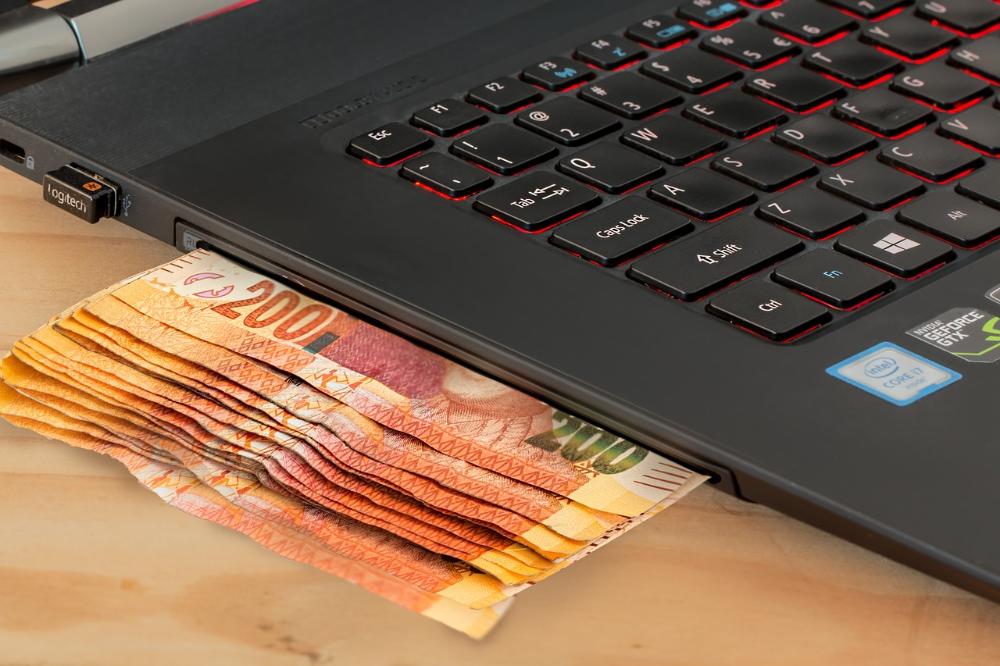
Big ticket items don’t usually sell very well at yard sales, informal flea markets, car boot sales and the like, so it’s often a good idea to try to sell them online instead.
Since you’ll be able to command a relatively high price for these types of items, it’ll be worth the trouble of photographing and listing them and then shipping them to the buyer once you’ve made a sale.
For items like old computer games, CDs and DVDs that would only fetch a few quid if you were to sell them individually, it’s best to sell them as collections or sets online. You might for example try selling a tall tower or stack of video games or DVDs for $100 or whatever.
Here are several of the best-known platforms to try your luck on.
Ebay
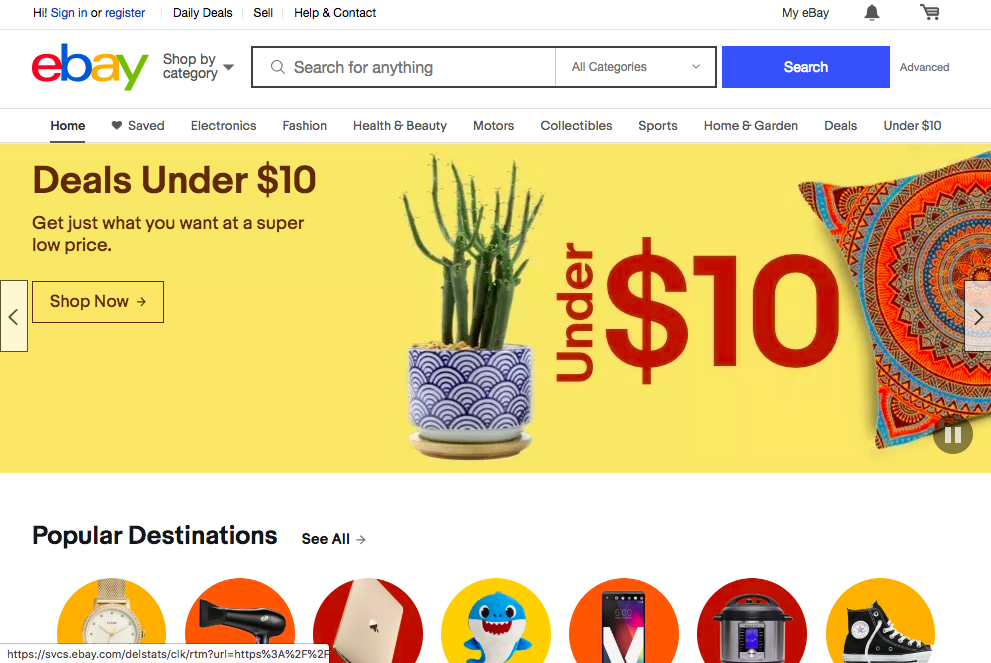
If you haven’t heard of Ebay you’ve probably been living under a rock for the last few years.
Ebay is one of the world’s biggest online marketplaces, handling more than 1 billion transactions every day, from more than 179 million active users. Ebay operates 23 international domains and has a wider presence in over 100 countries across the globe.
Once you set up an eBay account you can use it to both buy and sell items in the eBay marketplace.
When you want to sell something, eBay gives you the choice to either hold an auction for your item or sell it at a fixed price.
If you’re holding an auction you can set an auction start price and also a higher “buy it now” price for anybody that wants to buy the item immediately, without having to bid against other interested buyers.
However, once the first bid is made buyers have to wait until the end of the auction to get the item.
You can also set a reserve price when running an auction on eBay, which is the minimum amount that a buyer must bid in order for the item to be sold. The reserve price will lie somewhere between the auction start price and the buy it now price.
Almost anything can be sold on eBay, including a lot of stuff that would downright surprise you, so don’t be afraid to create listings and see what moves.
Fortunately, you can sometimes determine before creating a listing if a particular item has already been selling on eBay and at what price.
You do this by performing a search for the item you’re selling and then filtering for “sold listings” (check the box for “sold listings” in the sidebar on the left under “show only”).
Once this filter is applied you will only see the listings that have actually sold and the price they sold for in the search results.
Do be warned that some items won’t sell very well on eBay, particularly the kinds of items that aren’t very searchable or aren’t easily described or categorized.
As a private seller on ebay there are a number of different fees you could potentially pay when selling an item.
There is the insertion fee (listing fee), which you may or may not have to pay, depending on the circumstances and the mode of selling. This is a non-refundable fee that you won’t get back, regardless of whether the item sells or not.
You can generally avoid this fee by setting an auction starting price of less than $0.99 with no reserve price, or a buy it now price of less than $0.99.
There’s also the final value fee, which is equivalent to 9% of the item sale price for an auction (capped at $50) and can vary for a fixed-price listing depending on the circumstances. This fee is only levied if the item actually sells.
You might also pay optional feature fees for various listing upgrades that help to boost your listing’s visibility.
eBay seller fees are notoriously convoluted so please see here for more detailed information about them.
If you make any sales on Ebay you will have to package and ship the item(s) yourself, so you’ll probably be making quite a few trips to your local post office or courier if you have any luck.
Generally you’ll have the buyer pay the item shipping costs. If you want to sell an item for $10 and shipping is going to cost you $5 you can price the item at $15 and offer “free shipping”.
Alternatively, you can just price the item at $10 and transparently charge an additional $5 for shipping.
Sellers sometimes get scammed by fake buyers on Ebay (and vice versa) and you do need to careful selling on the platform, especially if you’re the new kid on the block. Scammers specifically target new sellers who aren’t yet aware of all the booby traps.
Smartphones, tablets, cameras and other electronic items can be especially risky to sell on eBay because buyers, once they receive the item, will sometimes strip the device of its valuable internal components and then return the now worthless shell to you, claiming that the item you sold them was not as described.
The buyer then receives a full refund through Paypal and the proceeds from the sale are deducted from your Paypal account, leaving you with nothing.
If you’re selling valuable jewellery, some buyers can swap diamonds and other precious and semi-precious stones with worthless fakes and then return you the item, again leaving you with nothing while they get their money back and abscond with the merchandise.
If you’re selling collectibles or autographs make sure you have get them authenticated to defend yourself against buyers claiming they’re fakes and getting a refund.
There are a multitude of different ways that sellers can be scammed on eBay, but the odds of being a victim are thankfully very low, so don’t let the possibility of fraud discourage you from trying to sell on the platform.
To reduce the risk of getting swindled on eBay, make sure you take photos of the item you sent in its packaging to help prove that it was sent as described.
You’ll also need to have proof that the item was delivered. Sending by registered post means that the buyer has to sign for the item, which proves it was in fact delivered.
One final thing we’d like to mention about selling your stuff on Ebay is that you can also choose to donate a portion (from 10 to 100%) of each sale you make to your favourite charity (you can choose from more than 24,000 of them) through the Ebay Giving Works program.
The donation will be automatically collected by Paypal Giving Fund, a non-profit partner of eBay, who will forward the full donation amount to the selected charity before issuing you with a tax receipt.
Ebay will also credit back to you an equivalent percentage of the listing and final value fees for the sale when you participate in this program, so for example if you donated 20% of the sale price to charity, you would get back 20% of what you paid in fees.
Another benefit of selling through Ebay Giving Works is that the listings are 30% more likely to sell (because people are more likely to buy when they feel they're doing some good) and they also command 3-6% higher prices for a similar reason.
Amazon
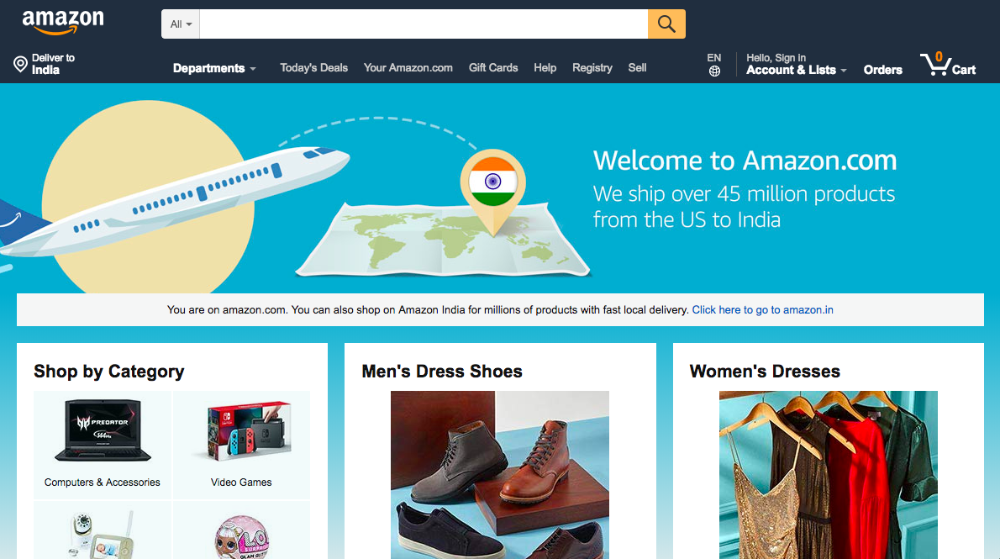
With annual net sales clocked at $232.9 billion in 2018 and over 300 million active users, Amazon has become the largest online retailer in the U.S and is one of the top retailers in the entire world. The CEO of Amazon, Jeff Bezos, is the world’s wealthiest man.
Unlike e-bay, Amazon is not solely an online marketplace but also a retailer that sells its own products.
It also offers other services like cloud storage (Amazon Drive), cloud computing (Amazon Web Services), content streaming (Amazon Prime), payment processing (Amazon Pay) and so on.
Another difference is that Amazon has no auction system like e-bay and sellers only have the option to sell their goods at fixed prices.
Although Amazon has more of a reputation for selling brand new, generic items with mass-market appeal than eBay (which people think of as more of an online garage sale) it’s still another online platform that can help you to sell your pre-owned items.
A key advantage with selling on Amazon is that you can use the company’s FBA (fulfillment by Amazon) service, which greatly reduces the volume of the work that you need to do to sell your items.
In fact, with FBA, all you have to do essentially, is round up the items you want to sell, put the items in a box, tell Amazon what’s inside the box, print out a shipping label, and then arrange for Amazon to pick up the box from your door.
Once Amazon has the box with your items, they’ll list the items on their product pages and will ship them for you if they sell. They’ll also handle any issues that arise post-sale so you won’t have to deal with any of that headache.
Any time one of your items is sold, Amazon will notify you and will deposit the proceeds from the sale directly into your bank account.
Of course, you’ll have to pay Amazon a higher fee (they take about a 15% cut) for the convenience of this service, but if you’d prefer that than doing all the hard work yourself, then FBA could suit you very well.
Other than the commission you pay to Amazon, the only fees you have to pay when selling through FBA are a small fee for the storage of your items, and another small fee for shipping and handling.
To get started with selling through FBA, you’ll want to first set up a freeindividual seller account (the other option is a professional seller account, which would cost you $39.99 per month).
The individual seller account lets you sell up to 40 items per month, so unless you have hundreds of things to sell, it should suit you just fine.
To take things from here I’d recommend that you follow this step-by-step guidefrom Lifehacker.
The initial process of getting everything set up is admittedly a bit involved but once it’s all done and dusted you’ll be able to easily hand all your stuff over to Amazon, sit back and watch the money start to trickle in.
One word of warning is that really cheap items like old books and DVDs won’t make you much money if you’re using FBA, so it’s best to only use this service to sell items that would sell for more than $5.
You might also possess certain items that you won’t be able to sell using FBA. If you don’t have a barcode or ISBN for the item Amazon might have trouble adding it to their system, although this isn’t true in every case.
Etsy
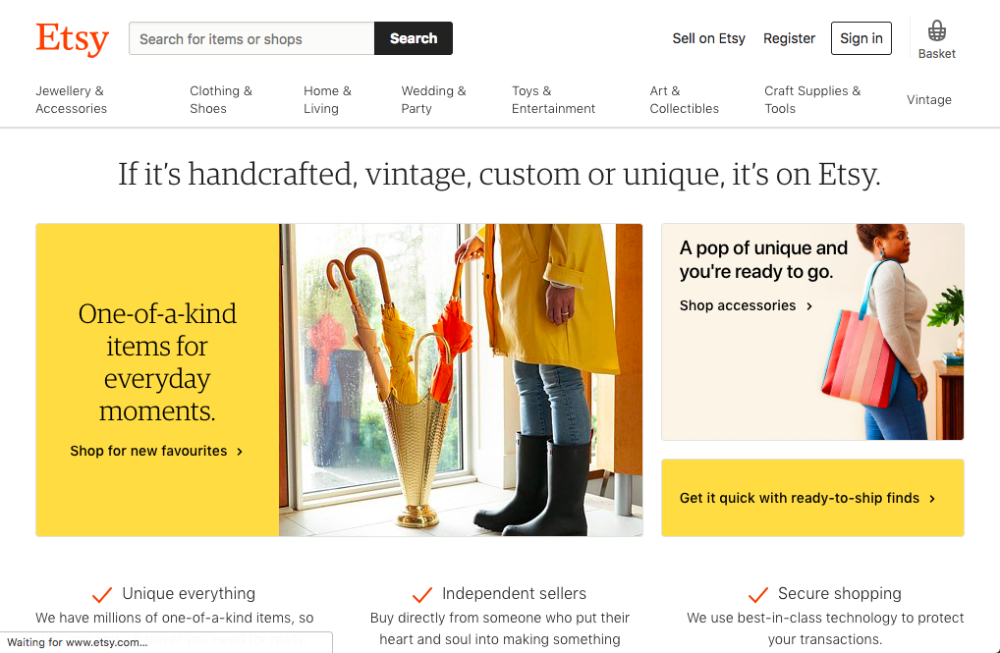
Etsy is another e-commerce platform like eBay, except that it primarily focuses on handmade items and vintage merchandise.
The site has been around since June 2005, the date of its inception in Brooklyn, New York. By 2018 the site had 2.1 million active sellers and 39.4 million active buyers, and annual sales volume had reached 3.9 billion US dollars in the same year.
Etsy is a great place to sell any unique, custom-made or otherwise difficult-to-categorize items that you might struggle to sell on other online platforms.
It’s also great for selling any items that fit into categories like arts & collectibles, craft supplies & tools, jewelry & accessories, home & living, wedding & party and toys & entertainment, Etsy would be a great place to try to sell them.
Etsy lets you easily set up your own customized online shop using its intuitive set-up wizard, giving you instant access to a ready-made online marketplace.
The platform charges a fee of $0.20 for each item listed (listings stay up for 4 months unless sold before then) and a transaction fee of 5% for any item sold, plus a Paypal processing fee if you use that payment option.
Craigslist
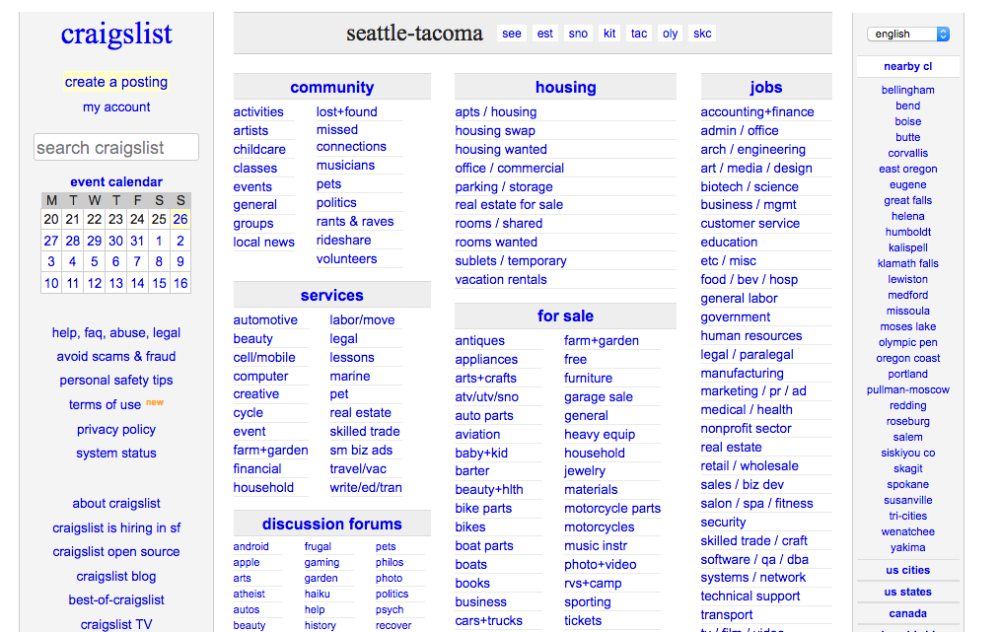
Almost everybody living in the U.S. has heard of Craigslist and many people from outside the U.S. know about it too.
Originally set up back in 1995, it’s the biggest classifieds website in the U.S, with a user base of over 60 million. The site receives approximately 50 billion page views per month.
Although the site was launched in the U.S, it now has a global reach, with more than 700 local sites in 70 countries around the world.
Whatever it is that you’re trying to sell, you can post an ad for it on Craiglist and wait for somebody to bite.
Although there are a few exceptions, it’s generally free to post ads on Craiglist, so you shouldn’t have to worry about fees.
Due to the lack of regulation and no dispute resolution process, fraud is much more prevalent on classified sites like Craiglist than on more regulated platforms like Ebay and Amazon.
For that reason it’s recommended that you only accept payment in cash from the buyer in person when you’re handing over the goods.
This is why it’s best to only do business with local buyers on Craiglist, as you won’t be able to safely transact with somebody that’s not able to meet you in person.
It’s also a good idea to meet the interested party in a public place and it would do no harm to bring a friend along with you. Some people use police station parking lots to carry out transactions.
Although transacting with the buyer in person is still not infallible, it at least puts the power in your hands.
On the other hand, electronic forms of payment or wire transfer services like Western Union put the power in the hands of the fraudsters, so you should never accept these.
Other payment methods like money orders and cashier checks are also unsafe, as these can be easily counterfeited. Some con-artists will even go to the trouble of including holograms and watermarks to make them look authentic.
If you do have to accept a money order however, wait until the funds have cleared to your bank account before sending the goods.
An extremely common scam that targets sellers on many these classifieds websites is the phony escrow service scam.
It begins with the buyer sending the seller a fake e-mail purporting to be from Paypal or some third party escrow service that has a strong reputation.
The e-mail will claim that the buyer has made the payment for the item and that Paypal (or whatever escrow service) is temporarily holding the funds until the item has been shipped.
Many people fall for this scam because they trust Paypal and other similar services. The victim ends up shipping the goods and only later realizes that the e-mail was not sent by the escrow service at all, and that no payment has been made for the goods.
Another variation of the scam is where the e-mail is actually sent by the escrow service, but it’s a fraudulent company. The majority of these third-party services are actually run by criminals.
Luckily these types of scams are often easy to spot. One of the dead giveaways is if you notice a lot of spelling mistakes and grammatical errors in the fake e-mail.
Apparently, just five gangs in Nigeria are behind most Craiglist buyer scams.
Perhaps the most effective Craiglist scam is the fake check scam, where a fradulent buyer, who is normally a Nigerian scam artist, quickly sends the seller a fake check via UPS or FedEx from a U.S address, which reassures the seller that he is dealing with a local buyer.
The Nigerian scammer accomplishes this with the assistance of accomplices in the U.S who are colluding as vital cogs in this very profitable operation.
The counterfeit check that the buyer receives is printed with professional check-writing equipment to make it look legitimate, and will have all the necessary watermarks and markings to fool the bank that cashes it.
The check also has a greater value than that of the item being sold, and this is because the buyer needs the seller to use the excess amount to pay a “mover” agent via Western Union, because he can’t collect the item himself.
Once the check is received the seller asks the buyer to ship the item and to send the excess amount to the “mover” agent via Western Union. The counterfeit check ends up bouncing and the seller ends losing his goods and a significant sum of cash too.
We have our own experience using Craiglist to sell, although in our case it was when we were already on the road that the platform came in handy for us.
After our 2,000 + km journey motorbiking through Vietnam, our tourist visas were due to expire shortly and we successfully used Craiglist to quickly sell our automatic scooter for $250 to a Russian couple in Hanoi.
We met the interested couple on the street completely by chance (we had not arranged to meet them) one day outside a popular backpacker hostel in Hanoi and they recognized our bike (which we were trying to sell to someone else at the time) from the photos in the ad that we had posted on Craiglist. They were immediately ready to buy.
The guy handed us a fat stack of dollar bills and we handed over the bike, helmets, bungee cords, documents of ownership and keys, before going our separate ways. It was a very smooth and quick transaction.
Gumtree
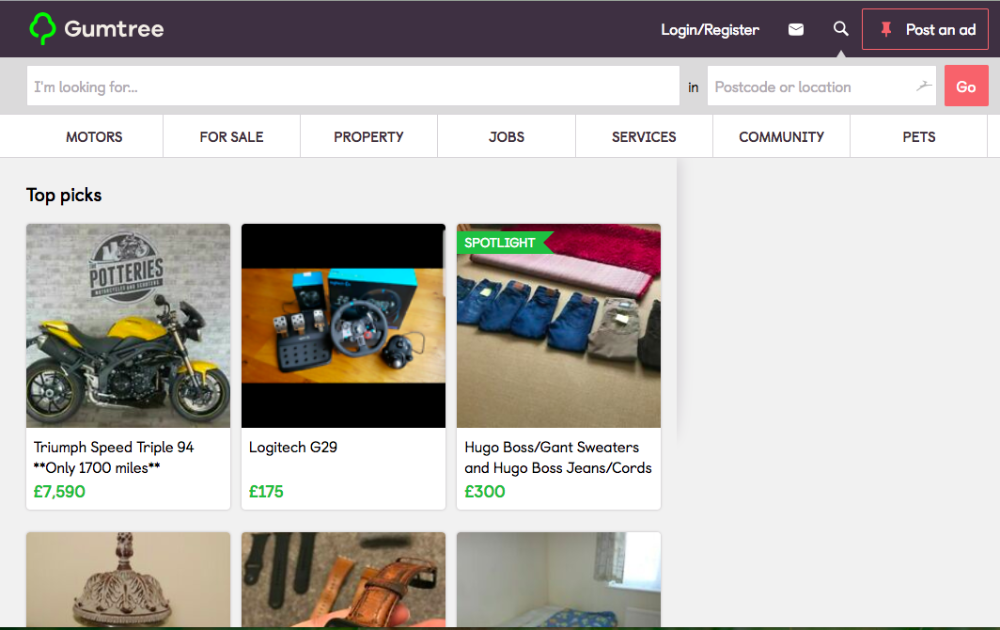
Gumtree is a London-based classifieds site that was set up back in 2002 by two UK entrepreneurs focusing on homes.
It was sold to eBay in 2005 and is now the number one Classifieds site in the United Kingdom, Australia, South Africa and Singapore, and received 16.4 million monthly visitors in 2018.
Gumtree also has website domains in many other countries including Ireland, Poland, France, Germany, Italy, Canada, the United States and Hong Kong.
Like other classified ads websites, Gumtree lets you create ads and sell your personal stuff online for free (although you can pay a little something if you want give your ad more oomph).
All kinds of things can be sold on Gumtree and categories on the site include cars and vehicles, properties, pets, stuff for sale, community, jobs and services.
As with other classified sites, you can greatly lower the risk of getting scammed by only transacting with local buyers in person and only accepting cash as payment for your items.
Other local classified ad sites
We’ve only listed the major ones but there are many more local, region-specific and country-specific classified ads websites where you can try selling your stuff.
For example in Ireland people use adverts.ie, donedeal.ie and several other similar websites. If your item is not selling on one site, post the same ad on several others to improve your chances of a sale.
Facebook Marketplace
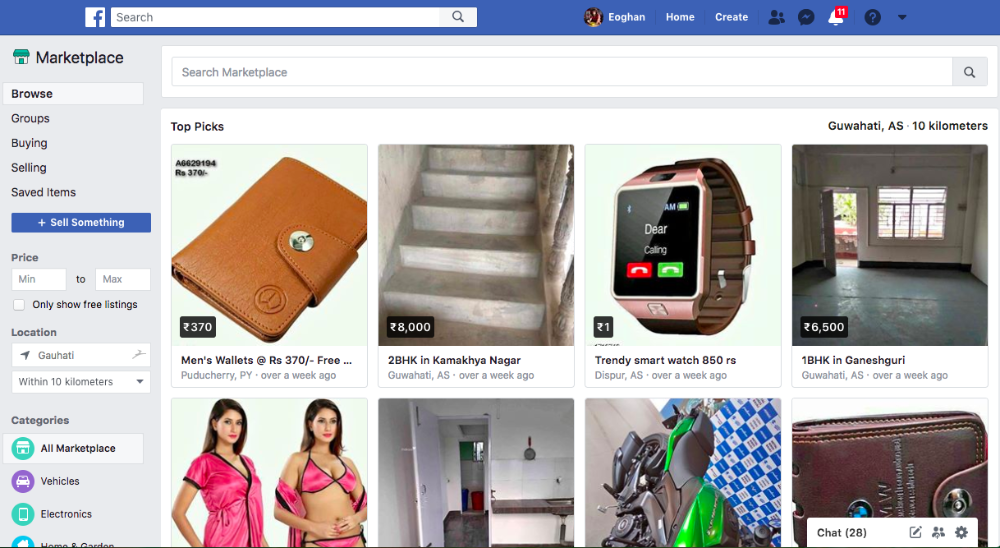
Facebook originally only had local buy and sell groups where you could post ads for items you were selling for other group members to see.
It now also has it’s own dedicated marketplace that lets you post ads and message interested buyers to arrange the exchange of the goods and cash.
You can access Facebook marketplace on both desktop and mobile devices by clicking on “Marketplace” in the main menu.
It works much like any classifieds site, except that there’s an added social element, where the buyer and seller can view each other’s Facebook profiles and can message each other using Facebook Messenger.
When you’re creating a new ad you can set your location so that your ad only gets attention from local buyers who you can meet up with and receive payment in cash from.
Sell through app-based marketplaces
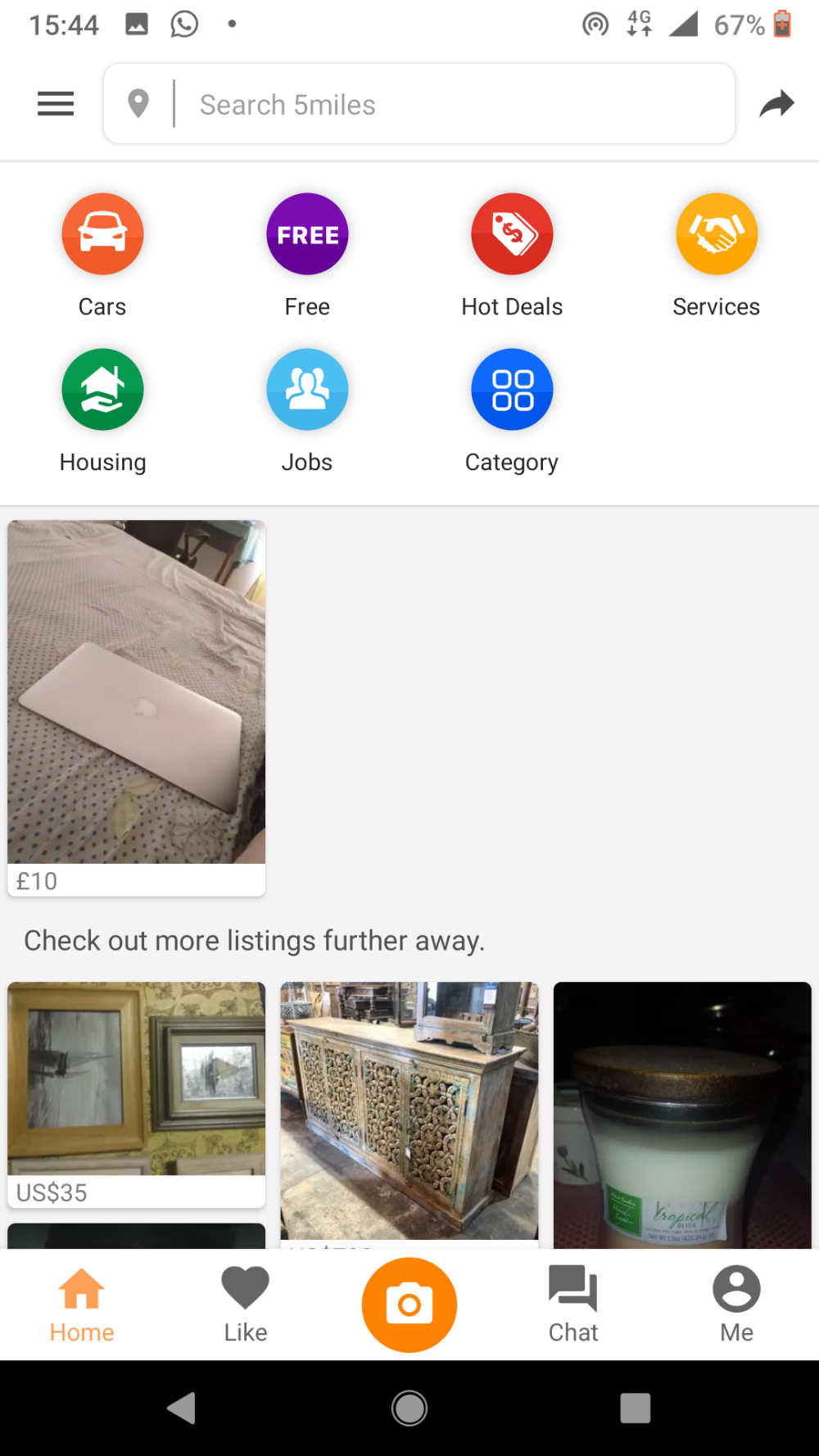
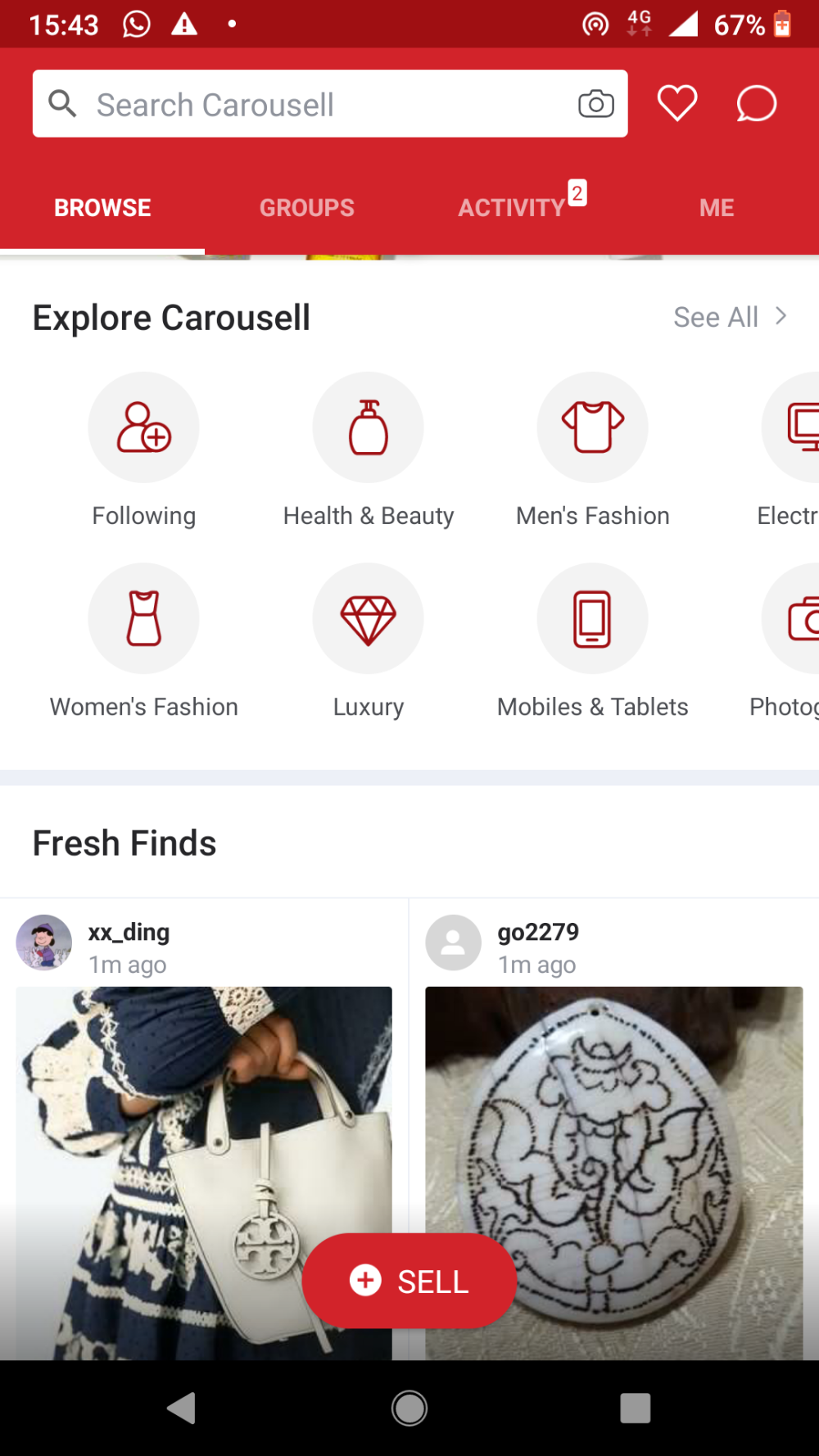
There now exists a relatively new league of local buy & sell platforms for second-hand goods that are either exclusively app-based or mobile-first.
Some of these apps are very general marketplaces with dozens of item categories, while others are more specialized.
These apps have been developed by various startups and some of them now threaten dethrone several of the aforementioned giants from their pedestals.
Most of these apps possess a number of distinctive elements and features that make them safer and more user-friendly than the incumbent classifieds sites, and many people have had good success selling on them.
The first notable characteristic of these apps is that they’re designed to create a safer and more trustworthy marketplace.
They achieve this by:
- integrating user rating/review systems into their platforms. Users can also report scammers, who are quickly banished from the community
- getting users to verify their identify by uploading a profile picture and connecting their Google accounts and social media profiles
- removing illegal (guns, drugs etc.) or offensive listings (e.g human servants)
- suggesting safe, well-lit and monitored locations for people to meet and transact
All these measures help to make users less anonymous and help to weed out any unsavoury elements.
These buy & sell apps also tend to be more visually appealing than the likes of Craiglist or Gumtree, with home scroll feeds populated by large, eye-catching images instead of plain text.
They also have more of a social element and community spirit, where users can follow other profiles they like, comment on listings and easily chat to each other within the apps, with no need to exchange e-mails or phone numbers.
Overall the vibe in these apps is more akin to that of Instagram or Pinterest than just a soulless marketplace for commerce.
Some are just set up to facilitate in-person transactions within local communities, while others have introduced features like shipping options, integrated wallets and in-app card payments, which allow users to transact nationwide or even globally.
From a seller’s perspective, these apps make the process a breeze, allowing users to snap instant photos (sometimes videos also) of the item they want to sell from the app itself, add a short description and specify the item’s brand, condition, price, delivery method and other details.
Pretty much all the apps allow for free listings in the majority of item categories, and usually make most of their money from their optional promotional tools that help users to boost sales, and/or by charging sellers or buyers a small transaction fee.
Most of these apps will need to know your location so that they can display your listings to the right users, depending on the radius that the user has set for listings to display in his feed filter settings.
OfferUp
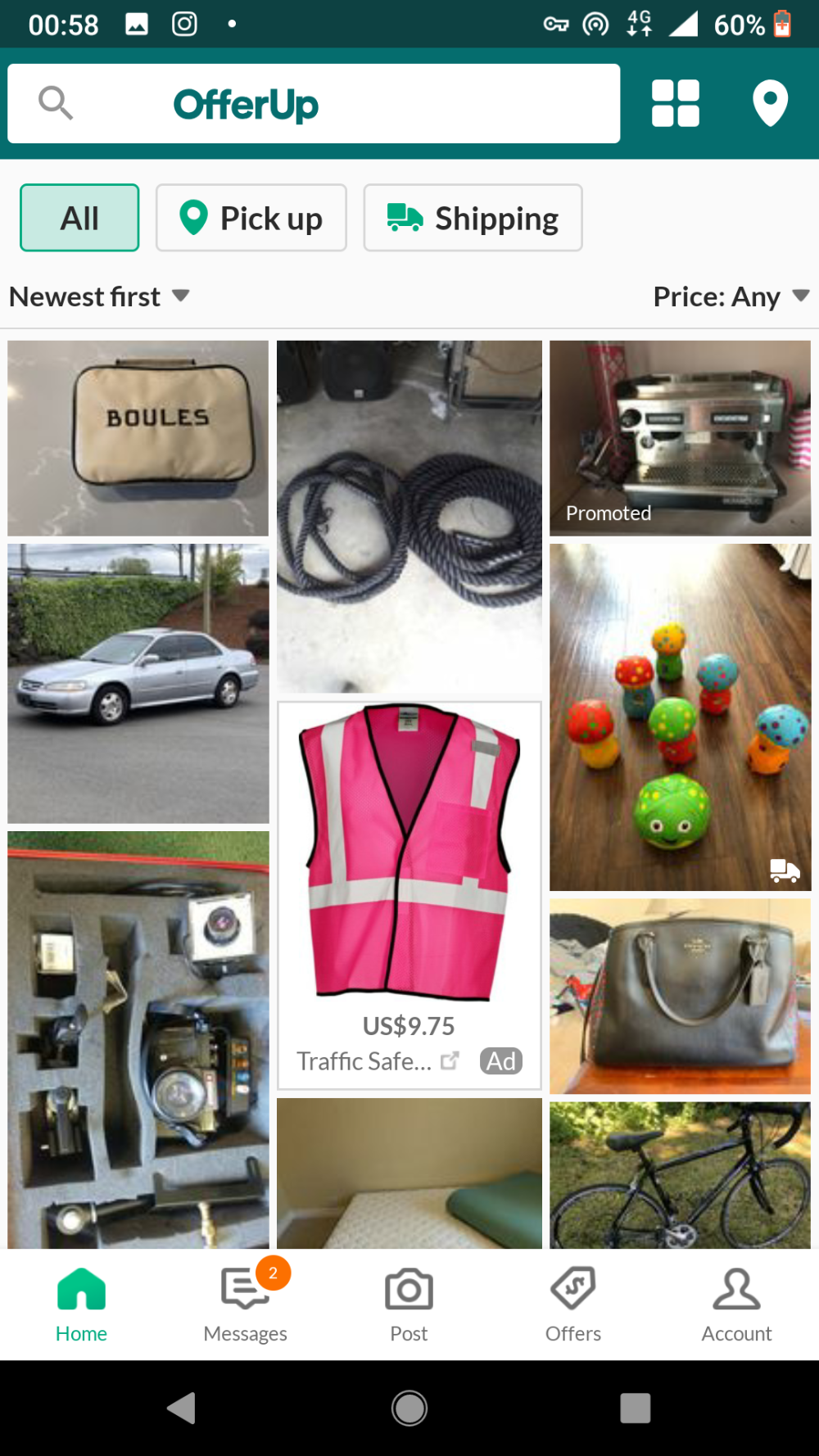
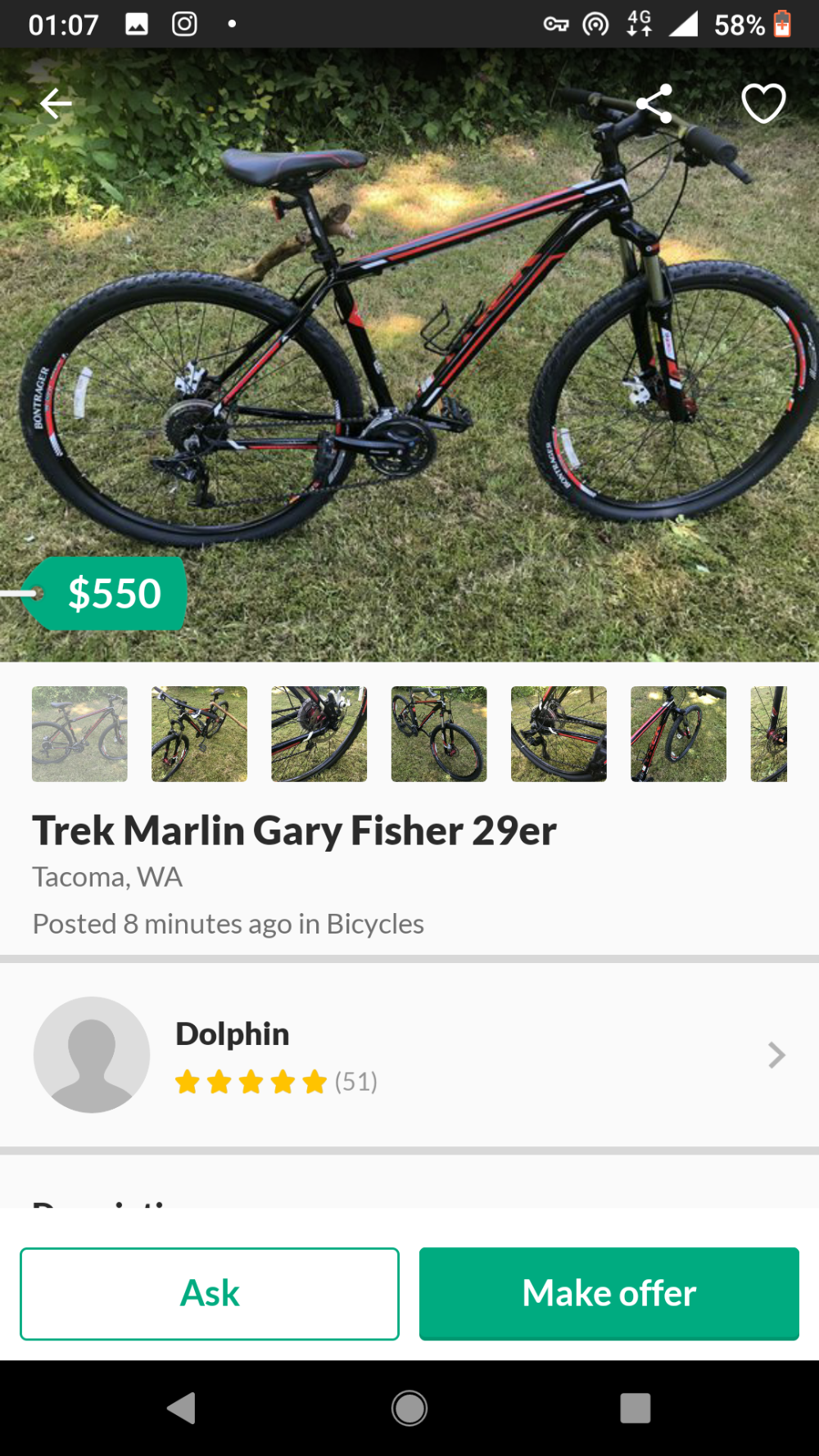
With over 42 million registered users and a 4.6 star average rating in Google Play Store, OfferUp is one of the biggest and fastest growing
app-based marketplaces for the buying and selling of second-hand goods locally.
OfferUp is a very general marketplace where users can buy and sell clothing, shoes, vehicles, furniture, baby items, electronics, exercise equipment, jewellery, tools, toys, appliances, collectibles, arts and crafts, CDs and DVDs, books, pet supplies, musical instruments and tons of other stuff.
OfferUp puts a lot of emphasis on safety and users get their ID and phone number verified through a third party company called TruYou, as well as the ability to link their profile to Facebook and receive star ratings.
Creating a new listing on OfferUp is free and is as easy as taking a photo or set of photos of the item that you wish to sell, as well as providing the other relevant details.
Buyers can use filters to set the maximum radius for items that show up in their picture feed. The default setting is a 30-mile radius but this can be lowered to a 5-mile radius if a buyer only wants to view items for sale in their locality.
Buyer can also switch to a separate “shipping” tab to only display items that are located outside their area.
All communication with interested buyers can be done via the in-app messaging system, so you won’t have to share your phone number or e-mail address to anybody.
If the buyer lives locally you can arrange to meet him or her at a safe public location like a shopping centre or police station.
If the buyer lives further afield you can ship the item via USPS, in which case he or she will typically pay the extra shipping costs. Also, items can only be shipped if they weigh less than 20 lbs and cost less than $500.
Payment is either made in cash when the two parties meet or, in the case of shipped items, through the in-app payment system. Currently buyers can pay via debit card, credit card or Google Pay.
As a seller you receive your payment into your OfferUp account two days after the buyer receives the shipped goods, provided that the buyer is satisfied. You can then cash out from OfferUp to your bank account or debit card.
As a seller you only pay a service fee to OfferUp on shipped items, and the fee is 7.9% of the item’s final selling price.
After you successfully sell an item you can mark it as sold and you get a chance to rate the buyer and vice versa.
Letgo
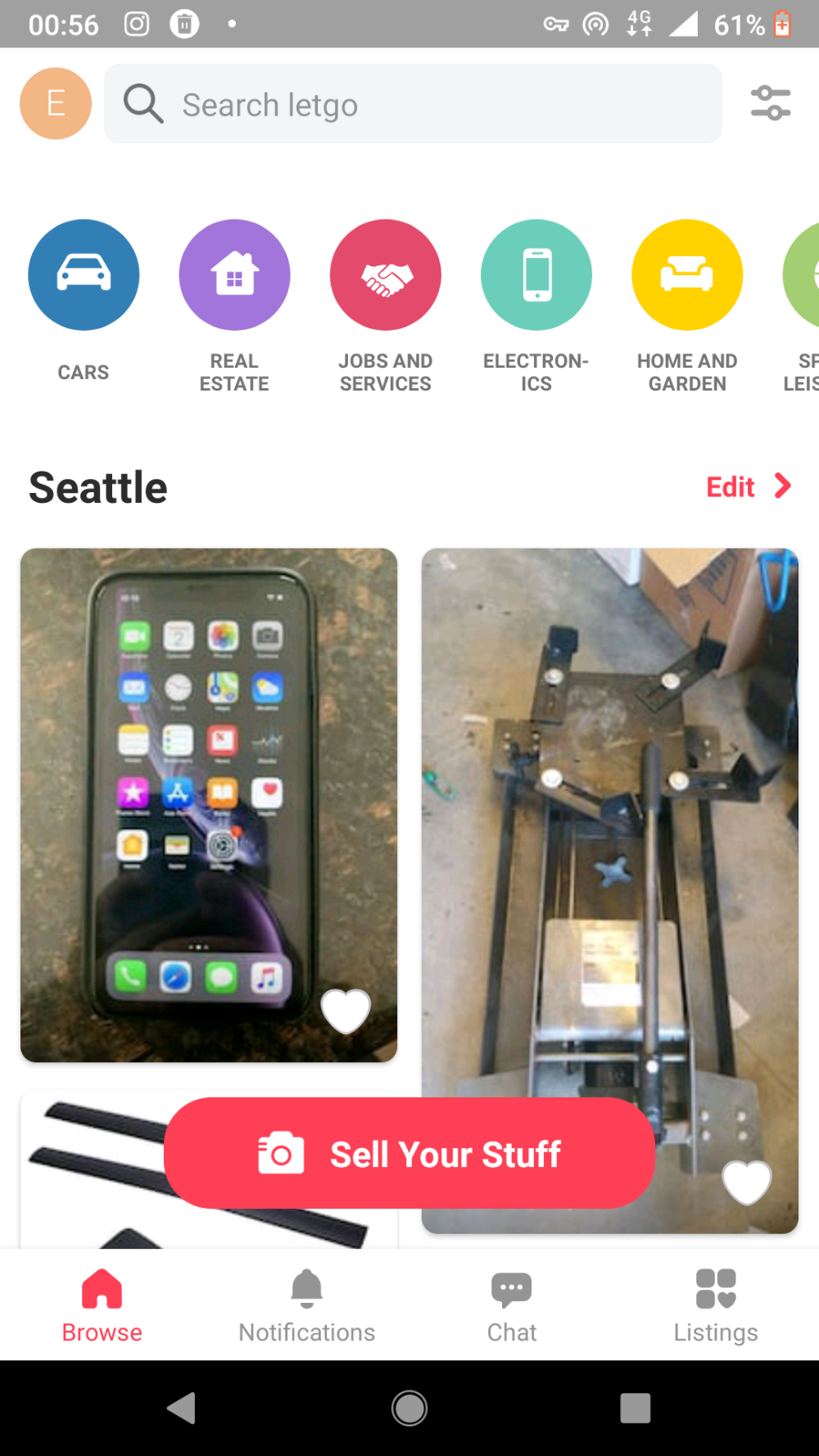
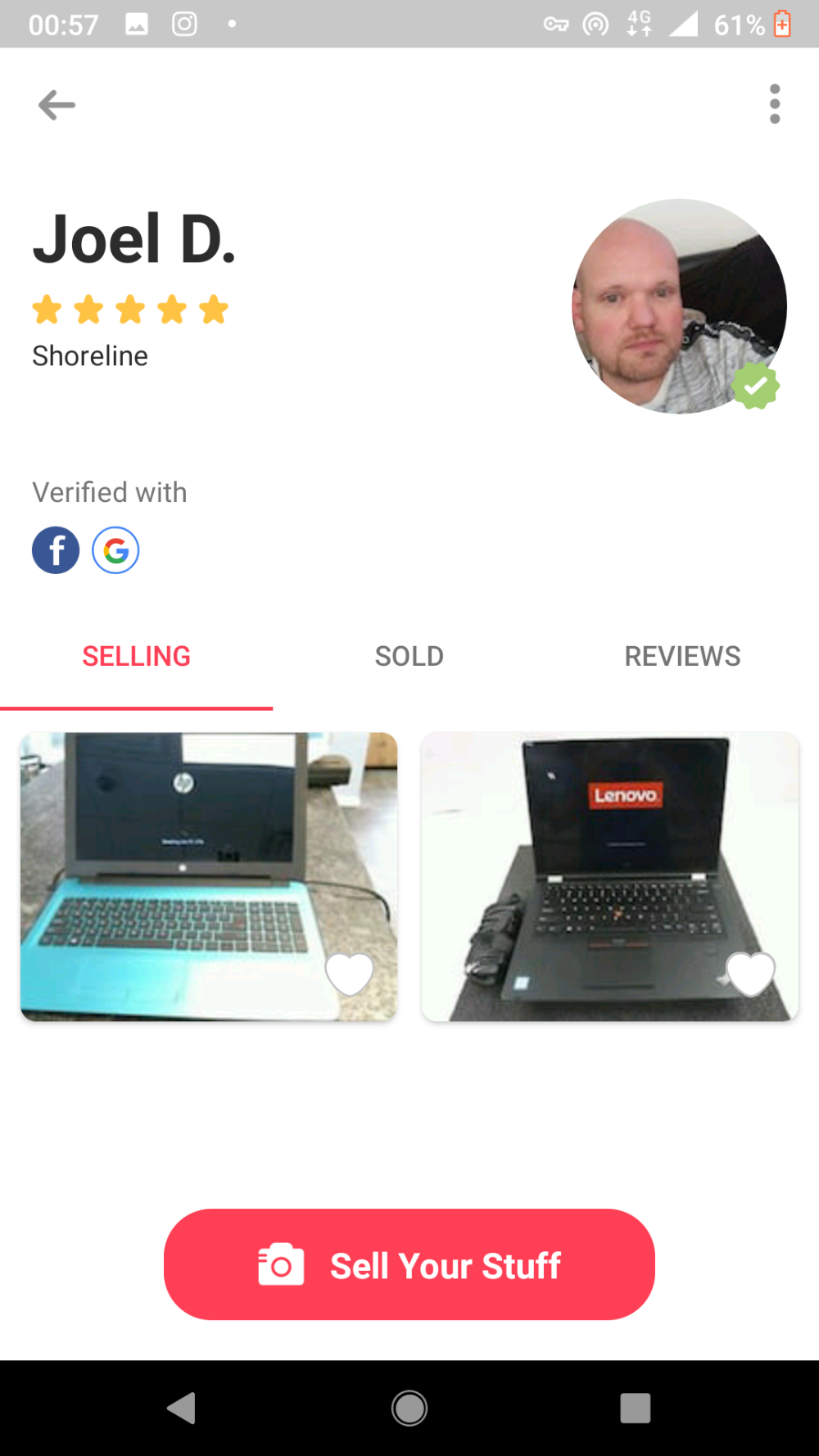
The name sums up what this app is all about; letting go of stuff you no longer need.
Having much in common with OfferUp, Letgo is another app-based, peer-to-peer marketplace for the buying and selling of a wide range of pre-owned goods, as well as jobs and services.
The company merged with Wallapop, another mobile classified ads start-up, in may 2016.
Unlike Offerup, which is currently confined to the U.S. market, Letgo has already expanded internationally to more than 35 countries, although most of its users are still based in the U.S.
The Letgo app has been downloaded over 100 million times to date and has a 4.5 star average rating on Google Play Store, although many sellers claim that they get a better response from buyers on Offerup.
When you get down to the nitty-gritty, Letgo works in much the same way as Offerup; users scroll through an image-based feed of items for sale, which they can refine by using filters for item category, location, distance and price.
However, there are a few subtle and not-so-subtle differences between the two apps. We don’t want to repeat ourselves by discussing what’s the same so we’ll just focus on the main differences here.
One noticeable difference when selling on Letgo is that the app generates titles for your listings automatically thanks to its cutting edge image recognition technology. The auto-generated titles can often be surprisingly accurate too.
When setting the price for your item on Letgo there’s also a switch that you can toggle if you want to give the item away for free (you know, if you’re feeling particularly generous).
User profiles also gain credibility in a slightly different way on Letgo. The app assigns each user a “verification score”, which can be increased by completing various actions like uploading a photo and verifying your email, phone number, Facebook profile and so on.
These actions earn you varying amounts of points and when you’ve earned 50 points you receive a silver verification badge, while 80 points earns you a gold badge.
Like on Offerup, Letgo profiles have an average star rating based on feedback from other users but unlike the former they display written user reviews as well.
While Offerup fully supports shipping to buyers further afield, Letgo discourages it and only endorses face-to-face exchanges with people in your area.
Unlike Offerup, Letgo does not process any payments or issue any refunds. It recommends that sellers only accept payment in cash or via Paypal.
Letgo also does not charge sellers any fees for listing or selling, unlike Offerup, which takes a cut of the final sale price for shipped goods.
The platform does however offer optional “featured listings” for sellers, which bump listings back up to the top of the feed for renewed visibility.
The bottom line is that it’s worth giving both apps a try to see which one works best for you, unless you live outside the U.S, in which case Letgo might be your only option.
Bookoo
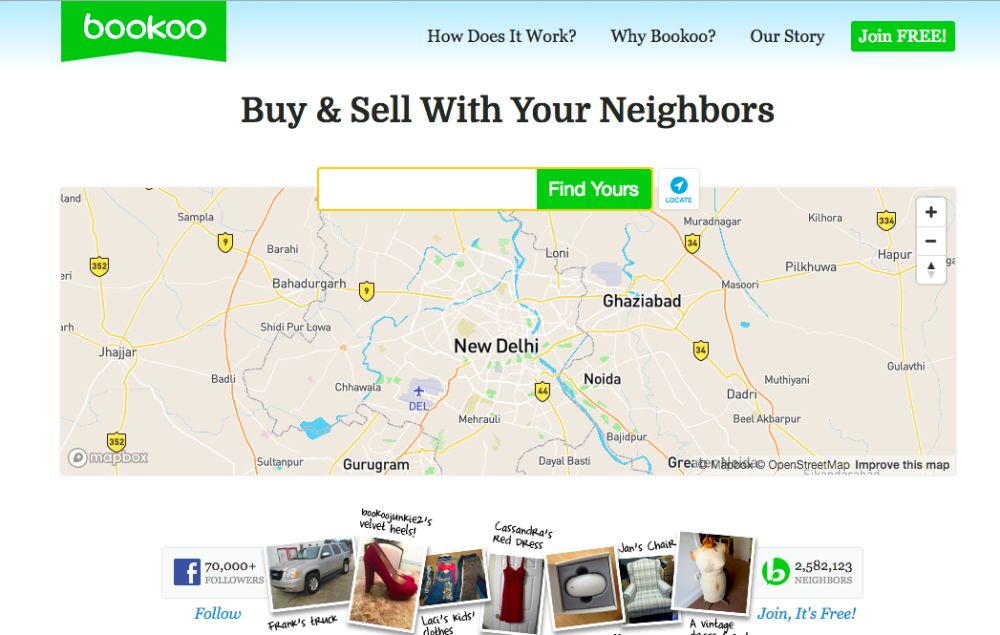
Founded in Houston back in 2004, Bookoo, with apps for both Android and iOS, is a general online classifieds platform for buying and selling with your neighbours.
It’s a bit like Craiglist but more local and family-oriented, with item categories running the gamut from antiques to toys & games.
The platform operates all across the U.S, as well as in parts of the U.K, Germany, Italy, Belgium, Spain, Portugal, Korea, Japan and Kuwait.
Bookoo was designed by yard sale fans with the goal of making it easier for families to shop for goods at bargain prices without having to drive around town and consume precious family time.
It’s an easy-to-use platform, where sellers can list the items they’re selling for free and can use the messaging system to arrange to meet with interested buyers to exchange goods for cash.
If you want to increase your chances of selling you can upgrade to an unlimited account for $7 a month (discounts are available if you pay upfront for 3 or 6 months), which unlocks additional features like unlimited listings (vs. a maximum of 10) and 5 pictures per post (vs. one).
Another nice feature of Bookoo is that you can use it to advertise a yard sale that you’re holding. You can pinpoint the yard sale location on a map, as well as specify the days of the week when it will take place.
Carousell
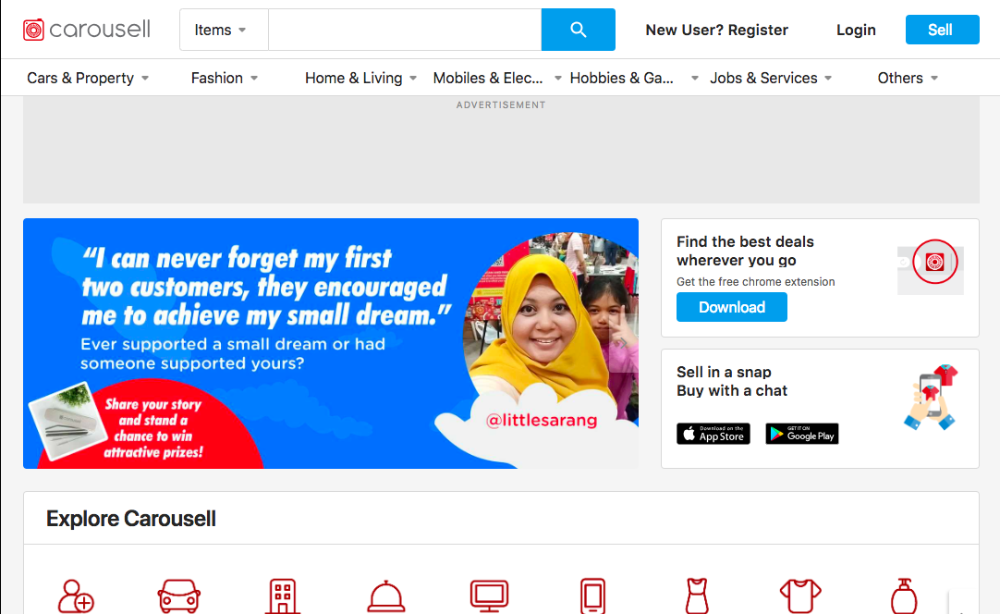
Carousell is another very general, snap-and-sell, mobile-first marketplace for second-hand goods that started out in Singapore and has since expanded to several other countries, including Malaysia, the Philippines, Indonesia, Taiwan, Hong Kong, Australia, New Zealand and Canada.
The main concept underpinning the platform is to make money while decluttering your life.
While it’s possible to use the platform to sell to people overseas, it’s moreso designed to sell to people in your own couhtry and local community.
Sellers can list most items on Carousell for free (there are only free listing quotas in the car and property categories) and can easily communicate and make arrangements with buyers via the in-app chat function.
The method of payment is negotiated between both parties, with suggested methods including cash, bank transfer or PayPal.
There’s also now an in-app payment system called CarouPay, which makes transactions more secure for both parties and ensures more commitment from buyers after ordering.
CarouPay sets you up with your own wallet linked to your profile, which you can cash out from via debit card or by linking your bank account.
The method of delivery is also decided between the buyer and seller, whether the two decide to meet in person or have the goods shipped.
In Taiwan only, sellers can ship items to a 7-11 outlet for the buyer to collect within 7 days. 7-11 charges a fee of NT$60 for this service, which may be borne by either party, depending on the agreement made between them.
If meeting up for a transaction the app has a handy feature called multi-meetup locations, where you can share up to 10 locations where you’re available to meet for each listing. This cuts down on annoying questions from buyers.
Although the app is basically free to use, there are various promotional tools available that can be paid for with Carousell coins, which can be acquired via in-app purchase (5G users however can buy them via Paypal or credit card) and are non-refundable once bought.
The two main promotional tools for listings are spotlight, which increases the visibility of your listing for a set period of 3-30 days, and bumps, which bumps your listing to the top of users’ feeds. There are three kinds of bumps; instant bumps, 3-day bumps and urgent bumps, depending on how much money you want to spend.
One importance difference between the two promotional methods is that with spotlight you only pay for each click your promoted listing receives, whereas bumps always cost the same, regardless of how many clicks your item receives.
5Miles
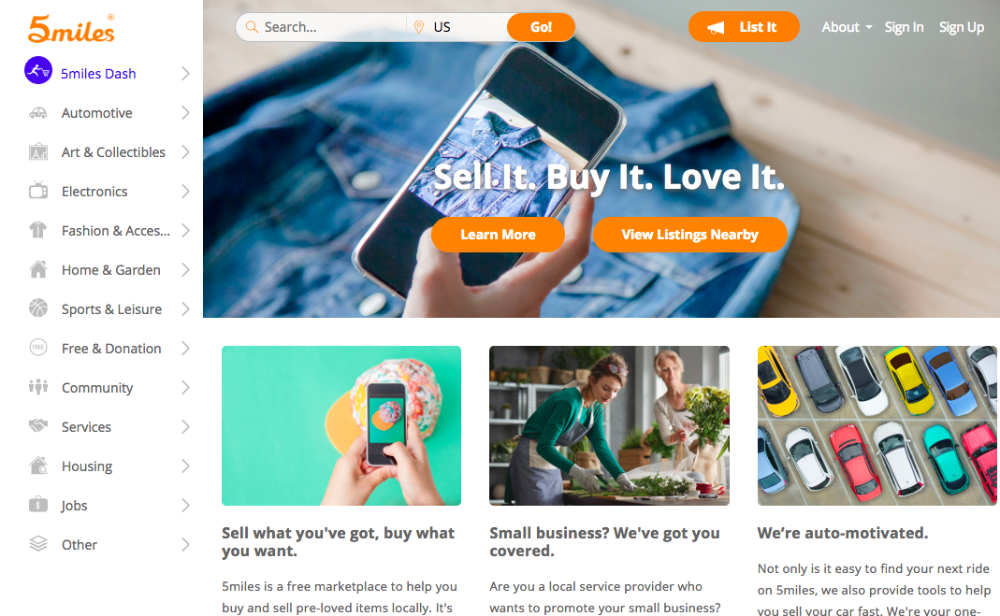
First launched in Dallas, Texas back in 2014, 5Miles is one of a number of up-and-coming local garage sale apps that have been dubbed “Craigslist Killers” by tech watchers.
It’s now one of the most popular and fastest growing used goods marketplaces in the United States and overseas, with users in over 100 countries and apps for both Android and iOS.
Listing items on 5Miles is free in most categories and it’s even possible to add a video to your listing, as well as the usual photos and descriptions.
If you want to “sell faster”, there are paid in-app promotional tools that range in price from $0.10 to $1 a day, including:
Hot deal - features your listing with a “hot deal” banner in the hot deal feed
Triple exposure - your listing appears 3 x more often in the home feed, search results and related listings
Click to call – lets you add a call button to your listing so buyers can contact you fast and easily
After you’ve put your listing up, the in-app messaging system allows buyers to easily reach out and make arrangements.
The platform makes meeting up and exchanging goods and cash in person very safe with its S.E.A.L (Safe Exchange Area Locator) feature, which recommends safe, well-lit, under-surveillance locations to meet up.
5Miles also lets you offer shipping if you want to sell to buyers located anywhere in the U.S that’s not close by.
The app will give you an estimate of the base shipping prices and shipping times. You can use a shipping vendor of your choosing, although 5Miles prefers it when people use USPS and FedEx.
When shipping an item you will receive payment via the 5Miles wallet (buyers pay with debit card or credit card), which can also be used if you don’t want to transact in cash when meeting a buyer. Allowing buyers to pay via the wallet can increase your chances of selling by up to 30%.
Funds can be easily withdrawn from the 5Miles wallet to your bank account but doing this incurs a very high service fee of 4.9%.
The platform also allows you to list and advertise garage sales in the community category, although these are considered premium listings and incur a fee of $0.99 to post.
Shpock
.png)
The word “Shpock” is derived by combining the words “shop in your pocket”. This Austrian start-up is another general, mobile-first marketplace for the buying and selling of secondhand goods, with apps for Android and iOS.
In recent years Shpock has become of the most popular boot sale apps in the European marketplace and is available in six European countries, namely the U.K, Germany, Austria, Italy, Norway and Sweden.
As with other similar apps you can create free listings and buyers can message you within the app to ask questions, make offers and arrange to meet or have goods shipped.
The platform advises meeting in person and payment in cash as the safest way to carry out transactions.
However, if you decide to ship an item, the terms are all negotiated with the buyer and payment can be made via cash on delivery with UPS, or through Paypal.
Shpock will not take any cut of your sales, but you can pay anywhere between €3.99 and €18.99 to have your listings promoted.
You have a choice between a 3-day, 7-day or 15-day bump. You can choose to bump your listings in just the home screen or you can pay more to have them bumped everywhere (home screen & search results).
Varage Sale
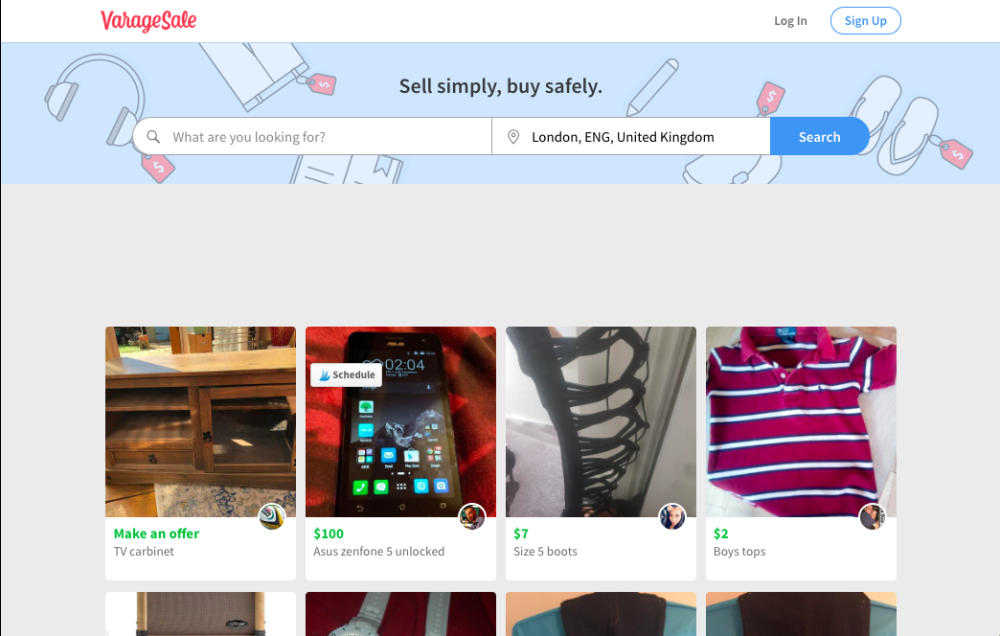
Toronto-based startup VarageSale is another popular virtual garage sale platform with users across the U.S and Canada, as well as in the UK, Germany, Italy, Japan and Australia, with apps for both Android and iOS.
This platform puts a lot of emphasis on safety, with admins manually reviewing every new member to make sure they have a real name and photo.
After you sign up to Varage Sale you can enter your location and join one of its many geography-based communities in the area that you live and work.
Listing items or yard sales on the platform and even bumping them is completely free, although you can only bump an item once every 2 hours.
As a seller you can message buyers within the app and reserve items for people after they’ve confirmed their willingness to buy. You then just schedule a meet-up and exchange the goods for cash at a convenient and safe meeting place.
Unlike some of its rivals, Varage Sale is only designed for transacting vis-à-vis within your local community and doesn’t accept card payments.
Chairish

Chairish is more of a specialty platform for selling chic vintage furniture, art, home décor, rugs, lamps, chandeliers and that sort of thing. Many of items listed on the site are priced at thousands of dollars.
The company currently operates only within the continental United States, excluding Hawaii and Alaska. At present there is only an app for iOS.
Listing on the platform is free, but Chairish does take a rather high cut of up to 30% from the sale price, with the remainder being paid to you through PayPal following the 48-hour return period after delivery.
There are currently two plans to choose from as a seller on the platform.
Consignor lets you have 1-9 free active listings and you pay a 30% commission.
Professional lets you have more than 10 free active listings, you pay a 20% commission and you get increased exposure on Chairish and Google.
If you decide to ship an item to a buyer, you can do it through the Chairish Drop Off & Go program, for which you pay $5-$33 depending on the size of your item.
With this program, Chairish provides you with a shipping label and you just drop it off at your nearest UPS Store, where it will be professionally packed for you and sent off fully insured against loss and damage. You can also opt for local pick-up and delivery.
Option #4 - Donate
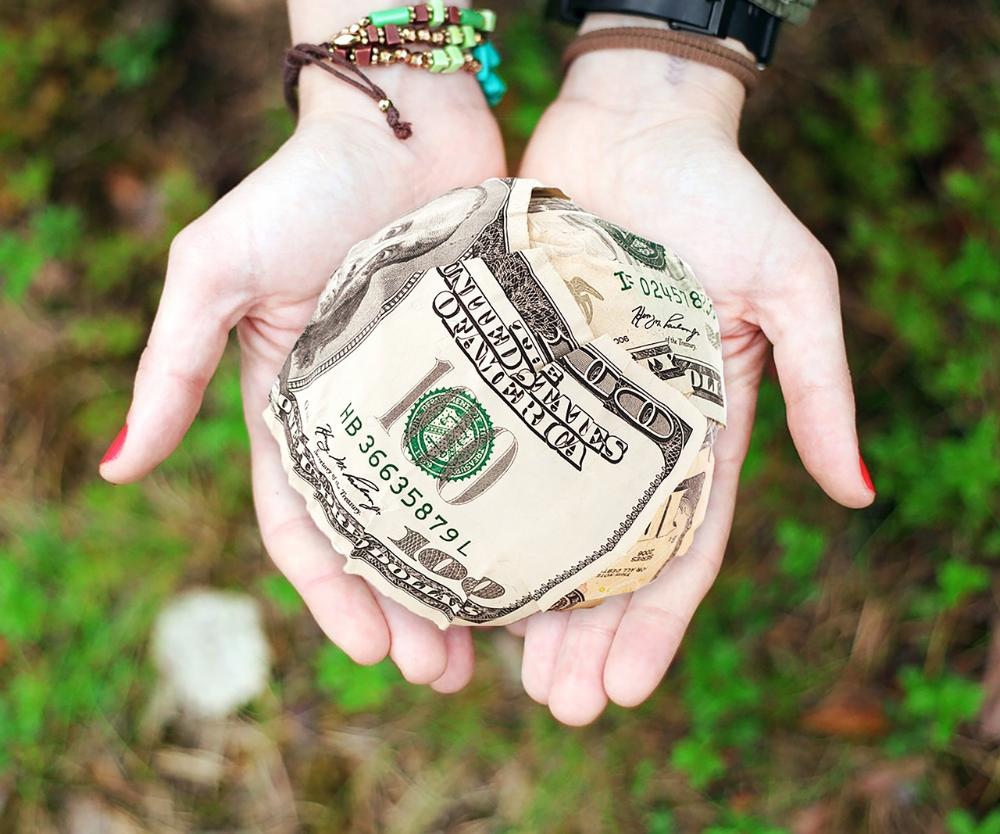
When you want to liberate yourself from something that's still semi-valuable but that is unsaleable or just isn't worth enough to justify the effort of selling it, donation is often the best option.
One of the benefits of donating, apart from the feel-good factor and the fact that you’re helping people in need and reducing landfill waste, is that, for US citizens, donations to qualified non-profit organizations are usually tax deductible.
Items that could qualify for donation run the gamut. You might donate old clothes, CDs, board games, video games, shoes, bags, books, toys, electronics, furniture, appliances, and so on. You can even donate your vehicle rather than sending it for the scrap heap.
The key here is that the item should be somewhat defective, damaged, soiled, outdated or otherwise depreciated in value - otherwise you could probably sell it for a worthwhile sum and at least fetch a few shekels for it.
However, do bear in mind that if you donate an item that is too far gone, it probably won't end up in the possession of another human being, but will be consigned to a landfill site or a recycling facility.
Even donated goods that are in excellent condition and proper working order don't always make it into the hands of a new owner, so only donate items that are in really good shape if you want to see them find a new home.
Here are a few of the ways in which you could donate your items to those in need.
Donate to people you know
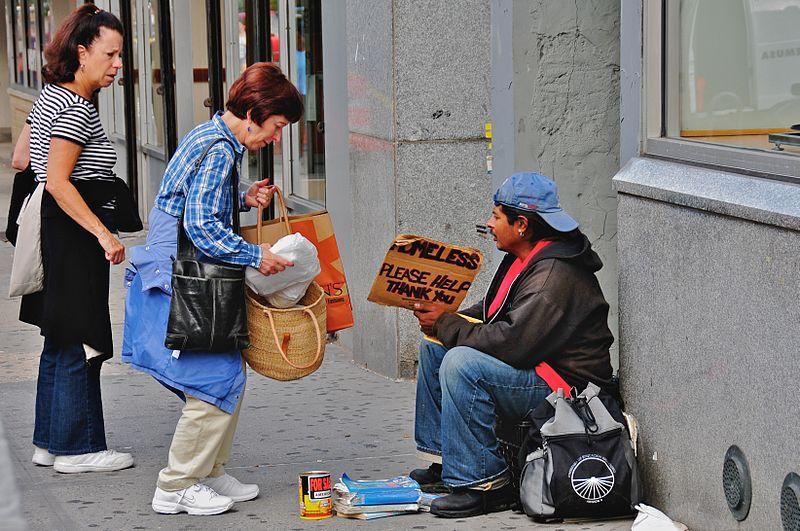
If you have stuff you want to donate, the first thing to check is if there’s anybody you know personally that could benefit from whatever it is that you’re donating. Consider friends, relatives, co-workers and other people in your social circle.
If you don’t know anyone, maybe there’s a homeless guy in your local area that you walk past every day – perhaps he or she would be delighted to unburden you of a few things?
Donate to thrift stores and charities
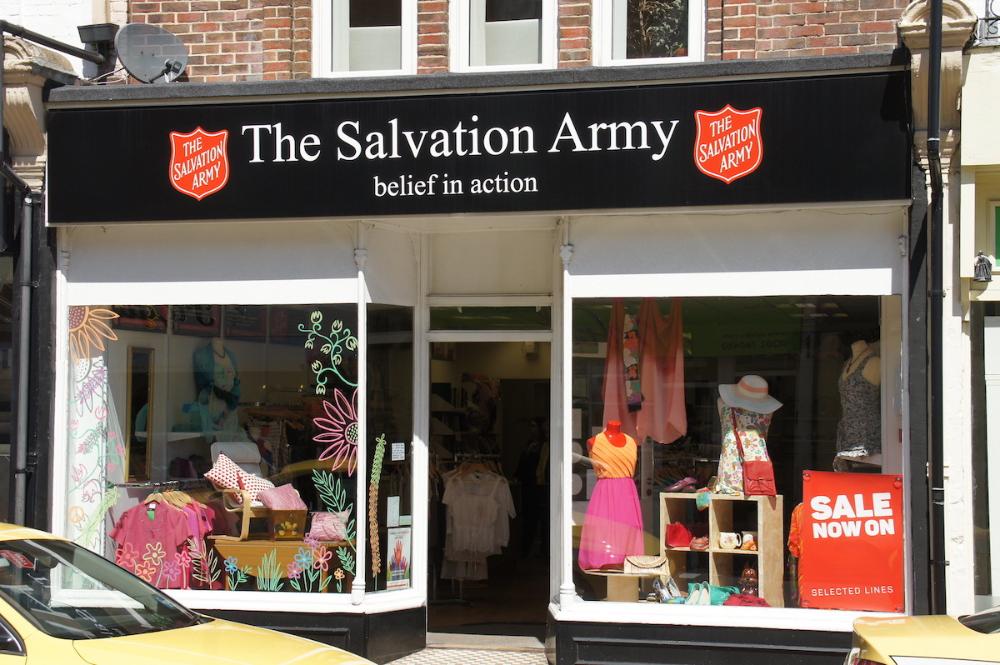
Another popular option is donating some of your stuff to your local charity shop or thrift store.
Charity shops are thrift stores that are operated by charities in order to raise funds for the causes that they support.
These charity shops will usually allocate about 70% of the proceeds from sales towards charitable causes. The remaining 30% covers the store's operating costs.
There are many such shops run by non-profits like Barnardos, Oxfam, St. Vincent de Paul, Salvation Army and countless others. However, not all thrift stores are run by non-profit organizations.
Some charities don't have their own thrift stores and will sell some of the donated goods that they receive to one of these for-profit thrift store (e.g. Value Village) that they've partnered with.
Some thrift stores and charities only accept specific types of items, such as clothes, books, tools, furniture, cell phones, cars and so on, while others will accept a wide range of items (but will still have their boundaries).
To donate you would usually just drop off your items at the thrift store itself or at a dedicated drop-off point. Be prepared for the reality that the store will probably reject some of your items.
If any of your accepted items are saleable, they will end up on display in the store at a relatively low price for consumers to buy.
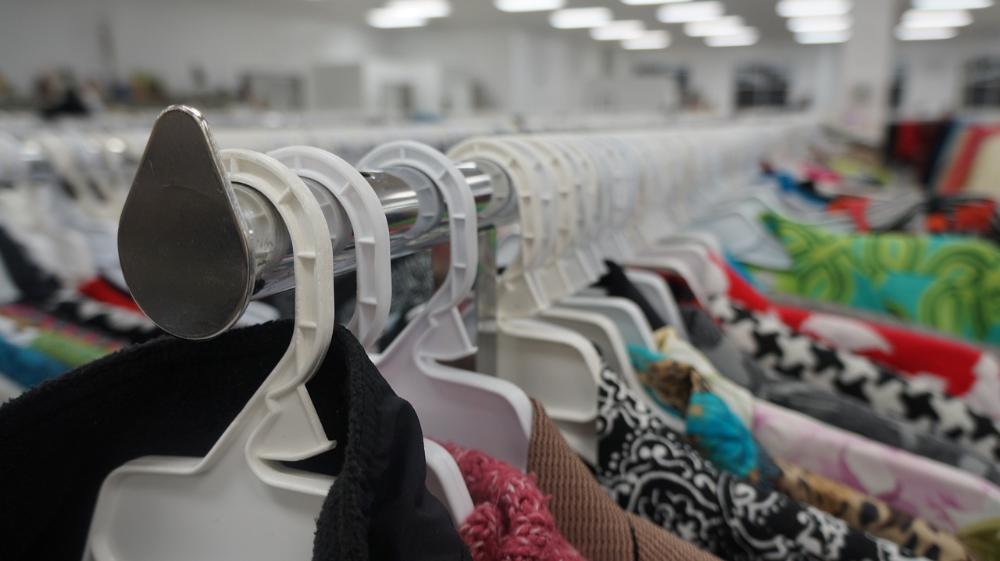
But what about the items the store accepts that are not saleable or that don't sell? Many people mistakenly assume that every item they donate to a second-hand store will end up with a new owner, but this is not the case at all.
When it comes to donated clothes for example, only about 25% of all the clothes collected by thrift stores actually sells. Only about half of all the donated clothing makes it onto shelves and only half of that will actually sell.
The other 75% that never reaches the shelves or that doesn't move from the racks after say, four weeks may be sold to a for-profit broker in order to make room for the next wave of donated items.
The broker will ship the clothes to a reprocessing plant, sometimes located overseas, where they might be repurposed as industrial rags, ground down to be used as insulation or car seat stuffing, or sold to second-hand clothing retailers in various developing countries in Africa, Asia, Latin America and South America. A large proportion of the rejects are exported to Pakistan, India, Kenya and Ghana.
It is fortunate that clothes that are rejected by shoppers in developed countries can often find a market of happy buyers in less privileged countries.
If you don't want to pay a visit to a local thrift store, another option is chuck your clothes, shoes, toys and other items into one of those unsightly, brightly-coloured drop boxes that are often placed on sidewalks or in parking lots in towns and cities.
Some of these bins are operated by genuine charities in order to provide an easy solution for people to donate their unwanted goods to the organization.
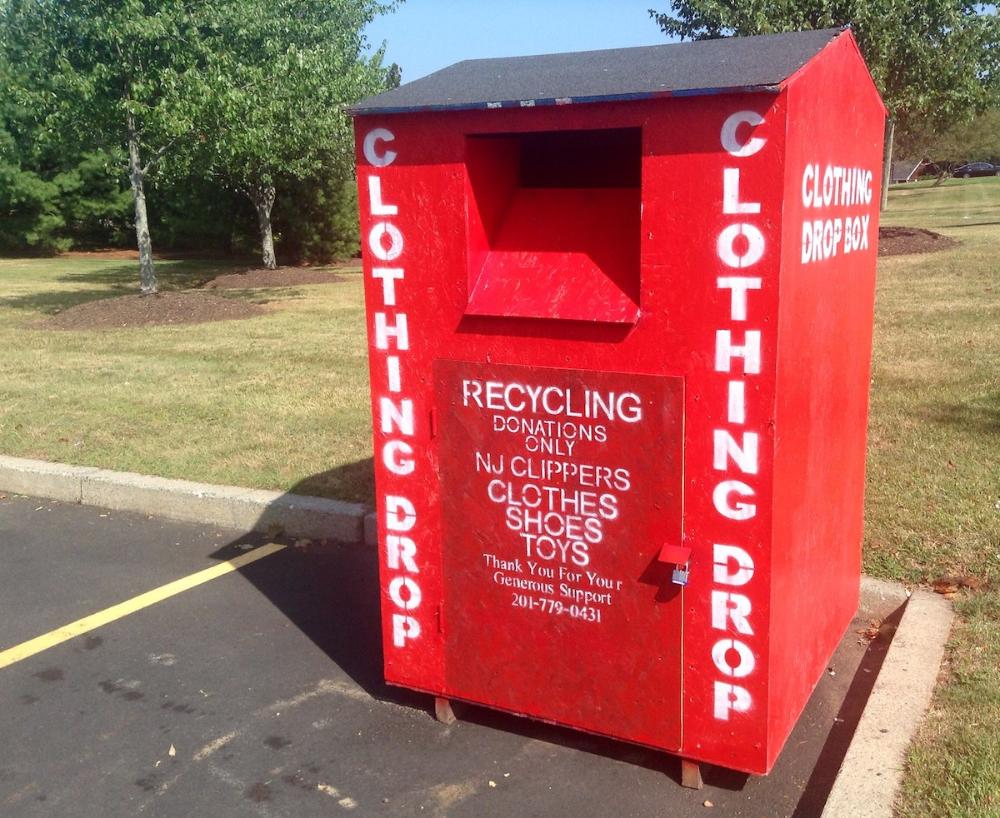
However, you need to be aware of the fact that many of these donation bins are actually operated by for-profit companies like Planet Aid and USAgain ("use it again"), masquerading as benevolent charities.
These dubious companies will even stick or paint the logos of genuine charities (some charities receive monetary bribes to allow this), as well as magnanimous-sounding slogans on the bins in order to dupe well-meaning donors.
Often these bins are illegally placed on sidewalks and become magnets for graffiti and litter. When operators are ordered to remove them by local authorities, they usually receive a deadline of say, thirty days, so they just move the bin to a new illegal location to reset the clock.
Thus the bogus donation bins end up competing with the genuine ones and inevitably beget a reduction in the amount of donated goods that the real charities receive.
Clothing that is dropped into one of these bogus donation bins is usually either sold to for-profit thrift stores, shipped directly to overseas retailers or sold to recycling companies.
In order to ensure your goods end up with real charities, it's always best to donate to them directly but if you must use a drop box, you can minimize the risk of being duped by inspecting the box for a few important details.
If the box displays details like the charity name, contact details, mission statement and the percentage of its income it allocates to good causes, that's a good sign.
If, on the other hand, the box displays scant information about the organization, it's best to steer well clear. You should also research the organization in question before donating if you know nothing about what it does.
The last option that some charities offer for donating is home pick-up. This is a convenient option if you're lazy, or you live too far from a drop-off location, or you're donating goods that are too heavy or awkward to transport by yourself to the drop-off point.
Non-profit organizations will usually either give your donated items directly to people in need, or will use the proceeds from selling any surplus items or recycling any defective items to fund their causes.
There are local thrift stores as well as the more widely known non-profit organizations and thrift store chains that have a nationwide or even an international presence.
To find the local ones Google Maps is your friend. Just try search strings like “thrift shops near me”, “secondhand shops near me”, “charity shops near me” and so on.
In the next section we've also compiled a list of the most widely known organizations that will be happy to relieve you of your stuff before you hit the road.
Organizations to donate in one stop
The following organizations have a wide reach across the U.S. and will accept the majority of items that you might wish to donate. Further below, we've also listed several charities that are interested in more specific items.
Goodwill
.png)
Goodwill is one of the best-known thrift-shop chains in the U.S, with over 2,800 stores across the country.
The organization is technically classified as a non-profit, as it provides various services that help disabled and disadvantaged people to enter the workforce.
However, Goodwill has been the subject of a lot of controversy over the $500,000 + salaries that it reportedly pays to many of its CEOs, while it pays its disabled employees a subminimum wage (in certain cases as low as 22 cents an hour), something it's legally entitled to do after acquiring a special minimum wage certificate issued by the U.S Department of Labour.
You can donate a wide variety of items (even vehicles) to Goodwill organization, as long as the items are in reasonably good condition.
To donate to Goodwill you just have to show up at any donation centre with your items, find the drop-off location and an attendant should then appear to help you unload your goods. You can find the nearest drop-off location to you by using the locator on the website.
Some Goodwill donation centres also offer a pickup service, which is handy if you have a large amount of stuff to get rid of.
Salvation Army
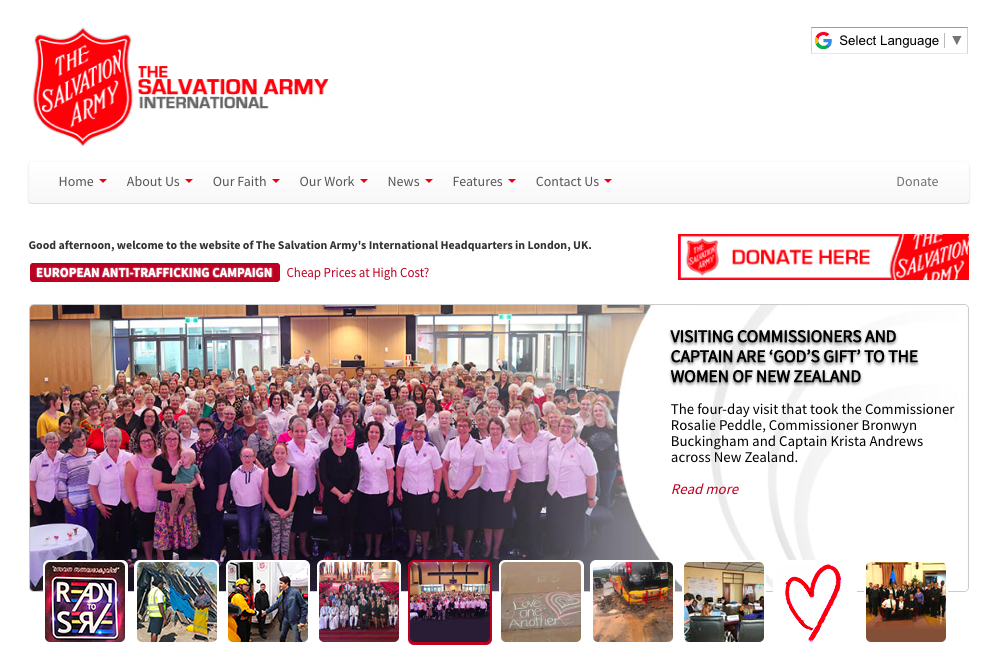
The Salvation Army is a Protestant Christian Church and the biggest non-governmental provider of social services in the US. It also has an international presence in over 125 countries worldwide.
The organization’s family stores will accept donations of gently-used household goods, appliances, clothing, furniture and automobiles.
You can enter your ZIP code onthis page to find drop-off locations in your area or schedule a pickup.
Donation Town
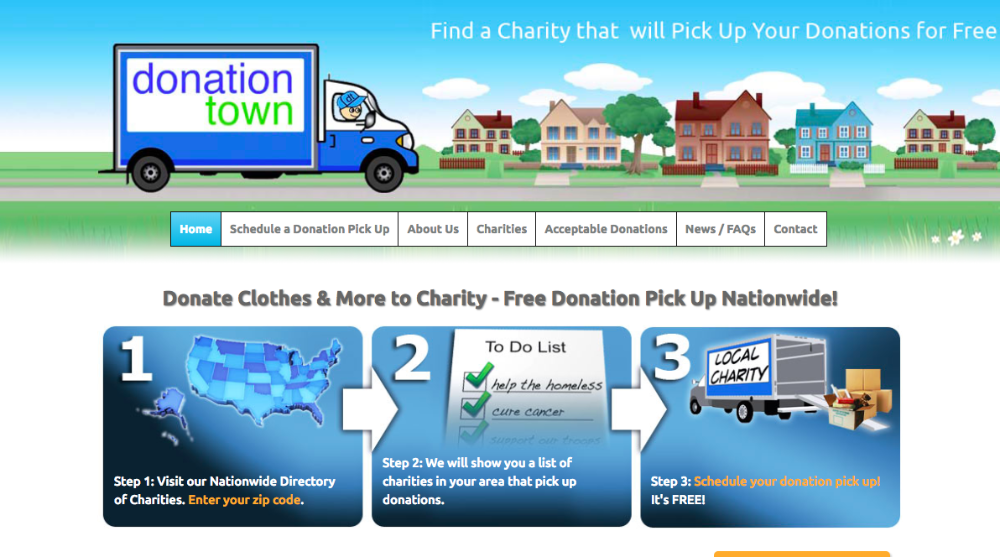
Donation Townis a directory of local charities that offer a donation pickup service and it helps to connect these charities with donors.
You can use the site to find charities that’ll take your household goods, clothes, shoes, furniture, toys, books, appliances, office supplies, electronics, sports equipment, vehicles and more.
To schedule a free donation pick-up from one of your local charities you can get started by entering your ZIP code on the website.
Vietnam Veterans of America

Vietnam Veterans of Americaaccepts donations of vehicles, clothing and household items, though the organization is especially in need of all kinds of clothing.
VVA is devoted to addressing the full range of issues facing Vietnam war veterans, like homelessness, lack of access to health care, PTSD, health, injuries and disabilities incurred during military service and more.
In the case of donating a vehicle to VVA, you can give them a toll-free call or fill out the online donation form to schedule a free towing.
For clothing and household items, you can use the site to find a drop-off location near you, or you can schedule a pick-up.
Habitat for Humanity
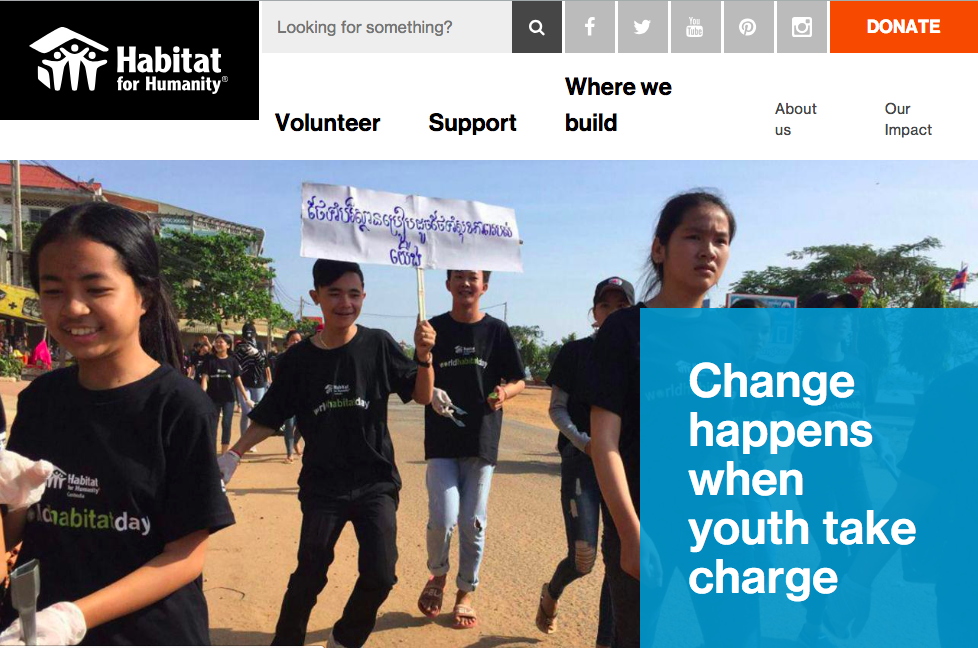
Habitat For Humanity is great for donating large pieces of furniture like bed frames, dining tables, dressers, couches, filing cabinets and so on.
It’s also a good place to donate tools like hammers, drills, saws, sanders, gardening tools and other hardware.
HFH will also accept other kinds of items including appliances, building materials, household goods and more, depending on the location.
The non-profit organization has been building safe and secure homes for those in need since 1976 and is currently active in over 70 countries around the world.
You can donate your stuff to one of the organization’s Habitat ReStores. To find the nearest Habitat ReStore to you, just enter your ZIP code in the search box on this page and then give the store a call to let them know what items you have to donate. Many stores will offer free pickup of larger items.
Donatestuff.com
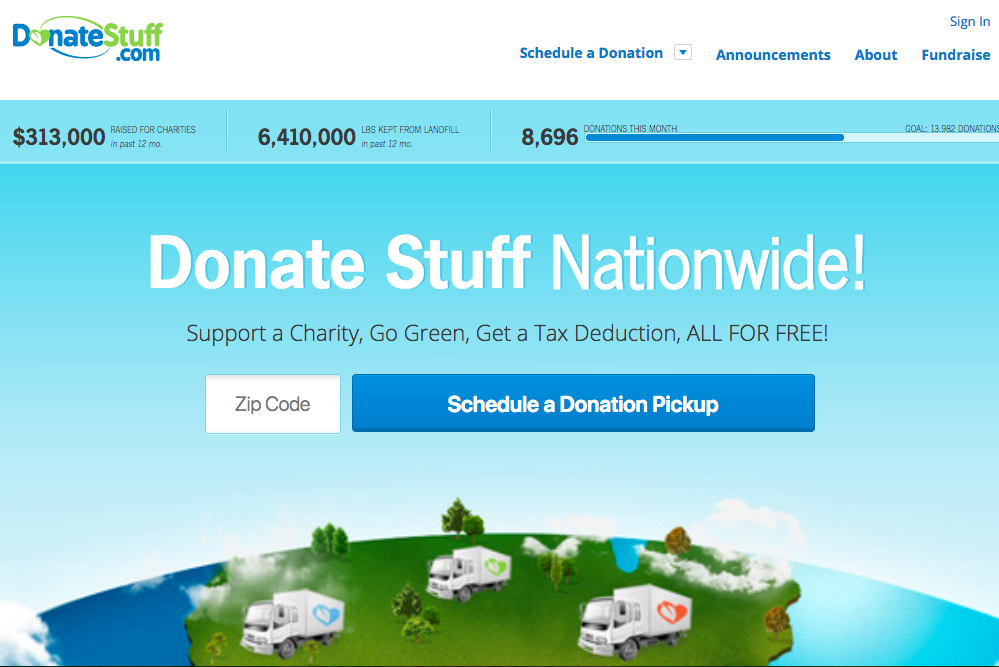
Donatestuff.com makes it easy for Americans to donate stuff and is helping to keep thousands of pounds of clothing from being dumped in landfill sites every year.
The site partners with various non-profit charities, including Amvets, Lupus, The City Mission and Rise in Love.
You just enter your ZIP code on the site and if your area supports home pick-up you can leave your stuff outside your front door and they’ll come and collect it for you.
If your area doesn’t support home pick-ups you can request free pre-paid UPS bags, fill them up with your items and then drop them off at your local UPS store.
Your donations are also tax-deductible up to 50% of your gross adjusted income.
Pickup Please
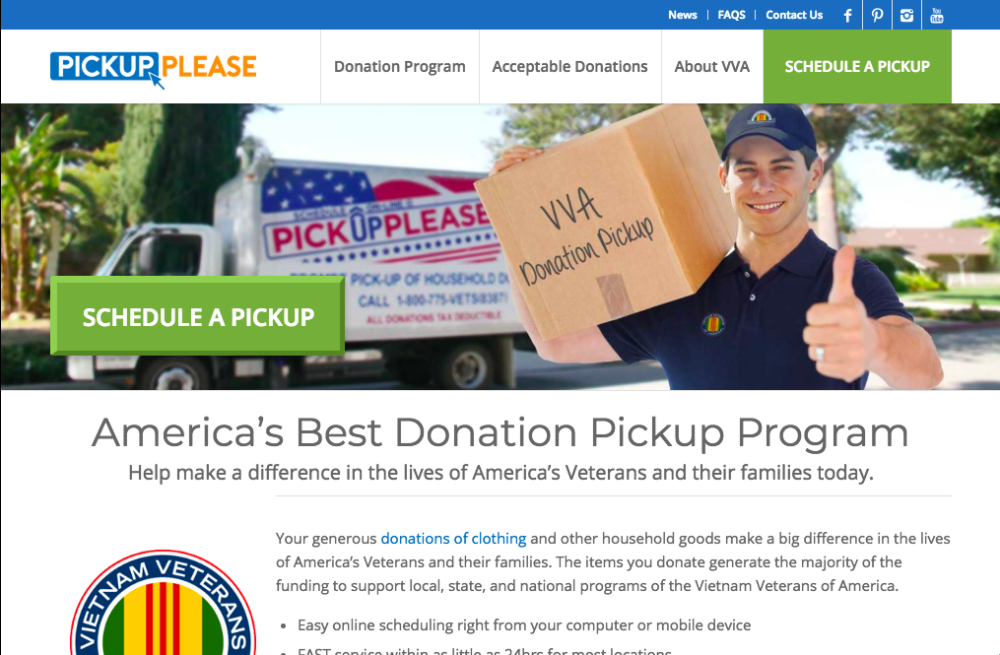
Pickup Please is another important service to know about if you need somebody to come and pick up your stuff from your doorstep.
The service is operated by the VVA (Vietnam Veterans of America) and they accept a wide range of items, from toys to household goods.
All you have to do is schedule a pickup online and then leave the goods in “VVA Donation Pickup” labeled bags or boxes outside your door on the designated day. You’ll be e-mailed a document for tax deduction purposes.
Freecycle.org
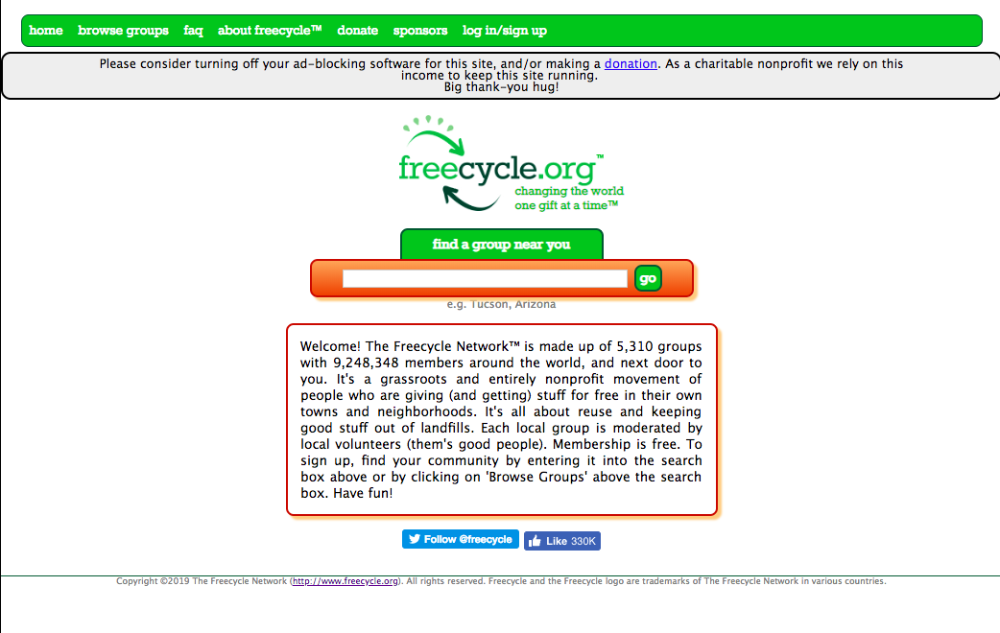
The concept of freecycling is really quite simple. It’s all about the gift economy and the motto is “changing the world one gift at a time”.
The idea is that, rather than dumping in landfills, recycling or donating to non-profits and thrift stores, members of a local community give the stuff they no longer want or need directly (for free) to the members that are in need of those items.
The practice of freecycling cuts out the profiteering middlemen and gets members of a community interacting with and helping each other directly, which helps to build trust and strengthens bonds.
Freecycling is a win-win for everyone involved, as the giver gets the chance to shed unwanted clutter while the recipient gets what they need.
The practice is also currently keeping over one thousand tons of waste out of landfills every day, so it’s helping the environment too.
Local freecycling groups already exist in more than 110 countries and you can browse for groups near you on freecycle.org, the global freecycling network.
The network is made up of over 5,300 groups (which are moderated by local volunteers) with more than 9 million members around the world, who all share a common belief in the concept of freecycling.
Once you’ve signed up to the website you’ll be able to join and post in multiple groups. You can either post “wanted” listings (when you’re requesting for an item) or “offer” listings (when you’re giving away an item) in the group feed.
Other more specialized services
The above one-stop organizations will cover most of the things you might care to donate, but it's worth knowing about a few of the others charities that focus exclusively on just one or a few types of items.
Operation Paperback

Operation Paperback sends books to troops overseas and to veterans and military families back home.
When you register with them and log in to the Volunteer’s Corner you can generate a list of addresses of troops, veterans or military families, based on the genres of the books that you want to send.
You’ll then head to the post office and personally send your box off to the address you’ve chosen, along with a standard shipping letter or your own personal note.
Books For Troops is a similar organization that has teams of volunteers working to clean, sort, pack and ship books to deployed troops overseas.
Access Books

Access Books is another organization that you could donate your gently used books to, especially if you’d like them to be used to stock underfunded libraries in inner city schools where 90% of the children live below the poverty line.
The website lists several drop-off locations and they also provide an address that you can mail the books to.
Books For Africa

Some organizations focus on relieving food famines in Africa, while others focus on relieving the continent's book famine.
Books for Africa is the largest shipper of donated textbooks and library books to the African continent, having shipped 44 million books to all 55 African countries since 1988.
The organization sends books, as well as e-readers and computers to African students of all ages.
Book types that are accepted for donation include fiction, non-fiction, academic textbooks, reference books and some religious books. School and office supplies are also welcomed. A full list of what they take is available on the website.
You can either mail books in or drop them off at their Minnesota or Atlanta locations.
Prison Book Program
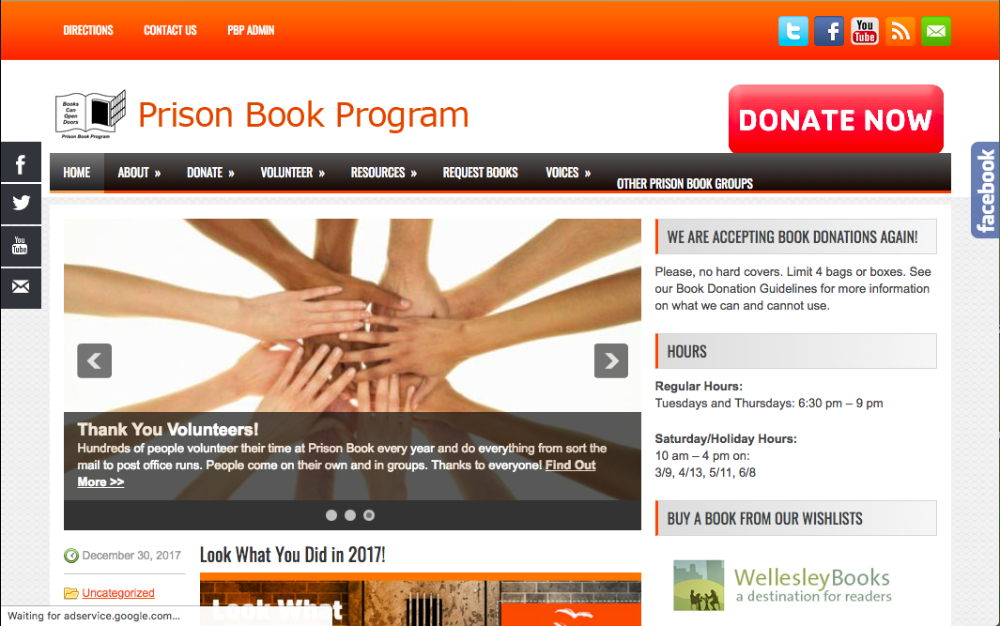
Prisoners are in desperate need of books. The intellectual stimulation that books provide is a prisoner's only defense against the gradual mental and spiritual deterioration of the mind in the monotonous and isolating prison environment.
The problem is that most prisons don’t allow their inmates to receive books from family and friends.
That’s where organizations like Prison Book Program come to the rescue. PBP is a grassroots organization that mails free books to prisoners in order to support their spiritual and intellectual growth and to help prepare them for their re-integration with society.
A wide range of book genres are welcomed, although the most requested books are dictionaries. In general it’s best to only donate paperbacks to prisons, as most don’t allow hardback books.
Books can either be dropped off at the organization’s office in Quincy, Massachusetts or mailed in. However, the latter can be an expensive option, so it’s better that you check their list of local organizations (these all do the same thing) to find a drop-off point near you.
Other ways to donate books
You can also just try donating any books (and CDs and DVDs) that you have to your local library.
It would be courteous to call in advance and find out if they are looking for anything specific or if they need any books to sell at an upcoming fundraising event.
Local schools and retirement homes are other places to try donating books. If you have any historical books to donate, theatres might be interested in using them as props, or museums might like to use them as display exhibits.
The more general one-stop donation organizations we listed above will also usually accept cast-off books.
Americancellphonedrive.org
Americancellphonedriveaccepts used cell phones and any funds it raises from selling the phones are put towards a host of charitable causes in both the US and abroad.
Just enter your ZIP code and the site and find the nearest donation box near you. If your phone is unsellable or unrepairable they’ll dispose of it safely for you.
Cell Phones For Soldiers
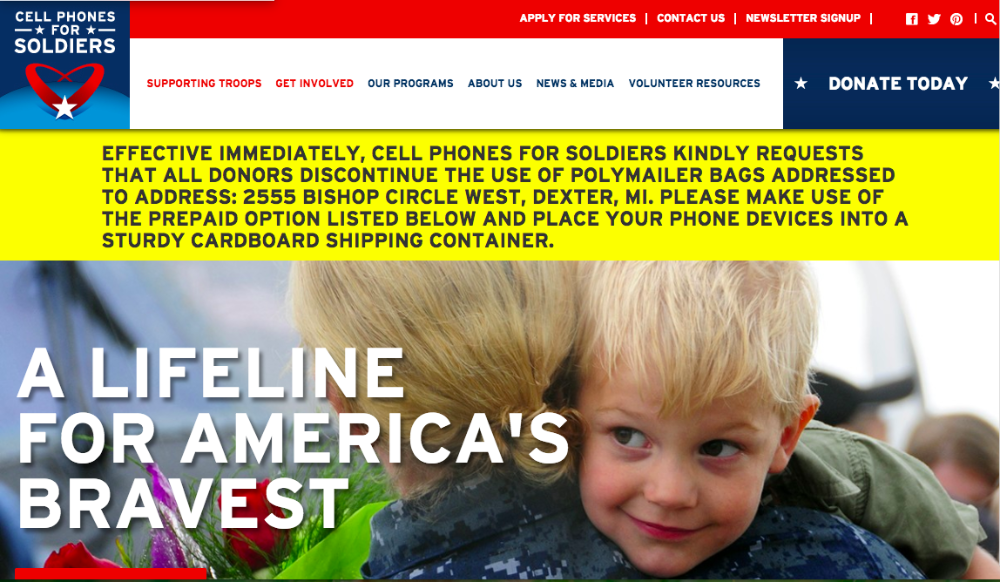
Cell Phones For Soldiersaccepts donations of cell phones, smartphones, tablets, mp3 players and chargers.
The organization’s main objective is to help overseas troops call home at no charge and they’ve raised the funds to achieve this by recycling and selling more than 15 million donated cell phones.
The proceeds are used to send more than 5 million prepaid international calling cards over to the troops, providing them with 300 million minutes of free talk time.
CPFS also runs the Helping Heroes program, which helps veterans re-integrate back into civilian life.
You can ship phones directly to CPFS (they’ll pay for the shipping if you send 10+ phones) or you can enter your ZIP code on the site to find a drop-off point near your home.
Furniturebanks.org
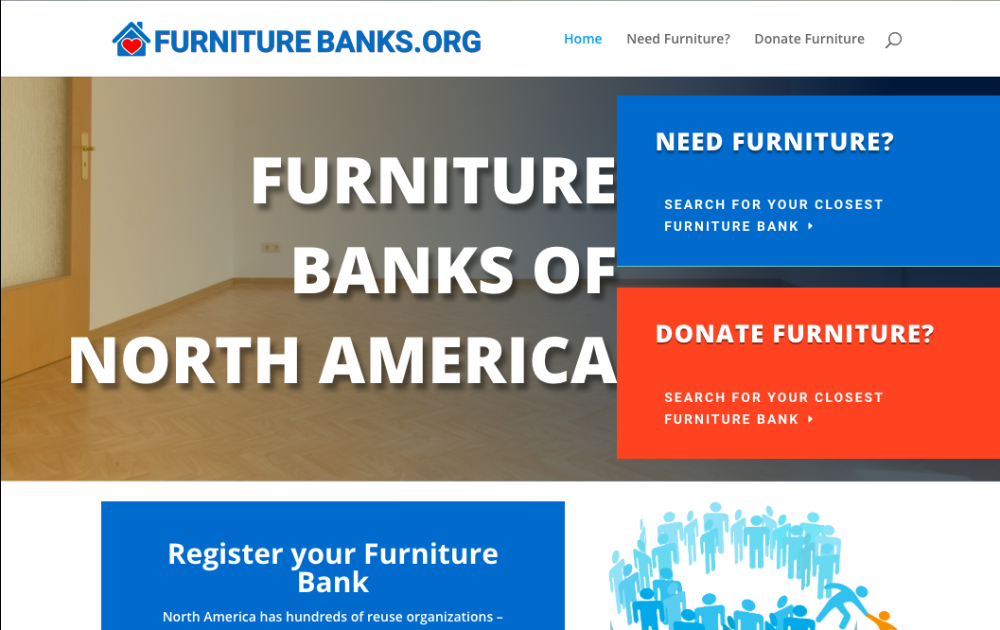
Furniturebanks.org is an organization that’s very happy to accept your furniture donations.
It works with many groups of vulnerable people, including the formerly homeless, women and children fleeing abusive situations, newcomer families, refugees and others making a fresh start.
The furniture that donors provide helps to turn new unfurnished houses into homes for these groups of people.
The organization has furniture banks all across the U.S and they’ll give your donated items to individuals and families in need at little or no cost. You can drop off your furniture directly at one of the facilities on weekday mornings.
Animal shelters & wildlife rescue centres

Animal shelters and wildlife rescue centres are often good places to donate used hairbrushes, combs and other grooming items, as many thrift shops and charities won’t accept them for hygiene reasons.
Animal shelters are also a good place to donate towels, linens and old clothing, as these items can be used for bathing and as bedding for the animals.
Fitness 4 Charity
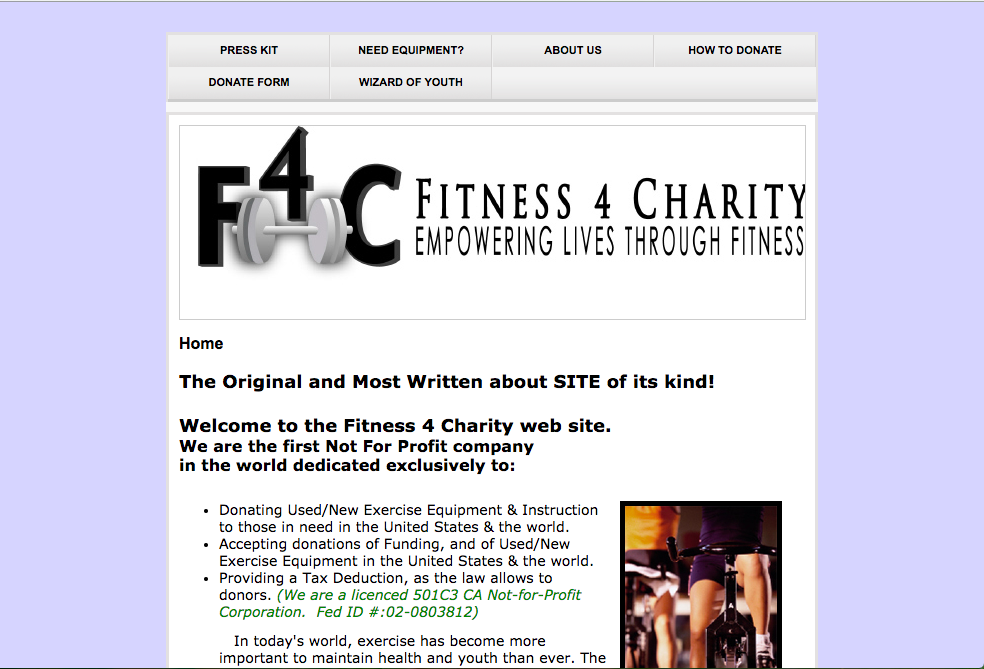
If you have any old exercise equipment like treadmills, elliptical trainers, exercise bikes, stepper machines, exercise machines, rowing machines, exercise balls and so on, Fitness 4 Charity accepts donations from all 50 U.S. sates.
The organization gives the donated equipment to schools, police stations, foster homes, churches, hospitals, fire stations, individuals and to anywhere else that it’s needed. There’s a form on the website that you need to fill out if you wish to initiate the donation process.
Brides Across America

If you’re trying to get rid of an old wedding dress, Brides Across America gives donated gowns for free to military or first responder brides in order to express gratitude for the dedicated women serving the United States Armed Services
The organization hosts dozens of bridal gown giveaway events each year at participating bridal salons and has gifted over 20,000 wedding dresses and over 20 weddings to date.
Brides Across America also supports wounded warriors, PTSD victims and helps veterans to find employment.
To donate a wedding gown to BAA you need to first supply some information about the gown you wish to donate by filling out the form on the website.
If they think your gown could be of any help to them you’ll be contacted and provided instructions on how to ship the gown to them.
One Warm Coat
.png)
If you have any old coats to donate, you might consider giving them to One Warm Coat, a non-profit organization that provides free coats to people in need.
The group has handed out almost 6,000,000 coats to homeless veterans, small children, elderly folks and other in need since it was founded in 1992, and their belief is that nobody should have to go cold each winter.
One Warm Coats partners with almost 1,000 non-profit entities across all 50 states and their volunteers across the country run approximately 4,000 coat drives each year in the organization’s name.
The coats are rounded up by ambassadors, which include small businesses, big corporations, non-profits and individuals, who then pass the coats on to local non-profits in their area, who then distribute the coats to people in need.
The usual way to donate is through a coat drive, most of which are held in the fall or winter. There’s a map on the website where you can enter your ZIP code to find active coat drives in your area.
If you want to donate in the spring or summer, you can also reach out to one of their non-profit agency partners by using the agency locator map on the site.
Baby2Baby
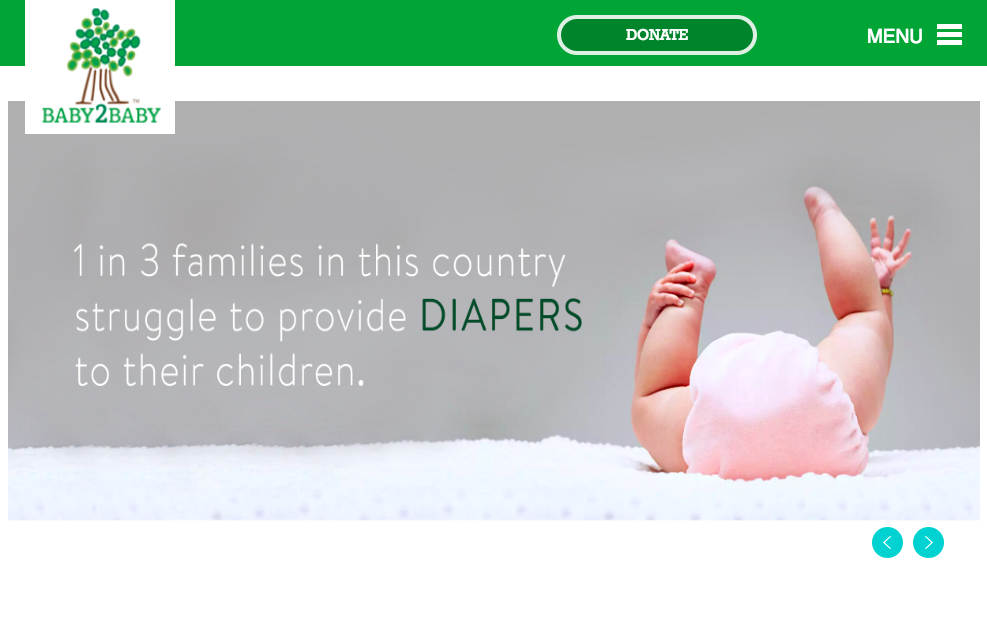
Baby2Baby is great for donating all kinds of baby and kid related items – toys, cribs, safety gates, bottles, clothing, school uniforms, blankets, strollers, books, car seats, high chairs and so on.
This non-profit distributes the donated items to disadvantaged children aged 0-12 in homeless shelters, hospitals, foster care, domestic violence programs and underserved schools.
Baby2baby has a network of community drop off locations where you can donate any suitable items. You can search for ones near you if you scroll down near the bottom of this page.
Donate a Car
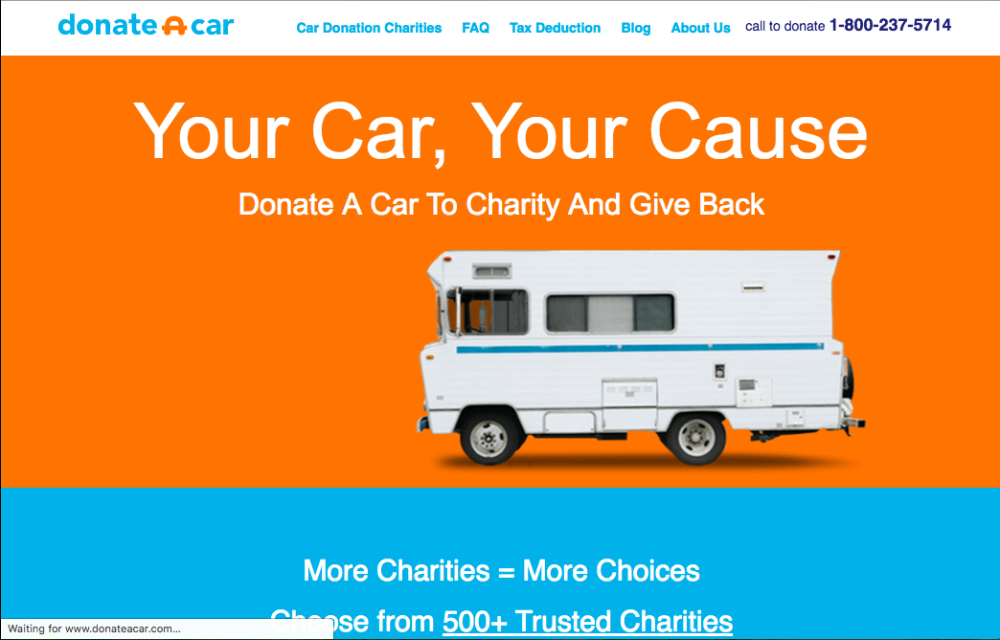
Donate a Car(donateacar.com) lets you pick a charity to give the proceeds from your donated car, truck, van motorcycle, boat, ATV or other vehicle towards. Your vehicle will be picked up by a professional towing company from a location of your choosing.
Donate a Car works with more charities (500+) than any other car donation program in the USA and they guarantee that donations to all of their partner charities qualify for tax deduction.
Car Talk Vehicle Donation Program
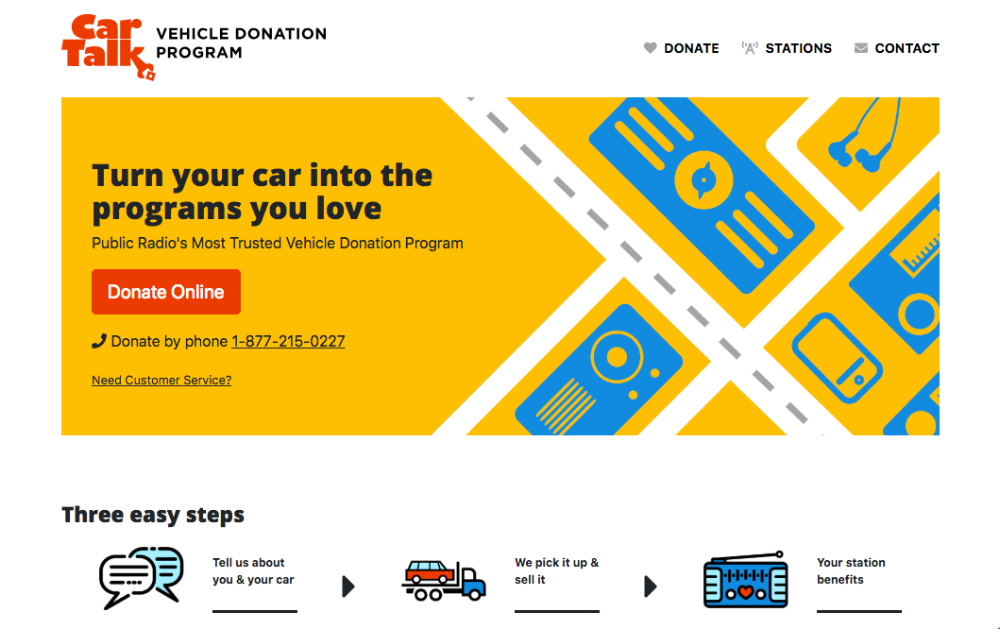
Car Talk Vehicle Donation Program is another option for donating your vehicle (car, truck, van, boat, plane, motorcycle, RV, tractor etc.).
The proceeds from the sale of your vehicle go towards funding public radio programs on a radio station of your choice. The organization has been around since 1995 and has so far converted over 45,000 donated cars into public radio programs.
You can start the donation process by calling a phone number on the site or by clicking the "Ready to Donate?" button and filling out the online form. After all the necessary paperwork is completed, they’ll pick up the vehicle for you at a convenient time and location.
World Computer Exchange
.png)
World Computer Exchangeis an international charitable organization that has already helped 4.9 million people in 3,465 schools, libraries, youth centres and universities, in 51 countries worldwide, to connect to the Internet.
They’re looking for Duo Core and i Series desktops, laptops and tablets in working condition, and will also accept flat screen monitors, USB keyboards, USB mice, scanners, network gear, webcams, microphones, earphones, DVD drives, USB thumb drives, digital projectors, cell phones and various other items. A full list of what exactly is accepted is available on the website.
Their Boston chapter is the only one that accepts Mac iphones, cell phones, tablets and laptops that are under 6 years old.
To donate to WCE you can arrange a drop-off time if you have a Chapter near you. If there’s no chapter near you it’s also possible to donate via mail to the address provided on the website.
Computers with Causes
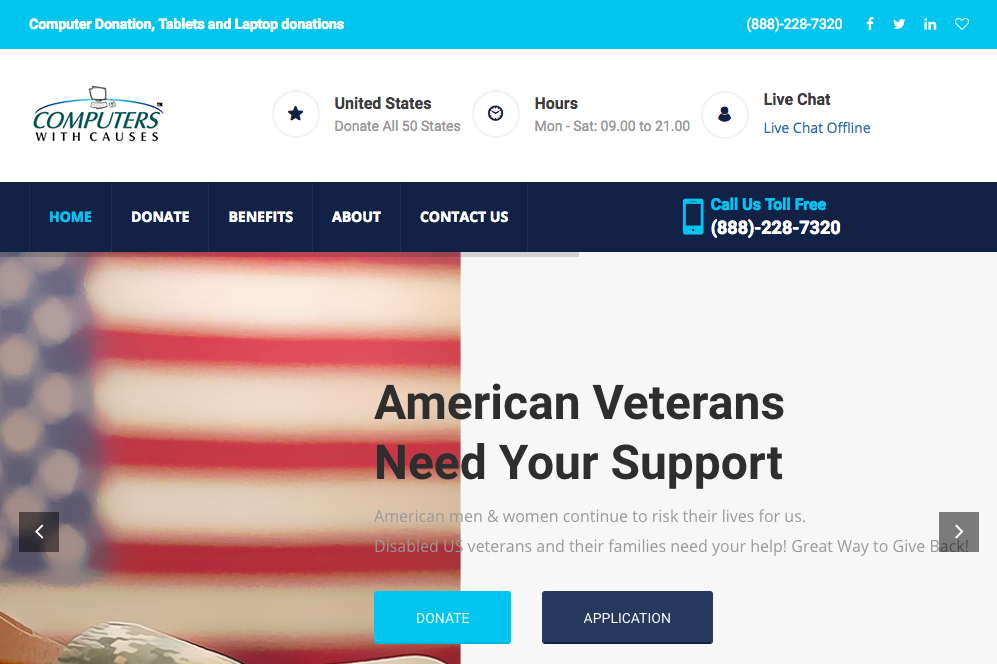
Computers with Causesis another entity that accepts computers and other electronics.
Run by a non-profit charitable organization called the Giving Centre, it accepts donations of computers, servers, laptops, printers, drones, robots, DSLR cameras and lenses, camcorders, video game consoles, GPS units and many other types of electrical equipment.
They’re looking for computers and other electronic devices that are in working condition, internet-capable and that aren’t too old (ideally no older than 3 years).
The donated electronics are used directly in supporting various charitable programs for youth centres, impoverished schools and military veterans, and are also used for commercial purposes.
You’ll find a form on the website to start the donation process.
For donating computers and other related equipment, local libraries and schools will also be your friend.
A quick word of warning - don’t forget to completely wipe all the data from the hard drive before parting with any computer you have used in the past.
If you fail to do this an unscrupulous future user could use data recovery software to retrieve sensitive information still stored on the drive.
Simply deleting files and emptying the recycle bin doesn’t actually erase the files from the drive - it just makes them invisible to your computer and marks the sector where the files are stored as free space that is now available to be overwritten.
In order to wipe your computer's hard drive clean you need to do a clean install of the original operating system that came with the computer.
Another method is to use a degaussing wand, which contains one or more rare earth magnets that disrupt the magnetic domains on the drive.
You can also use free data destruction software, which works by overwriting the drive so many times and in such a way that extracting data from the drive is almost impossible.
For more information on completely erasing the data from your hard drive, check out this article from Lifewire.
Option #5 - Rent it out

Sometimes people only need to use things only once or once in a while and hence they don’t want to buy. In spite of this fact, there’s a hugely underserved market for rentals out there.
You probably have quite a few belongings that could be rented out to help you earn a passive income while you’re travelling.
Thanks to the power of the Internet and the new spate of peer-to-peer borrowing apps and websites, it’s now easier than ever for you to connect with the people in your locality that want to borrow things that you own.
The only potential drawback for some travellers is that peer-to-peer lending tends to work best in large metropolitan areas, as there would normally be very few users of these platforms in smaller towns and villages.
If you don’t live in a big city however, you could be out of luck.
The other obvious issue is that renting out your belongings to people back home while you’re travelling would essentially amount to remotely running a rental business, and you would need to hire somebody to manage the whole affair for you while you’re away.
However, there’s no reason why you couldn’t employ a friend, family member or a stranger to run something like that for you, considering how much money these businesses can bring in.
Most of these peer-to-peer borrowing sites and apps let you list items for free and take a commission only when you’ve made a sale.
You usually won’t have much to worry about as regards borrowers damaging, stealing or losing your stuff, as your property will normally be fully insured, and active platforms users normally will have undergone a fairly rigorous vetting and verification procedure.
Something you do need to consider is if an item you are lending could potentially do the borrower any harm. For example, if you lent an angle grinder to somebody and they had an accident while using it, the person might try to sue you.
It’s always a good idea to check if the company you’re lending through assumes any liability for these kinds of incidents.
Some of the things you can rent out using these platforms might surprise you. We’ve listed some of the most popular apps and sites below, how they work and what items you can lend through them.
RV rental sites
Campanda, Outdoorsyand RVShare are good sites to try if you happen to own an R.V. You could earn between $20,000 - $45,000 a year by hiring out your R.V through these platforms.
Campanda is headquartered in Berlin, Germany and operates in more than 959 cities in 42 countries across 5 continents, and has 8 websites in 6 languages. It takes a 20% commission on all rental bookings.
Outdoorsy is headquartered in Austin, Texas and claims to be the world’s fastest growing RV rental marketplace. It currently operates in 8 countries worldwide, including the USA, Canada, Australia, France and the UK, and the company plans to expand into more new countries this year. Owners pay a 20% commission on rental bookings.
RVShare is currently confined to the USA and claims to be the world’s first and largest peer-to-peer RV rental marketplace, having been founded back in 2012.
Outdoorsy is the only RV rental platform that provides commercial insurance for qualified renters and owners when the owner’s insurance would not apply.
Get My Boat

Boat owners can avail of GetMyBoat, a platform which works for hiring out all kinds of watercraft, from powerboats to jetskis.
It’s the world’s largest boat rental marketplace with over 130,000 listings in 184 countries worldwide.
Listing your boat on the platform is free and the company only takes a 7% service charge from boat owners to cover the platform running costs. You receive payment directly into your bank account.
GetMyBoat won’t insure your boat in the rare event that a renter damages it, but they can provide recommended insurers on request.
URentMe
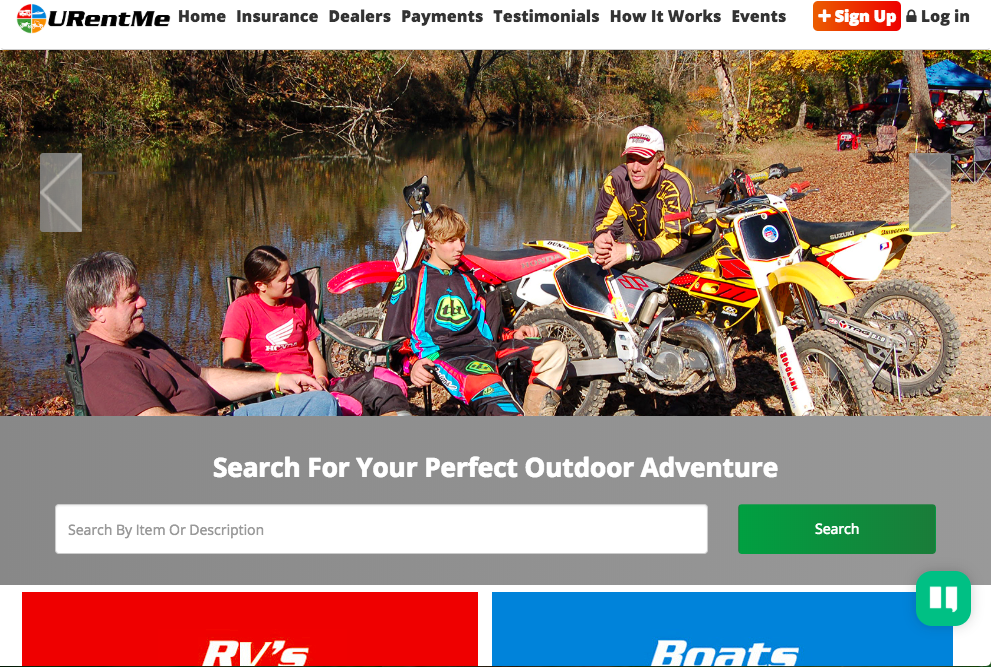
URentMe aims to be the U.S.’s number one peer-to-peer rental marketplace for recreational toys.
It lets you hire out kayaks, canoes, bicycles, motorcycles, all-terrain vehicles (ATVs), utility vehicles (UTVs), recreational vehicles (RVs), dirt bikes, snowmobiles and other recreational toys, giving you the opportunity to potentially earn $5,000+ per month.
There’s a handy calculator on the site’s home page where you can select the type of vehicle you’re renting out and receive an estimate of your annual earnings.
As an owner listing you will have comprehensive insurance cover on all your URentMe listings, which is provided by one of the biggest nationwide carriers.
As an extra safeguard you can also request a fully refundable security deposit from the renter, as the terms of the insurance include a deductible.
The platform charges a significantly lower service fee to owners than other similar marketplaces and payments to owners are made via Stripe through ACH (automated clearing house).
Turo

Turo is one of the best-known peer-to-peer vehicle rental apps, that allows people to rent cars and other kinds of vehicles from local vehicle owners, although you have to live in the US, UK, Canada or Germany to use the platform.
Vehicle owner’s minds will be put at ease knowing that company screens all drivers and provides up to $1 million in liability insurance, theft and damage protection and 24/7 roadside assistance throughout each trip.
When hiring out your vehicle via Turo you’ll usually meet with the driver in person so that you can check his or her license and note the gas level and mileage on your vehicle before handing over the keys.
As a Turo host you typically earn 75% (the exact percentage depends on the protection plan you select) of the total cost paid by the borrower, which can include a number of additional penalty fees on top of the rental price.
There’s also the opportunity to earn 90% of the proceeds from any extras that you rent out to your guests, such as a rooftop box, child safety seat, outdoor equipment, unlimited mileage, prepaid refueling and so on.
However, the reason you pay less commission on earnings from extras is because they are not covered under Turo's protection plans.
On the Turo website, the "carculator" tool gives you an estimate of how much money your vehicle could earn for you per month based on its make, model, age and your approximate location.
Getaround
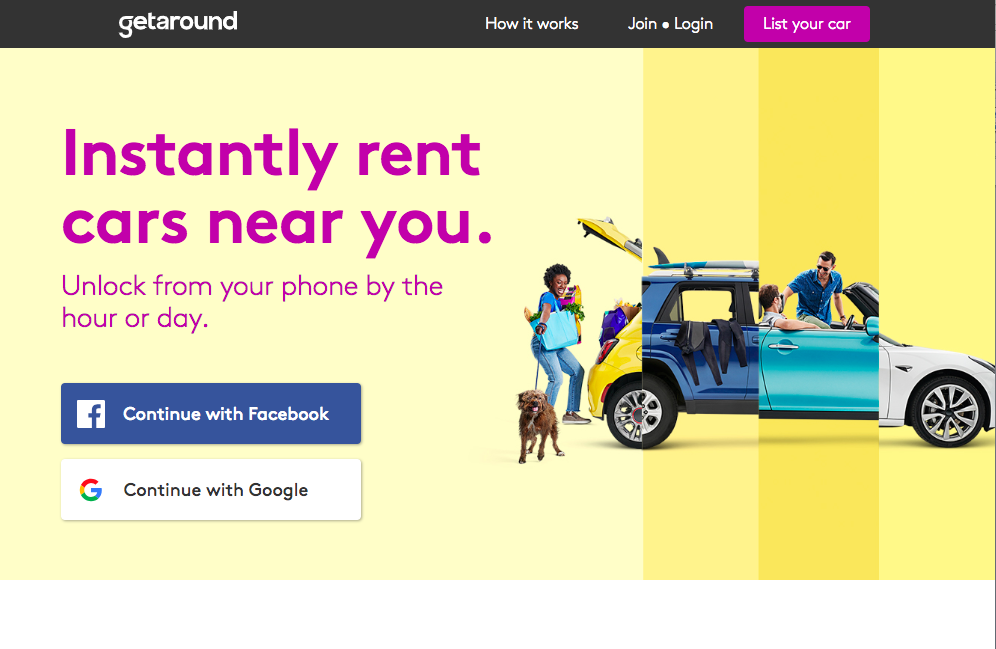
Getaround is another vehicle sharing app that works very similarly to Turo, although it’s currently only available in 12 U.S cities.
One difference is that is allows slightly younger drivers (minimum age is 19) to hire vehicles than Turo (minimum age is 21). Vehicle owners also only earn about 60% of the total cost on Getaround, which is a bit less than what they'd earn with Turo.
One interesting feature unique to Getaround is its technology Getaround Connect™, which requires the installation of an electronic device in the vehicle (for a one-time installation fee of $99 paid by the owner).
The device lets both the owner and renter lock and unlock the vehicle using their smartphones, and also lets the renter locate the vehicle using their phone, which means that the two parties never even have to meet to exchange keys.
Getaround Connect™ also has anti-theft functionality, which prevents the vehicle from starting unless in use by either the owner or the renter. The Getaround team can also use the device to monitor driver behavior and track mileage over a secure cellular network.
For more info on Turo and Getaround check out this comparison between the two platforms as well.
Spinlister
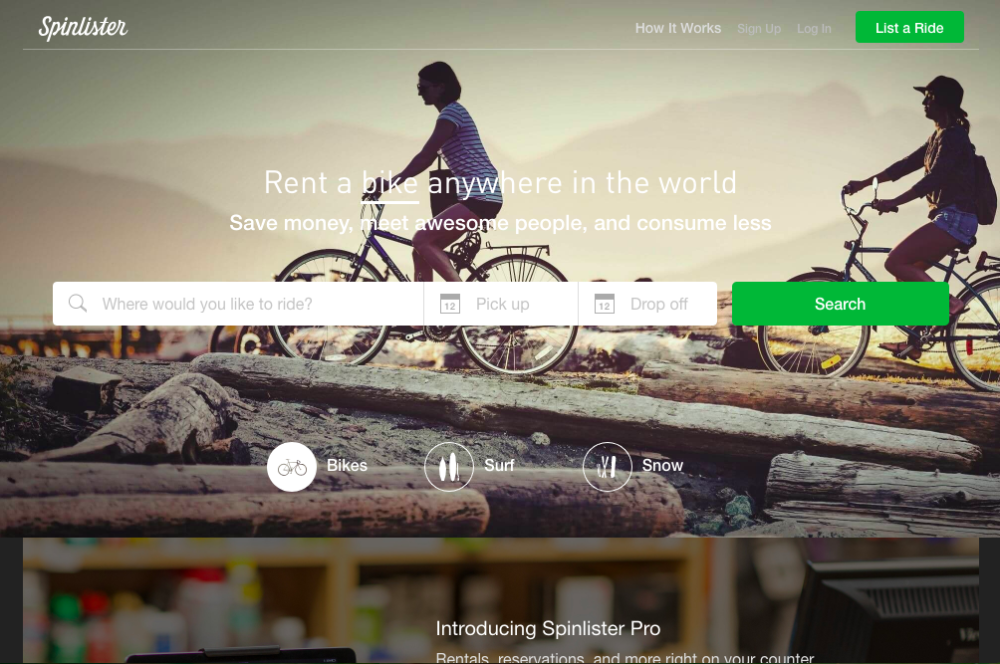
Spinlister lets you earn up to $500 per month hiring out slower modes of transportation, like your bicycle, surfboard, snowboard, skis, or stand up paddle board, although it primarily pegs itself as a bicycle rental and sharing platform.
The company now has listings in over 100 countries around the world, and active users in over 60 of these countries at any given time.
As a lender you are covered up to $5,000 for a bicycle (not in every country), up to $2,000 for a surfboard (everywhere) or SUP board, and up to $1,000 for skis and snowboards (everywhere).
Listing is free on the platform and you just pay a 17.5% fee on each rental. All payments are made via credit card (no cash) and lister’s receive their payment through Paypal or by check within 10 days.
MyShed
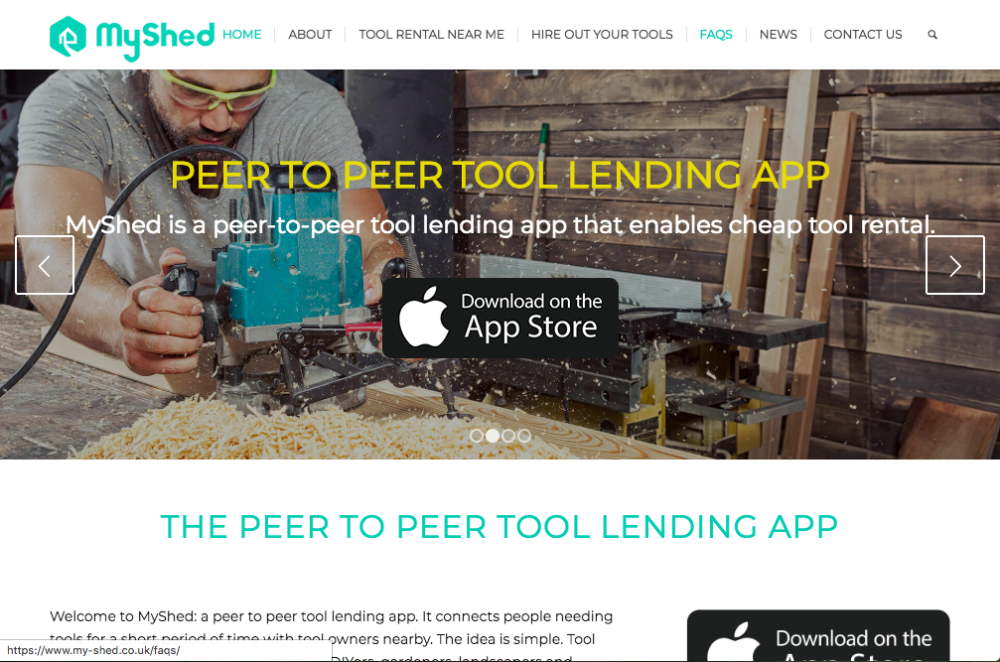
MyShed is a peer-to-peer tool-lending app (iOS only) that lets you rent out all sorts of tools, from angle grinders to garden spades, to other people in your local community. The platform is currently only operational in the UK.
As a tool owner the app allows you to create a virtual “shed” where you list the tools that you have available for hire, and you can make arrangements with renters via the in-app chat.
As a tool owner you’re encouraged to set a security deposit for renters. If one of your tools should get damaged or go missing and you’re able to prove this, MyShed will charge the renter the full deposit and refund this amount to you.
Renters pay securely on the app via credit card and tool owners are paid by Stripe, so you’ll have to set up a Stripe Connect merchant Account. MyShed charges tool owners a 12% transaction fee on the total hire cost.
StyleLend
.png)
StyleLend is an app that gives women the opportunity to monetize their closets. The platform lets you lend out designer clothing, dresses, shoes, bags and accessories.
As the lender of an item, you get an 80% cut of the rental fee, payable through Venmo or Paypal, plus StyleLend will also pay you $6.50 to cover the dry cleaning cost, so that you can have the item clean and ready for the next renter.
Your other responsibility as the lender is the shipping of the item to the borrower. StyleLend will provide the shipping labels for you and you ship the item with USPS. The renter pays the shipping cost so there’s nothing to worry about.
Rent My Wardrobe
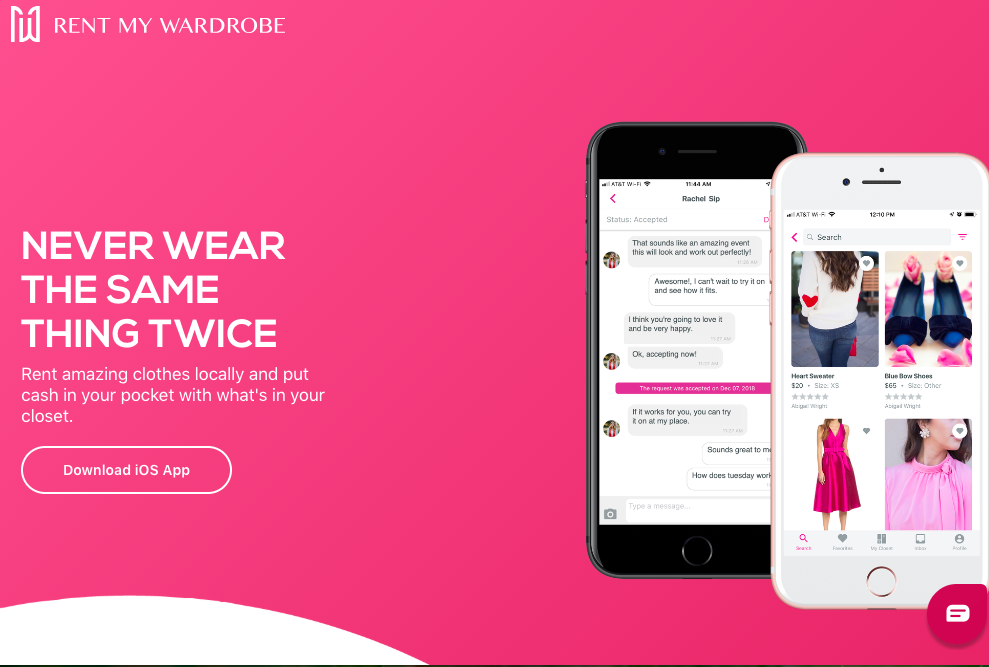
Rent My Wardrobe is an app-based peer-to-peer rental platform (iOS only) for women’s designer clothes that lets users make up to $500 per month from renting out items in their closets.
The company is based in Dallas, Texas and has plans to eventually expand nationwide.
The app allows you to create an online closet where you can showcase all your dresses, skirts, tops, shoes and bags that are available for hire, and lend them to other women in your local community.
You can lend in confidence knowing that your property is covered by the company’s Apparel Insurance, which provides theft and damage protection for every rental.
Renters also have a hold amount placed on their credit card to ensure that the item is returned in good condition.
RMW deducts an 18% commission from each rental payment but lets you keep 100% of the cleaning fee, which is a fee that you can choose to charge renters to cover the cleaning costs of the returned item(s).
Payments are normally made by credit card through the app’s payment system. If you choose to accept payment in cash or through say Venmo or Facebook messenger, you’ll be 100% liable in the event of any damage or loss of property.
One-stop rental platforms
There are also several peer-to-peer rental platforms that take a broad approach, rather than focusing on specific niches. Here are a few of the best-known ones.
Fatllama
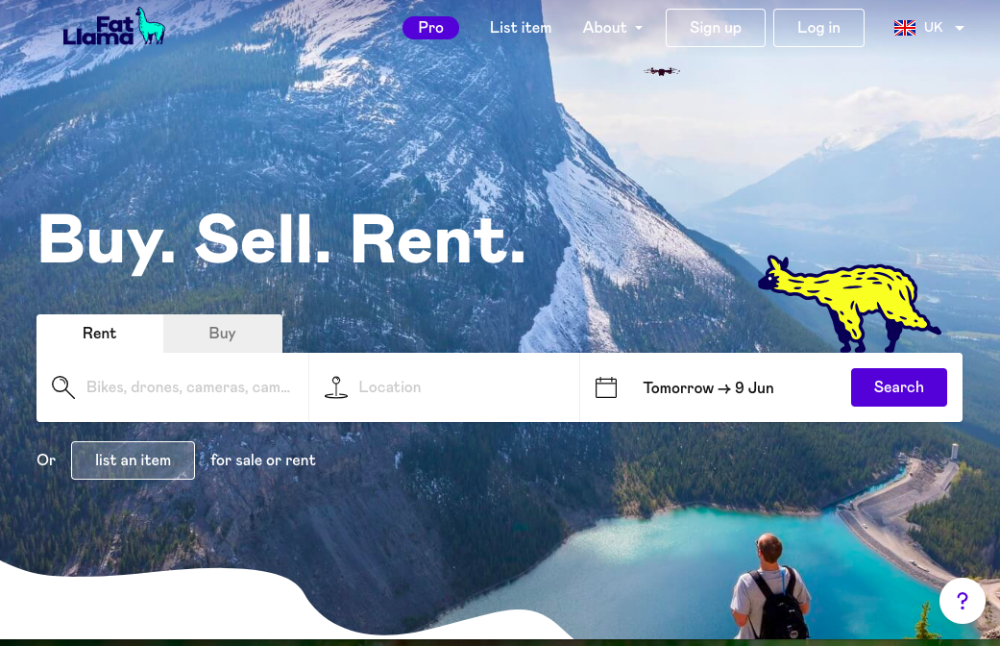
Fatllama is a site and mobile app that lets you lend out almost anything, from power tools to drones, to other verified users of the platform.
Items that people list on the platform include various musical instruments (drums, guitars, microphones etc.), games consoles, projectors, bicycles, prams and other baby items, sports equipment, clothing and DJ equipment.
The amount you can earn depends on the value of item(s) you’re renting, with items valued at £1,000 fetching anywhere from £80 to £395 per week, depending on the item category.
The most valuable category seems to be “home/office/garden” and top earners on the site are supposedly earning north of £5,000 a month from their rentals.
The best part is that you can list your items on the site for free and you’re protected against damage, theft and other issues that might arise up to £25,000, or up to £50,000 if renting campervans.
The only fee you have to deal with is the 15% cut on the sale price that Fatllama takes from both the borrower and the lender. The company handles your payment so no cash is exchanged when you meet the borrower to hand over the item.
Fatllama is currently only available to people living in the UK, United States, Australia, Singapore and Spain.
PeerRenters
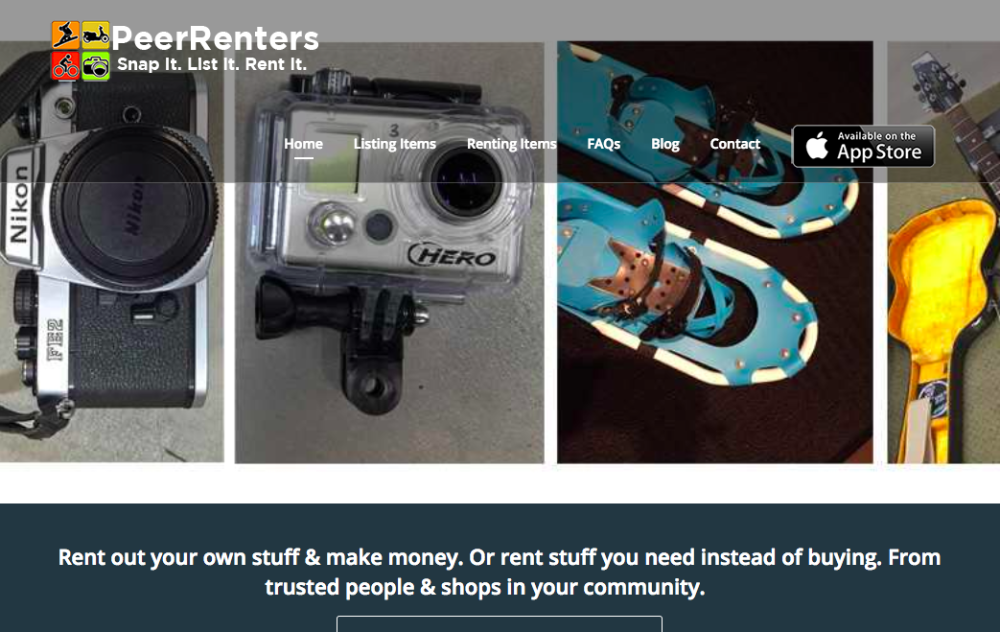
PeerRenters is a recently launched Canadian start-up that lets you list stuff for hire as well as for sale. Their app is currently only available for iOS.
With PeerRenters you can list things for free as a lender and you only pay a 10% sale transaction fee, so you receive 90% of the rental price when you meet the buyer at a public location to make the exchange.
By the time you meet the other 10% will have already been paid by the buyer to PeerRenters as a booking fee.
There’s no insurance with this platform as such, but the app does encourage you to collect a refundable security deposit from borrowers when you meet.
Zilok
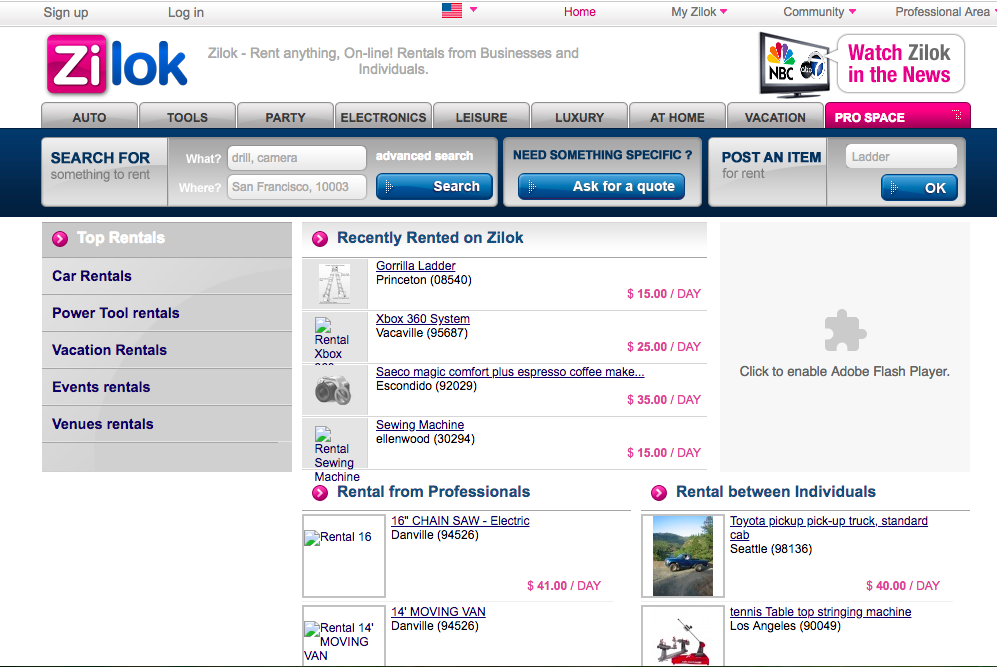
If you’re based in the US, France, Belgium, Netherlands or the U.K you can hire out your stuff on Zilok, an international, general-purpose online marketplace that facilitates rentals between both individuals and professionals.
It’s free to list items on the site but there’s a transaction fee of up to 9% of your earnings if you hire something out through the platform.
The commission rate ranges from 5% for very high value transactions ($2,000+) to 9% for lower value transactions ($10 to $50).
However, there is also a flat fee charged on top of the commission rate, with $2000+ transactions paying the highest flat fee of $26.60, and $10-$50 transactions incurring a flat fee of just $0.10.
Check this pagefor up-to-date pricing details.
The way you get paid as a lender is as follows:
Renters first pay a retainer fee (which is the commission you pay to Zilok as the lender) to Zilok via credit card, Paypal or ClickandBuy (an e-wallet service) when reserving your item for rent.
The renter then has to pay you the balance (total rental cost minus the retainer fee) in cash when they meet you in person.
Whether you ask renters to pay a security deposit or not is entirely up to you and Zilok has nothing to do with it.
Other platforms to keep an eye on
Renting stuff out on classified ad sites
The one major issue with most of these peer-to-peer rental marketplaces is that most of them are still in their nascent stages and the industry as a whole hasn’t really taken off yet.
The result is that business on these platforms can often be slow or non-existent, depending on where you live.
In the meantime, remember that you can also hire out stuff on Craigslist and other classifieds sites, even if there’s no specific category on most of these sites for rentals. You can instead just list the item for rent in the appropriate “for sale” category.
People browsing the site will come across your listing with the initial intention of buying something, but may actually be happy to rent instead, especially if it’s the kind of item that a person might use only once or once in a while.
Option #6 - Recycle or dump
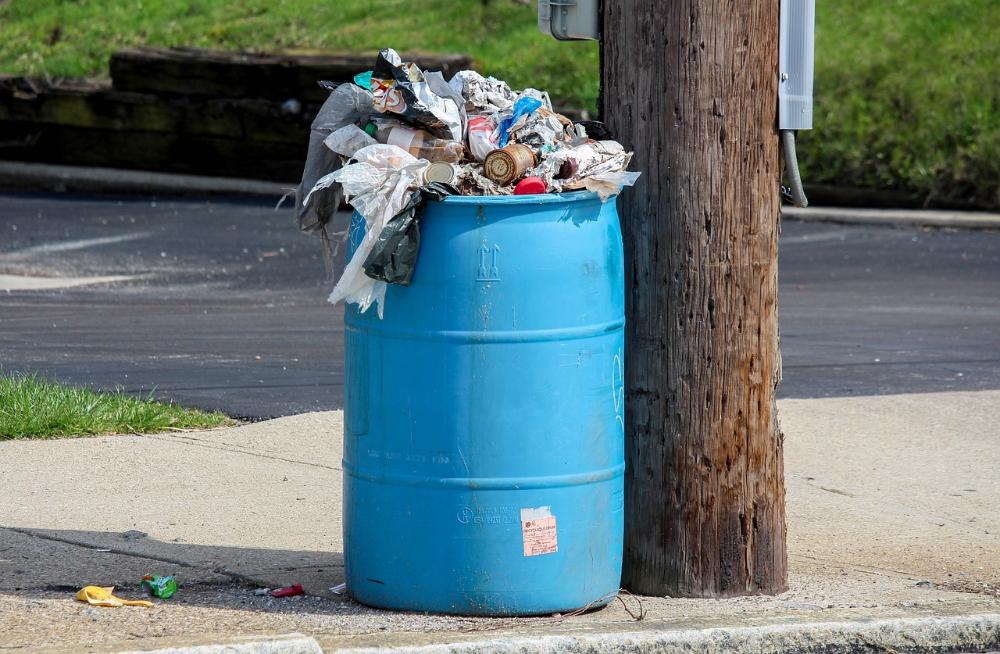
For any items you own that are unsuitable to bring, sell, donate, rent out or keep, the only option remaining is to recycle or dump them.
These might be items that are defective, badly damaged, soiled beyond recovery, completely obsolete, or just generally of such little use and worth to society that nobody would ever want them (even if they were free).
That said, you shouldn’t always be so quick to conclude that an item is only fit to be discarded; one person’s trash is often another’s treasure. Be very certain therefore, that something really is worthless before you decide to dump or recycle it.
Obviously, it’s better to try to recycle things before you consider the very last resort of sending them to the nearest landfill.
If you’re an environmentally conscious person, you probably already know how to recycle simple items like tin cans, glass jars and bottles, aluminium foil and drink cans, plastic PET bottles, plastic grocery bags, milk jugs, margarine tubs, Tetra Paks, cardboard boxes, egg cartons, cereal boxes, toilet roll tubes, newspapers, magazines and the like.
But what about some of the other more complicated items that you might be trying to get rid of before you set off on your travels? What about things like vacuum cleaners, furniture and game consoles?
Many common household items are comprised of varied materials and parts, and it’s not always obvious what can be recycled and how you would go about doing so.
Luckily, there are myriad curbside collection programs, recycling facilities, collection bins, mail-in programs, scrap recyclers and other services that can help you to recycle things that you might have otherwise thought you could only consign to a landfill or an incinerator.
It’s also important to remember that many of the thrift stores and charities that accept donations will recycle items like clothes and cell phones for you if they are not able to find them a new owner.
Two of the most important websites to help you with recycling are earth911.com and recyclenation.com.
Both websites have very helpful search tools that allow you to find recycling facilities and other recycling options in your locality for specific items that you're trying to recycle.
If you’re based in the U.K, a very useful website is recyclenow.com, which also has a recycling locator to check your local recycling options.
Terracycle is another very important company to know about if you want to recycle as many items as you possibly can. This is an innovative company that specializes in the recycling of difficult-to-recycle objects.
Terracycle makes it easy for you to recycle the things that people don’t normally recycle by sending you a box (these can be expensive to order unfortunately) to fill with hard-to-recycle items, which you then ship back to the company for processing.
The last tool we want to mention is the iScrap app, available for both Android and iOS, which lets you locate scrap yards in your area and also provides information on current market prices of scrap metals. Very handy if you're trying to recycling something made of metal.
Below we’ve compiled a list of the items that commonly cause confusion in terms of disposal and recycling. We discuss whether these items can be recycled or not, and the options that might be available to you if they can be.
If you use the information below in conjunction with the tools we've mentioned above, you should be able to figure out how to recycle or dispose of just about anything you have lying around.
Okay, let's get started.
Batteries
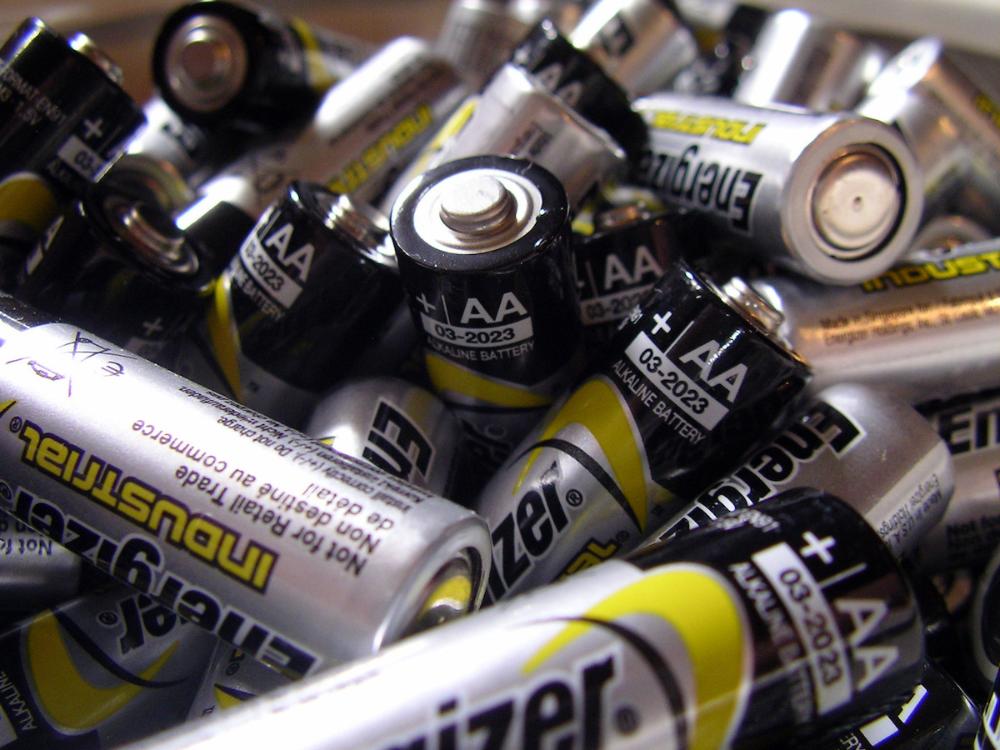
Rechargeable, car and button-cell (found in laser pens, watches, weighing scales etc.) batteries should always be recycled, as they contain heavy metals that can be harmful to the environment.
Mostsingle-use alkaline batteries (AA, AAA, 9V, D-Cell and others) on the other hand, can be safely disposed of in your regular trash (except in California where it’s illegal to throw away all types of batteries). However, it's always better to try to recycle them whenever you can.
Batteries are rarely recyclable curbside but many recycling facilities will take them.
The other main option for recycling batteries is store take-back programs.
Many home improvement or office supply stores have drop boxes where you can recycle your used batteries for free.
IKEA for example accepts the same types of batteries they sell, including AA, AAA and rechargeable batteries.
Best Buy stores have collection bins for any single-use and rechargeable batteries found in tech items like cameras, laptops, game consoles, mp3 players, phones and tablets.
There is alsoBattery solutions, a company that recycles every kind of battery in the continental U.S.
If you have less than 10 lbs of batteries you can order their iRecycle Kit 10 for $59.95, fill it with your batteries and ship it back to them for recycling (the initial cost covers return shipping).
Call2recycle.orgis North America’s largest rechargeable battery recycling program. They have thousands of drop-off locations across the U.S, including Lowe’s, Home Depot and Staples. Use their locator to find a drop-off location near you. You can also mail in your batteries.
Books, magazines & notebooks

Paperback books and magazines can be recycled in any paper recycling bin along with other paper items. For hardback books, you just need to remove the hard cover first.
Spiralbound notebooks can also be recycled with other paper items, and some recycling facilities will not even require you to remove the metal spiralling and other non-paper components. If the notebook has a plastic cover however, you will need to remove it.
Canned foods
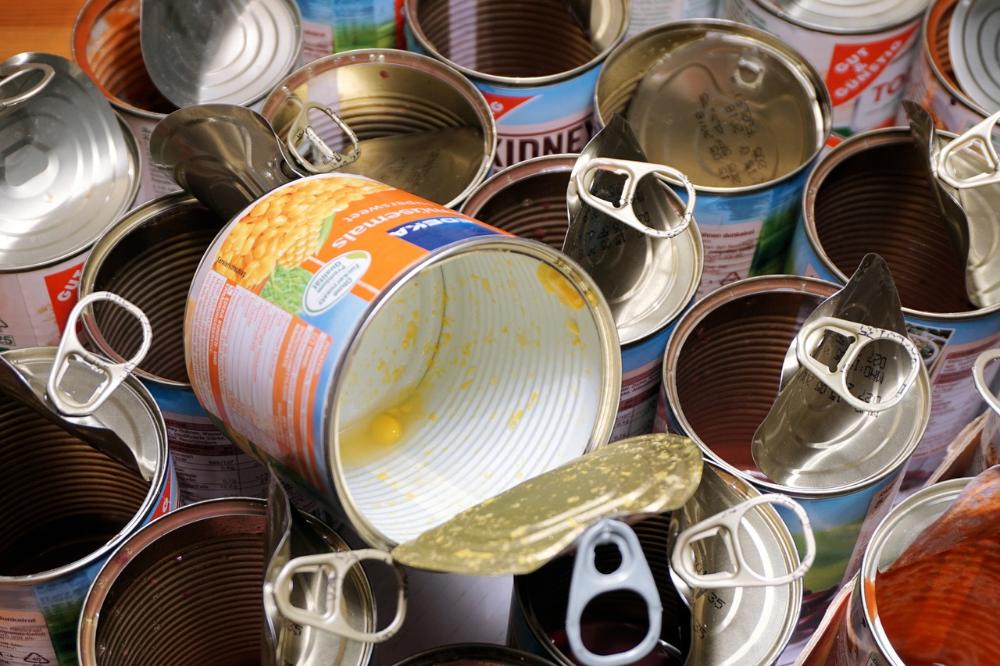
Canned goods, if they are kept in good condition, often have double the stated shelf life, which usually ranges from 1 – 4 years.
Therefore instead of dumping canned food that has exceeded the sell-by date, consider consuming it, giving it to a homeless person or feeding it to a hungry animal, as it will still probably be fit for eating.
Car seats
Children’s car seats won’t typically be accepted by curbside recycling programs, but you can visit this page on recycleyourcarseat.org to see if there are any programs in your state that recycle them. Some charge a small fee of $5 or $10 while others are free.
CDs, DVDs & Jewel Cases

CDs, DVDs, Blu-Rays & Jewel Cases are all recyclable, although it’s highly unlikely that your curbside program will take them.
Fortunately, stores like Target and Best Buy provide collection bins for some of these items.
Check out also the CD Recycling Centre of America to locate a recycling centre or store near you that can recycle your CDs, DVDs, Blu-Rays and jewel cases.
Clothing & hangers
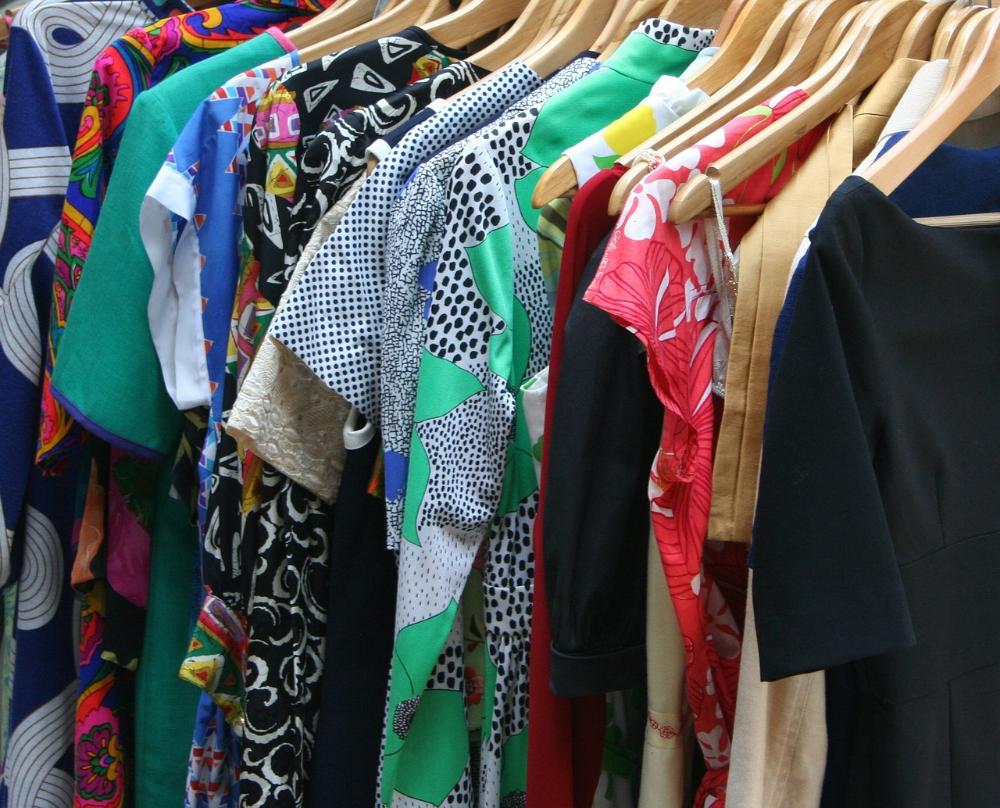
It’s a well known fact that 85% of all the unwanted clothing in the U.S ends up landfills and that’s partially because it’s not always that straightforward for most people to recycle clothing.
Often the best way to recycle clothing is to find a local drop-off bin. In a previous section of this article we discussed how the unwearable clothes dropped into these bins get turned into things like insulation, industrial rags and car seat filler by recycling companies
Clothes hangers are usually made from plastic, wood or metal wire (usually steel).
Metal hangers can be given to scrap recyclers and may also be accepted by some curbside recycling programs.
The most common hangers however are the plastic ones and it’s much rarer for these to be accepted by curbside programs.
This because they are much more difficult to recycle than the metal ones due to being made from a blend of different plastic resins. You may have no choice but to chuck them in the bin.
Electrical items
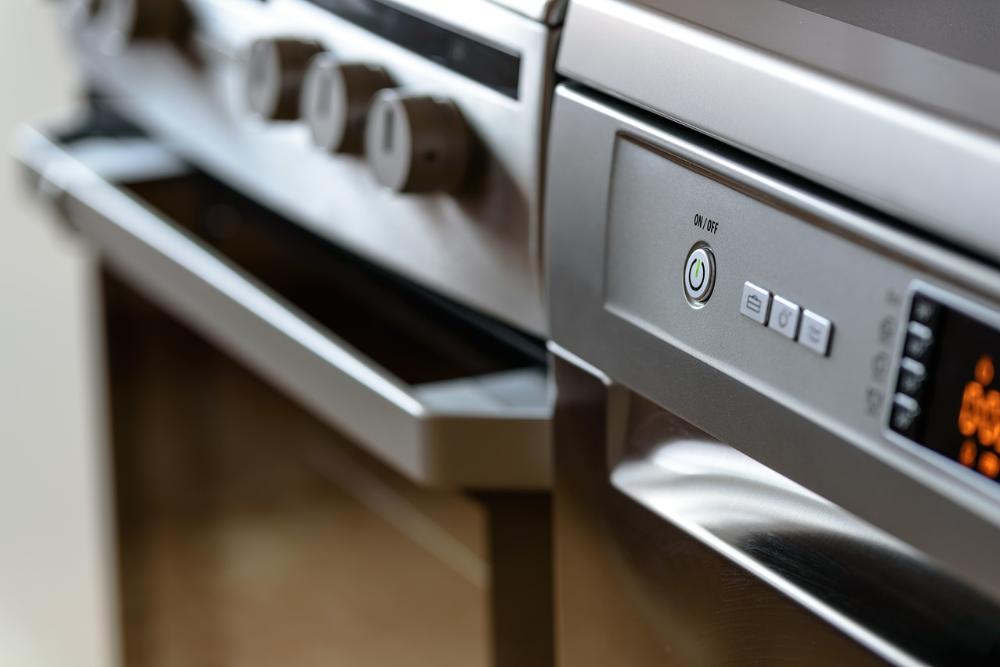
Pretty much all household electrical items, including air-conditioning units, washing machines, dryers, dishwashers, fridges, freezers, ovens, microwaves, toasters, blenders, food processors, kettles, irons, CD/DVD players, T.Vs, game consoles, vacuum cleaners, hair dryers, hair straighteners, curling irons, beard trimmers, electric toothbrushes, smoke alarms, torches, phones, laptops and so on, can be recycled.
The general rule is that any appliances that are more than 50% metal and that have a plug or a battery, can be recycled.
Fortunately, the average home appliance is about 75% steel, a valuable recyclable metal. There is valuable copper wiring in power cords and such goods can also contain gold, nickel, and other valuable metals.
To recycle electrical appliances you should normally be able to avail of any of the following three options; recycle through your local recycling centre, recycle curbside (usually small appliances only), or use a retailer take-back scheme.
In the U.S, stores like Target and Best Buy will take back electrical appliances, computers, cell phones, mp3 players and other gadgets for recycling.
In Europe, under the terms of the WEEE directive that was introduced back in 2007, retailers of electrical equipment are obliged to run store take-back schemes or provide collection services to take back appliances once they’ve reached the end of their lifecycle.
You’ll need to check with the retailer that you purchased the appliance from to see what options are available to you.
Local scrap recyclers may also be interested in some of your broken electrical appliances, and you could potentially make some extra cash this way too.
Fire extinguishers
.jpg)
The pressurized vessels of fire extinguishers are usually made from aluminium alloy and the valves from steel - both highly recyclable metals.
However, fire extinguishers are classified as hazardous household waste so it’s dangerous to just put them in your normal recycling bin.
Your best bet will be to contact your local hazardous household waste (HHW) recycling program. These are the same programs through which you can recycle aerosol cans, propane tanks and other hazardous household items.
If you live in a bigger city you may also have a permanent recycling facility that will accept hazardous household waste year round.
If you don’t have a facility or program that will accept fire extinguishers, you can depressurize the cylinder yourself, unscrew the head and take the empty canister to a scrap metal recycler.
However, if you don’t know what you’re doing here you should definitely seek the help of the local fire department or a professional, as you could potentially injure yourself.
Footwear
.jpg)
Nike’s Reuse-a-Shoe program lets you recycle any brand of athletic shoes, but sandals, dress shoes, boots and shoes with metal cleats or spikes are not accepted.
You can drop your shoes off at most Nike retail stores. Since not all stores are participating in the program, you should contact the store before visiting. Go to this page to locate Nike retail stores near you.
Asics is another brand that’s involved in recycling shoes. They’ve partnered with I:CO, a textile recycling company that recycles unwanted clothes and shoes.
You can drop off shoes from any brand for recycling at participating Asics stores and you’ll receive a reward coupon for your next in-store Asics purchase.
Furniture

Household furniture comes in many forms including bed frames, chairs, tables, stools, wardrobes, sofas, couches, dressers, filing cabinets, bedside lockers and more.
Most furniture is predominantly made from wood, metal or plastic, so it can usually be recycled, but doing so can prove difficult in practice.
For furniture that is predominantly made of metal you can contact a local scrap dealer to see if they’ll pick it up for recycling. You can also try your local recycling centre.
Upholstered furniture like sofas, couches, armchairs the like is probably best recycled through your municipal program. Many communities have a few bulk waste collection days scheduled each year.
Plastic chairs, tables and other plastic furniture are often recyclable as well. If the furniture is made from virgin polypropylene plastic (#5), it is technically recyclable, but curbside collection probably won’t be viable. You can try to find a recycling facility that handles #5 plastics instead.
Plastic furniture may also be made from recycled HDPE (#2), which is not recyclable since the plastic has already been recycled once (likely from smaller HDPE plastic items like milk jugs), and can’t be recycled again.
Wooden furniture may be recycled if it’s made entirely from natural wood, although this is normally only the case for very high-end or old furniture.
Most cheap furniture nowadays is made from chipboard, particleboard or treated wood, which unfortunately can’t be recycled or composted due to the toxic glues, preservatives, paint and other chemicals it contains.
Garden hoses
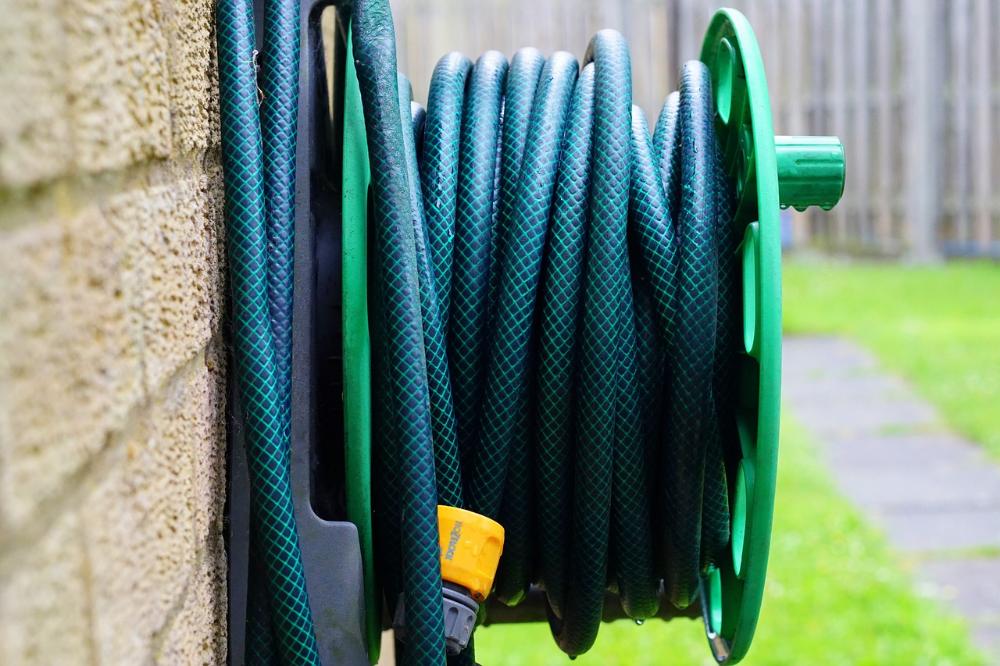
Garden hoses are normally made from PVC (#3), polyurethane (#7) or synthetic rubber (especially the more expensive hoses). Unfortunately, hoses made from any of these materials are not recyclable, as they would just get tangled in the machinery at recycling facilities.
It's actually a general rule that things that tangle easily cannot be recycled; earphone cables, electric cords, Christmas lights, chains, ropes, wires and so on. If you're trying to get rid of a garden hose, you'll probably have to dump it.
Glassware

Glass objectsincluding glass ornaments, drinking glasses, wine glasses, Pyrex, mirrors and so on are not usually accepted by recyclers along with container/soda lime glass (the type used in regular glass bottles and jars).
This is because the glass used in these objects often contains additives like borosilicate, which change the melting point and chemical composition of the glass.
If this type of glass is recycled along with regular container glass it can result in an inferior final product with imperfections that is easily broken.
If treated glass is accepted, it will be recycled separately to regular glass jars and bottles, but only a minority of recycling centres and programs will accept it.
Kitchenware

Ceramic or china crockery is generally not recyclable, so if you can’t find a way to re-purpose it, you’ll have to dispose of it in the trash.
Cutlery (flatware) like spoons, knives, forks and other eating utensils can usually be recycled, as these items are usually made from recyclable metals like stainless steel or aluminium. Scrap metal recyclers and many recycling centres will accept them.
Plastic cutlery is accepted by some recycling programs, but you’ll have to check with your local solid waste management company.
Metal cooking utensils like whisks, ladles, spatulas, bowls, serving spoons, colanders and more can be recycled in the same manner as cutlery. Even kitchen sinks & faucets can be brought to a scrapyard, as these normally made from stainless or galvanized steel.
Metal pots and pans are often recyclable too, as they are normally made from stainless steel, cast iron or aluminium. If you can’t recycle them curbside, you can bring them to your local scrap recycler.
You can use the iScrap app to find scrap metal recycling facilities in your area. Some dealers differentiate between ferrous and non-ferrous metals – you can test your pot with a magnet.
Unfortunately, the pots and pans that use Teflon or some other non-stick coating usually won’t be accepted by handlers, as most are unable or unwilling to remove the coating. Some recycling facilities do accept non-stick cookware however, so it’s always worth checking.
Leather
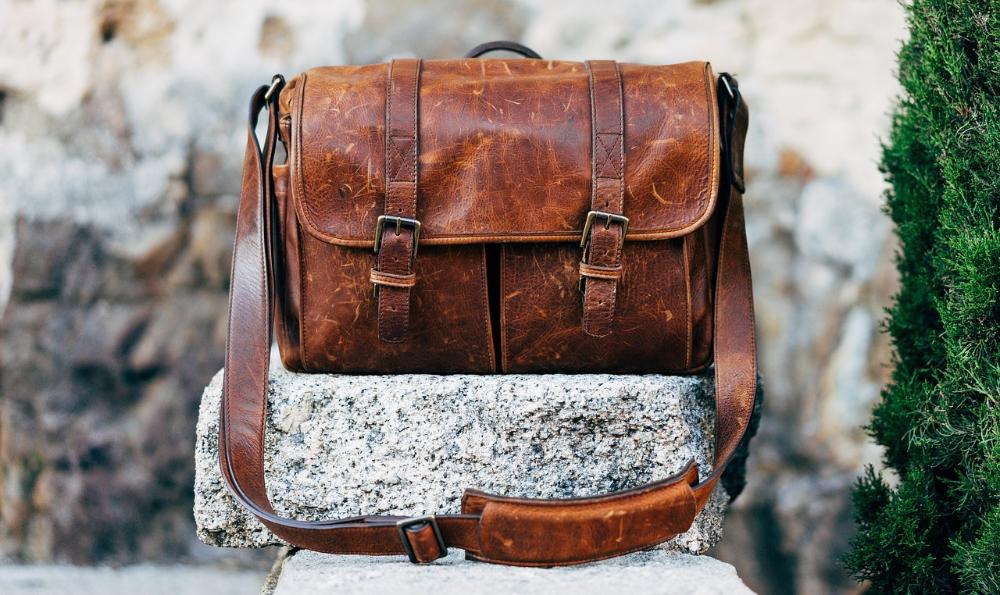
Leather goods are not recyclable. However, leather is an organic material that rots, so you can cut out any non-leather components (buckles, zippers, grommets, eyelets, clips, metal rings etc.) from any leather item that you’re trying to recycle and bury it somewhere for it to decompose.
Lightbulbs

When it comes to lightbulbs, it's particularly important that you recycle the compact fluorescent bulbs (CFL), as well as fluorescent tube lights.
This is because they contain a very small amount (typically 1-4 mg) of Mercury, with the exact amount varying from manufacturer to manufacturer. In seven states you are legally required to recycle them.
LED, halogen and incandescent bulbs can be legally disposed of in your regular trash, but it’s still better to recycle them whenever possible.
Although you probably won't be able to recycle lightbulbs curbside, there will normally be plenty of other recycling options for them in your community.
CFL bulbs are the easiest kind to recycle, with the option to do so at many recycling facilities.
Home Depot, IKEA, Lowe’s, Ace Hardware and other home improvement stores also have in-store collection bins in many communities for recycling used CFL and other lightbulbs - you’ll have to check what kinds of bulbs each program accepts.
Some companies have mail-in programs where they send you a pre-paid recycling box to fill with bulbs for recycling. These are often the best way to recycle LED bulbs, although they will usually accept other types of bulbs too.
Incandescent bulbs are the most difficult kind of bulb to recycle and there are very few, if any programs that recycle them.
Mattresses & yoga mats
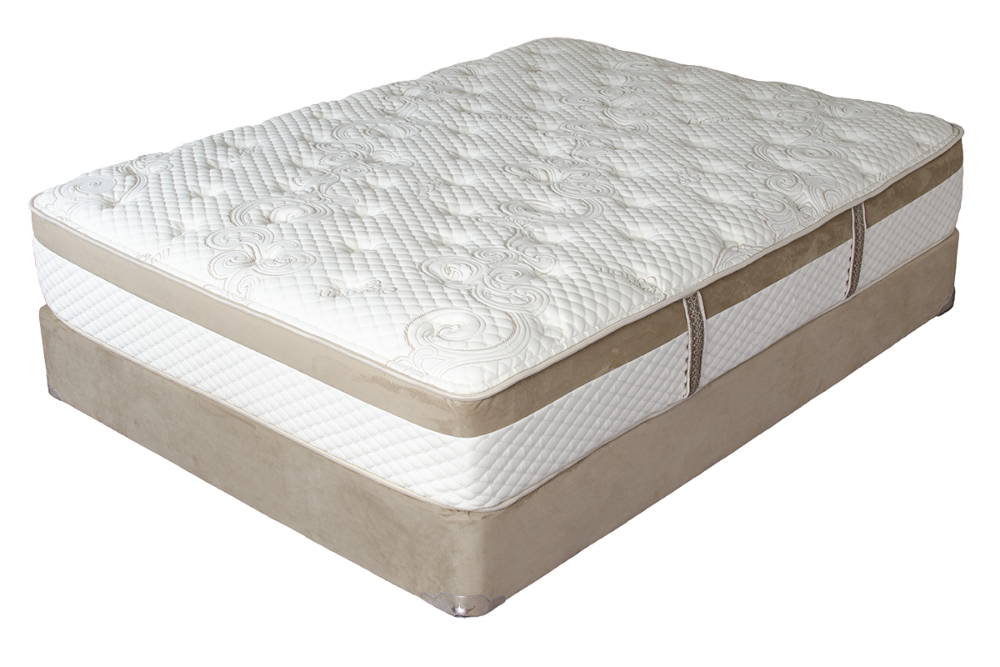
Even though about 80% of the materials in mattresses are recyclable, they can still be tricky things to recycle. Sadly, 50,000 of them end up in landfills every single day in the U.S alone.
If your local recycling program schedules bulk waste collection days, you can check to see if they accept mattresses. Another option is to try contacting a local hauling company that will bring it away to be recycled.
Ikea also recycles returned mattresses for a fee of approximately $25 (except in Canada where the service is free), as part of their national mattress recycling program.
Most run-of-the-mill yoga mats are made of toxic PVC (#3), which makes them difficult to recycle. When they end up in landfills they take forever to decompose and leach toxic heavy metals like lead and cadmium into the ground.
Luckily however, two companies that can recycle yoga mats areJadeYoga(has yoga studios in 19 states) and Sanuk, a California-based footwear company that produces sandals from yoga mats.
If your yoga mat is made of rubber you can check to see if your local recycling facility will accept rubber items.
Medication

Medicines are not recyclable but there is a correct and responsible way to dispose of them.
Unused, unopened or expired medication can often be returned to the pharmacies where purchased through take-back or mail-back programs. These programs may also be run by government agencies and community groups.
If you have to dispose of medication yourself, the correct method is to mix it with an unpalatable substance like used coffee grounds, dirt, sawdust or cat litter inside a tightly sealed plastic bag that you throw out in with the trash.
In the past it was recommended to flush many medications down the toilet but now this is only advocated for very dangerous medicines, which could harm or kill people that accidentally use them. The FDA provides a list of medicines that should be flushed for disposal.
The small containers that pills often come in are usually made from recyclable plastics like PET (#1), HDPE (#2) and polypropylene (#5), so you can at least try recycling these. The opaque white bottles are typically #1 and #2 plastic, while the clear or coloured ones are likely to be #5.
Packaging materials

If you’ve been ordering a lot of stuff online lately you probably have a lot of packaging materials to get rid of. The cardboard boxes are of course recyclable, but what about the other packing materials?
Packing peanuts are normally made of non-biodegradable EPS (expanded polystyrene) and are not usually accepted by local handlers, but stores of courier companies like UPS might take them from you.
There are a few EPS recyclers but they may only accept a minimum quantity of peanuts for recycling. You’ll need to call and confirm if this is the case.
Bubble wrap and air pillows are made from #4 LDPE (low density polyethylene) film and can be recycled along with plastic bags at recycling centres and local drop-off points at supermarkets and the like.
You can also enter your ZIP code on plasticfilmrecycling.org to find drop-off locations for plastic bag and film recycling in the U.S. and Canada.
Also, The Sealed Air Corporation, which invented bubble wrap in 1960, also accepts prepaid mail-ins of most of its packaging products that couldn’t be re-used.
Styrofoam packingblocks are not very recyclable unfortunately, although some municipalities do accept them. If you can’t recycle styrofoam in your municipality, check out epspacking.org to locate drop-off point further afield.
Paint cans

Empty steel paint cans are often recyclable. You may be able to recycle them through your curbside program but if not you can also try your local recycling facility.
But what if you have cans with leftover paint still in them?
For that there’s paintcare.org, which has 1,750 drop-off sites (77% of which are paint retailers) in nine U.S states.
They will take your unwanted, leftover house paints, primers, stains, sealers and clear coatings (shellac, varnish etc.) in their original cans (must be less than 5 gallons) with sealed lids.
You can use the PaintCare Site Locator to find a place to drop-off your leftover paint. They also have a pickup service if you have 200 gallons or more.
Personal care items
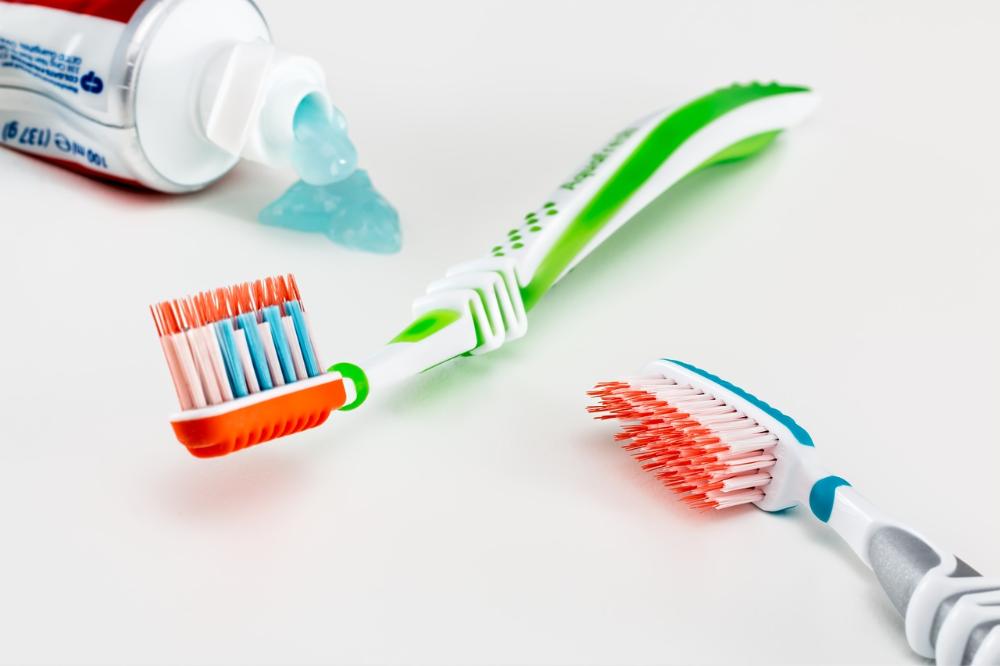
Aerosol cans of all kinds are either made of aluminium (40%) or tinplated steel (60%), which are both high-value recyclable metals.
The cans can therefore be recycled after emptying them completely and removing the plastic cap (which can be recycled separately).
Sometimes aerosol cans are recycled along with other metal cans, while other times they must be recycled separately as hazardous household waste.
If you can’t recycle them through your household collection scheme, try your local recycling centre.
Anti-perspirant and deodorant sticks are often not recyclable because the dial on the bottom is made from a different plastic to the tube, although Tom’s of Maine makes a stick composed only of polypropylene (#5).
Most non-electrical personal care items can be recycled by mailing them to Terracycle inside a Personal Care Accessories Zero Waste Box.
Inside this box you can put brushes combs, picks, clips, hairbands, headwraps, bobby pins, hair ties, scrunchies, shampoo & conditioner bottles, detangler bottles, gel packaging, non pressurized hairspray bottles, wax jars, pomade tins, hair dye packaging and blow dryer attachments like combs and diffusers.
The plastic containers of liquid hand soap (minus the pump mechanism), shower gel, shampoo, conditioner, body wash, body lotion, hair gel and so on, can usually be recycled curbside or at a local facility, as they are made from recyclable plastics like HDPE (#2) and PP (#5).
Makeup is often full of toxic chemicals and is bad the environment, but unfortunately, options for recycling it are limited.
However, many retail stores will take back empty cosmetic containers and tubes, so check with your local retailer. Also many cosmetics come in glass or polypropylene (#5) containers, and these can be recycled through the usual recycling channels.
Toothpaste tubes, toothbrushes and other oral hygiene items can be tricky to recycle but it is still possible.
Colgate and U.S. recycling company Terracycle have partnered to create the Colgate Oral Care Recycling Program, which makes it easy to recycle toothbrushes, toothpaste tubes, dental floss containers and all associated packaging. Electric or battery-operated toothbrushes are not recyclable through the program.
Once you’ve signed up through the website you can download a prepaid UPS shipping label to mail in your oral care items and packaging for free.
Synthetic sponges and wipes can’t be recycled, although sea sponges and natural sponges like loofahs are biodegradable and compostable.
Plant pots

Plant pots can be made from many different materials including plastic, cement, ceramic, terracotta and so on.
The ones made from ceramic or terracotta are not recyclable. The cement ones may be recyclable if your local recycling centre handles cement.
The plastic ones are usually made from HDPE (#2) or polypropylene (#5) and may be recyclable at your local recycling facility - you’ll need to check this. Also, some curbside programs do accept plastic plant pots but these are rare.
Printer cartridges
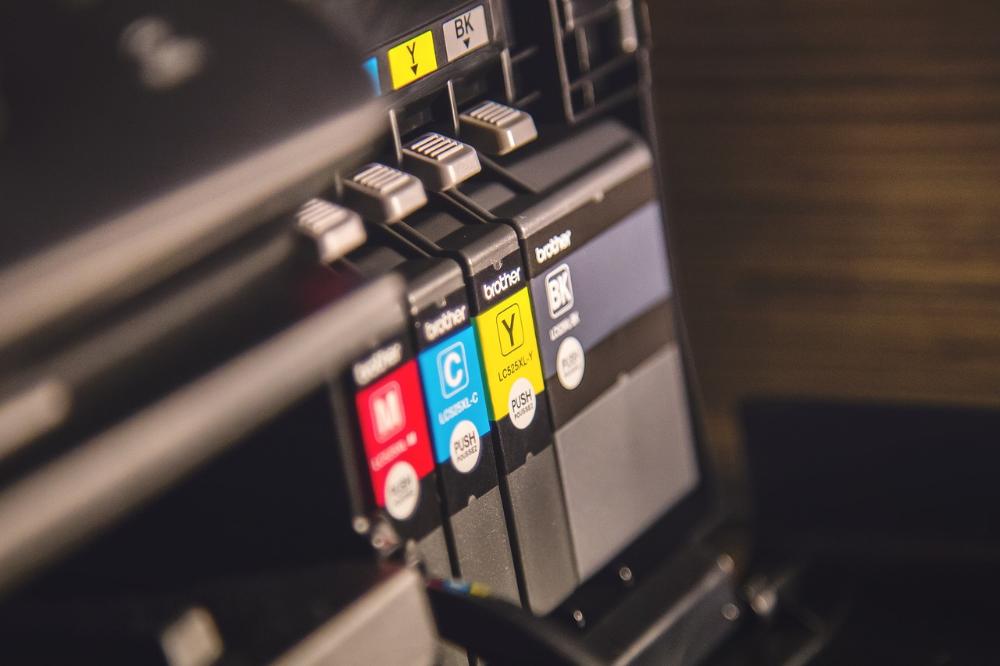
A staggering 350 million of these end up landfills every year in the U.S alone, potentially leaking harmful chemicals and heavy metals into the surrounding environment.
Around 50% of toner cartridges and 70% of ink cartridges are still not recycled or safely disposed of.
Despite this sad state of affairs, printer cartridges can be recycled at many community recycling centres, some of which will offer payment in return.
Another option is to recycle them at retail stores like Walmart, Staples, Best Buy, OfficeMax, OfficeDepot and the like. You can often receive store credits or reward points for each used cartridge that you bring in.
All that said, empty printer cartridges are perhaps best not recycled at all because of how valuable they are.
Name brand laser printer cartridges like HP or Canon can fetch up to $40 from cartridge buy-back sites, while empty inkjet printer cartridges will usually net you anywhere from $0.25 to $4.
You can ship your empty cartridges to companies like eCycle Group and Toner Buyer, which both cover shipping costs.
Many people have also had success selling empty printer cartridges on eBay and other ecommerce platforms.
Sports equipment

Sports equipment like tennis rackets, golf clubs, footballs, basketballs, baseballs, fishing rods, frisbees, free weights, skateboards, helmets, goggles and so on can be difficult to recycle, as these are usually composite items.
However, Terracycle can send you a Sporting Goods Zero Waste Box to recycle virtually any item, clothing or equipment used in sport.
For recycling tennis balls specifically, there’s recycleballs.org, which separates the rubber component of the balls from the felt and turns it into rubber crumb, which is then turned into new tennis courts, rubber mulch and a variety of other green products.
If you have 100+ tennis balls, you can use their Quicklabel Program to mail in the balls for recycling. They’ll e-mail you an instant UPS shipping label and they ask for a $15 donation to partially cover the shipping cost.
Textiles

Carpets & rugs are often recyclable at facilities that accept carpets, rugs and other textiles. The best way to began your search for a local recycling solution is contact your local carpet dealer.
There’s also C.A.R.E (Carpet America Recovery Effort), a non-profit that is trying to develop a carpet recycling infrastructure across the U.S.
The network is still in its infancy and homeowners currently have to pay 5 to 25 cents per pound of carpet to recycle it, but costs should drop as the network expands.
Curtains can be made from a wide variety of different fabrics including cotton, silk, voile, brocade, polyester, lace, rayon, acryclic, velvet and so on.
It will be difficult for you to recycle curtains unless you’re fortunate enough to live in a city that has a curbside recycling program for textiles like curtains, towels, pillow cases, sheets and other related items.
Curtain rods are made from various metals, wood and plastic. The metal ones can be added to the metal collection bin at your local recycling centre or given to a local scrap dealer.
Shower curtains are normally made from PVC (#3), which makes them very difficult to recycle. However, if your shower curtain is made from a natural material like hemp it will be biodegradable.
Pillows & duvets are comprised of recyclable materials like textiles, foam and fibres, but in spite of this reality they are generally not recyclable through the usual channels.
If you happen to live in France however, there is a furniture-and mattress-recycling non-profit called Eco Mobilier that started recycling duvets and pillows in October 2018.
Toys
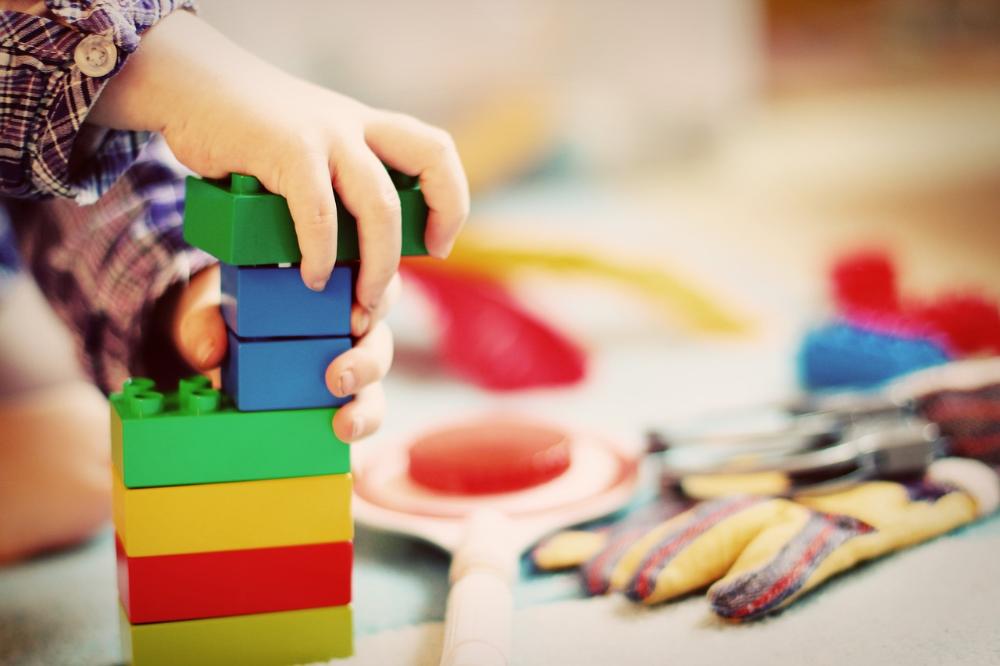
Children’s toys are made from a wide variety of materials including wood, metals, plastic, fabrics and so on. Some toys have electronic components to further complicate the picture.
Toys are generally quite difficult to recycle and most municipal recycling programs won’t accept them.
For plastic toys, you can use Earth911’s locator to find recycling facilities that accept the types of plastics that your toys are made from.
Toys that are mostly made from metal may be recyclable by taking them to a scrap recycler.
Electronic toys may be recyclable at facilities that accept most kinds of electrical items.
Wooden toys can be composted if they’re made from natural wood, but if the wood has been painted or treated you will probably have to dump it.
For more complex toys you can always try to break them down into their component parts and see what you have that is recyclable.
Terracycle also comes to the rescue here again, with its Toys Zero Waste Box,which you can ship back to them after downloading the UPS shipping label and filling it with toys and toy-related items.
Items that are accepted include cards, dices, board games, handheld electronic games, remote-controlled vehicles, baby toys, electronic stuffed animals, action figures, puzzle pieces, books with sound and the like.
Vehicles
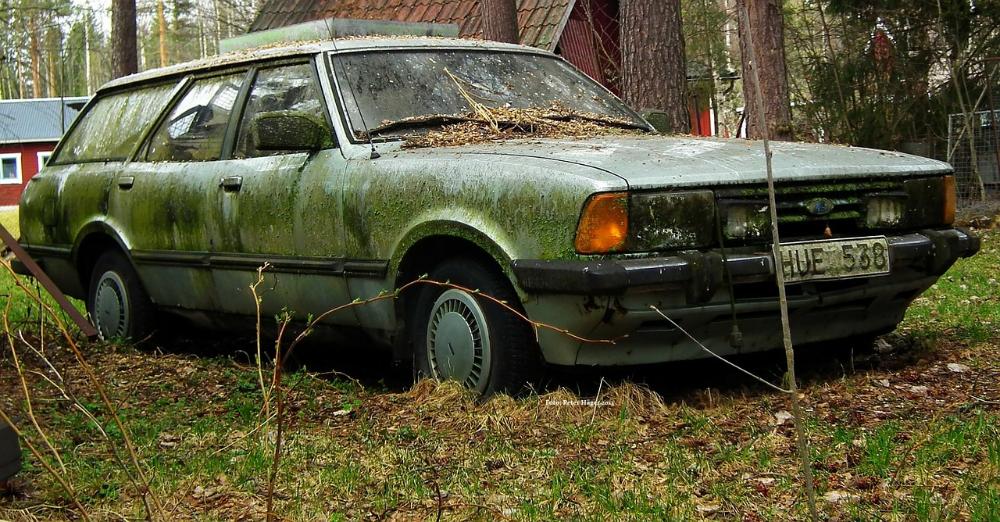
Vehicles like cars, R.Vs, motorcycles, boats, jet skis, trailers and many others can be recycled by contacting local junk yards in your area.
You can also try Junk My Car, a U.S-based service that will haul away your old clunker and pay you for it. You can find out how much your car is worth on the website but most are valued at several hundred bucks.
Yoghurt cups

Most yoghurt cups are made of polypropylene plastic (#5) or polystyrene (#6), which are both technically recyclable, but in practice they can both be very difficult to recycle.
The problem is that most curbside programs won’t accept these plastics because of their low recyclable value, and also because China almost completely stopped importing plastics (mixed paper imports were also cut by a third) from the western world in January 18.
You will need to check with your local recycling options to see if they accept these plastics. This map provided by recyclemoreplastic.org pinpoints the programs across the country that accept polypropylene.
Also, Preserve’s Gimme5 Recycling Takeback Program has made it easy to recycle items made from polypropylene. Preserve has partnered with Whole Foods market to provide recycling drop-off locations.
Writing implements

Pens, pencils, markers and other writing implements are virtually impossible to recycle in the standard fashion.
However, you can order a Pens, Pencils and Markers Zero Waste Box from Terracycle and ship it back to them filled with your used pens, pen caps, mechanical pencils, markers, marker caps, permanent markers and permanent marker caps. Paintbrushes, colouring pencils and wooden pencils are not accepted.
Crayons can be recycled through the National Crayon Recycle Programwith or without labels. You’ll have to cover the shipping costs yourself.
Some general tips for recycling
- Make sure whenever recycling food packaging that it’s reasonably clean, dry and free of any residues. For example, cardboard pizza boxes may be unrecyclable if pieces of food are still stuck to them or if they are covered with grease. Although it may not always be required, it’s a good idea to give bottles, jars and cans a quick rinse under the tap before recycling them.
- Items are generally best kept loose and shouldn't be bundled or placed together inside a bag when you go to recycle them.
- To determine if a plastic item is recyclable, you need to first check the resin identification code (RIC), which is the number found inside the Mobius loop recycling symbol (the triangular symbol comprised of three arrows).
- Plastics are numbered from 1 to 7 as follows: #1 – PET (polyethylene terephthalate), #2 – HDPE (high density polyethylene), #3 – PVC (polyvinyl chloride), #4 – LDPE (low density polyethylene), #5 – PP (polypropylene), #6 –PS (polystyrene) and #7 – all other plastics. Plastics #1 and #2 are widely accepted by recycling programs but the other types are more hit and miss. Plastics #3, #6 and #7 are particularly difficult to recycle. For more on the different kinds of plastics see this article.
- Not everything is recyclable so don't beat yourself up if you can't figure out a way to recycle something.
Other useful articles on recycling
Top 18 Things You Should Not Recycle Curbside by GreenBlue
What Can Be Recycled? A List Of 200+ Items by Personal Creations
What to do with your pets?
So far we’ve only discussed what you should do with your non-living possessions before you set off on your travels. But what should you do with the living, breathing things that you own, like say, your pets?
Unfortunately, pets and travel don’t go very well together.
Travel is already challenging enough as it is without an animal companion to worry about and take care of. Travel is also very stressful for the pets themselves, especially if they are not used to it.
Moreover, it’s usually only small cats and dogs that are allowed inside airplane cabins, so if you have pets that don’t meet the strict criteria for travelling in the cabin you would have to put them inside the cargo hold inside.
But larger pets that are put in the pressurized cargo hold underneath the cabin are not only subjected to extreme emotional suffering, but are also at significant risk of being killed, lost or injured.
Extreme temperatures, fluctuating air pressure, inadequate ventilation and rough handling can all lead to the deaths of animals that are transported as checked luggage. The exact cause of death in the majority of cases is heart failure.
Flying is particularly dangerous for the flat-faced brachycephalic dog breeds like Pugs, British Bulldogs, Boxers, Bull Mastiffs, Chow chows, Chihuahuas, King Charles Spaniels, English Toy Spaniels and Lhasa Apsos, as their short noses can leave them vulnerable to oxygen depravation and heat stroke.
Brachycephalic cats like those of Persian, Burmese and Himalayan breeds are also at greater risk than other breeds.
Travelling with pets also means extra airline fees and these can often be higher than the cost of the flight itself. Expect to pay anywhere from $75 to $100 with most airlines for the privilege of bringing your pet inside the cabin.
You may have to pay extra fees for pets on other forms of transportation too, and certain buses, trains and boats may not even allow you to travel with your pets.
Most cruise lines do not permit pets and in the U.S for example, only certain pets are allowed on certain Amtrak trains. Greyhound buses prohibit all animals (even from travelling in the luggage hold) except for certified service dogs. In Europe however, trains are more lenient with pets.
Another issue when it comes to travelling with pets is that many hotels are not pet-friendly and pets are often not allowed at parks, beaches and other tourist attractions.
For all these reasons you’re probably better off selling your pet(s) or having them adopted by a new owner before you hit the road.
Unfortunately it’s prohibited to sell pets on many of the biggest online marketplaces like Craigslist, Facebook Marketplace and on many local buy-and-sell apps too.
However Gumtree is one notable exception to this, with a whole category on its website devoted to pets for sale. Gumtree does however charge a nominal fee for pet listings.
And although selling pets on Craiglist is prohibited, the site does allow you to list a pet for “re-homing”, where you can charge a small re-homing fee of say $50 to the person that is interested in adopting your pet.
If you happen to live in the UK, Pets4homes is the most popular free pet classifieds site for advertising pets for sale and for adoption. The site receives over 4 million monthly visits and you can post totally free pet listings here with as many photos you like.
You can also check out Hoobly Classifieds, a free classified ads platform with apps for Android and iOS that has a category for advertising pets for sale or adoption.
If you're going away for a shorter period and you just want to find a temporary carer for your pet, a great option is to find a housesitter to look after both your pets and your property while you're away.
If you don't have your own property, there are other options like in-home pet boarding, where your pet stays at the pet sitter's home and traditional boarding, where you place your pet in boarding kennels or catteries while you're away.
Another possibility when you're not leaving for too long would be to place your pets in the custody of a responsible neighbour or relative that is happy to look after them for you.
See this article for some tips on keeping pets while you're away.
Conclusion
Figuring out what to do with all the stuff you’ve accrued over the years before embarking on your big trip might seem like a Sisyphean task when you first begin to confront it.
Even the most virtuous among us might be tempted to just hurl everything we own into the nearest garbage truck and be done with it.
But we’ve shown you in this article that there are so many websites, mobile apps, non-profits, for-profits, facilities and amenities out there that make it easier for you to do the right thing with each item you own.
You have access to an abundance of resources to help you hold onto, sell, donate, rent out, and recycle most of the things that you own and by properly utilizing these resources you will be doing your bit for the environment and for your community, all while managing to raise a bit of extra cash to help fund your upcoming trip.
If you enjoyed this article, please share it with other travellers. Have you ever purged your life of almost everything you owned before? We’d love you to leave us comment below telling us about how you managed to get rid of all your possessions.
JOIN OUR LIST
SUPPORT US
FOLLOW US
ABOUT US
Our names are Eoghan and Jili and we hail from Ireland and India respectively.
We are two ardent shoestring budget adventure travellers and have been travelling throughout Asia continuously for the past few years.
Having accrued such a wealth of stories and knowledge from our extraordinary and transformative journey, our mission is now to share everything we've experienced and all of the lessons we've learned with our readers.
Do make sure to subscribe above in order to receive our free e-mail updates and exclusive travel tips & hints. If you would like to learn more about our story, philosophy and mission, please visit our about page.
Never stop travelling!
FOLLOW US ON FACEBOOK
FOLLOW US ON PINTEREST
-lw-scaled.png.png)


